



“a symbol of indeterminate meaning, floating/rotating into the empty white WAG room with no viewers” Bill Miller
Widget Art Gallery. July 17th – August 17th 2013.
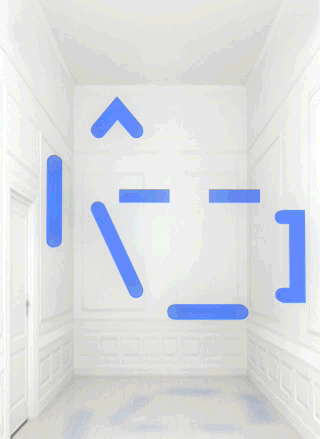
Chiara Passa’s Widget Art Gallery (WAG) has been serving art online since 2009. Named for the ability to install the contents of its web pages as a Mac OS X “dashboard widget” or iOS icon, it presents virtual art objects against a standard backdrop or in a standard virtual environment that looks like a white-painted townhouse room repurposed as a small gallery space in an exclusive part of town.
The instructions for using the WAG are Apple hardware-centric, and as I don’t have an Apple device I had to cheat and view it on my GNU/Linux desktop. Digital art’s medium specificity consists in part of its reliance on the facilities of particular hardware and operating systems. This can be exclusive, not everyone owns Apple hardware, but it can also be realistic, Apple’s hardware currently defines computing in the popular imagination.
The image of the gallery in the widget, like the image of a leather desk organizer or a wire mesh microphone in an mobile app, or the very idea of “the desktop” in a desktop GUI, it is a skeuomorph. It is a non-functioning symbolic form that cues the viewer in to the affordances that the experience of the software offers. Like the white cube of a real art gallery, it frames the experience of looking at the artwork and emphasises its seriousness, value, and singularity.
From July to August 2013 the work inhabiting this virtual space is Bill Miller’s “A Symbol“. The titular icon is a composition of soft light blue graphic elements that look like ASCII art that are not aligned to a teletype grid. Or like a misaligned LED matrix. It evokes the art of early military computer games, or the more complex emoticons, or maybe a lamp or a teapot. It rotates, blurs, flickers and stops, glitching and returning.
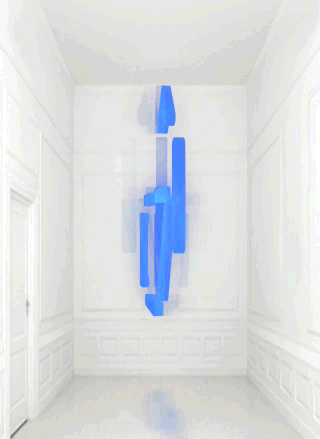
Widget Art Gallery installations are presented as animated GIFs, but they are different from the usual hilarious recuperations of Compuserve’s low-bandwidth image format in their lack of all-overness and of mass media appropriation. Animated GIFs are often glitched, but with “A Symbol” it is the object depicted in the animated image that is glitching, not the image itself.
The rotating symbol used to be a staple of broadcast television identities. The flickering or glitching symbol signifies signal hacking, technical difficulties, or coming into or out of being by teleportation or rezzing. Popular culture reactions to technology emphasize its flaws and failures to make its smooth surfaces tractable to the imagination. But this symbol remains opaque and self-assured, always returning to its original state.
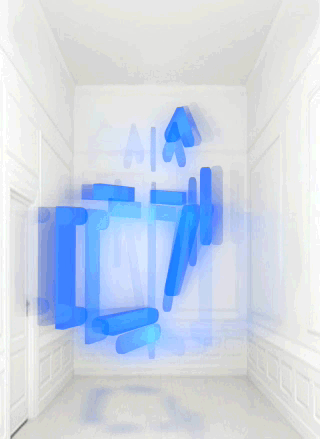
The symbol’s reflection on the floor pushes it into and anchors it in the imaginary space of the gallery. Like drop shadows in graphic design or the handling of shadows and highlights in paintings it is a visual spatial strategy to make its subject seem more real and in the same space as the viewer. The rhythm and pauses in its rotation, especially the pauses, make it seem intentional and sculptural, they give it a solidity in time as well as space.
The accessibility and framing of the Widget Art Gallery mean that “A Symbol” can travel with and be accessed by its audience over time in a variety of settings, making it even more a reflection of their lives. “A Symbol” is retro digital but with a contemporary electroluminescent aesthetic glow like a Tron Legacy costume or an Android startup screen, militaristic but emotive, hard-edged but glitching, opaque yet evocative. It is a sign of the times.
Richard Stallman[1] the outspoken promoter for the Free Software movement, hates Facebook with a passion. He proposes that we should all leave Facebook and either find or build our own alternatives. The evidence offered by Stallman’s and the Electronic Frontier Foundation’s (EFF), who have been fighting for Internet freedoms since the 90s [2] shows how necessary it is that we understand and are more pro-active in managing the personal data that we give away through our online activities.
When we subscribe to Web 2.0 platforms such as Facebook we are at the mercy of the data brokers. These companies trade in people’s personal data; information which is aggregated by monitoring user actions and interactions across social media. This information can include “names, addresses, phone numbers, details of shopping habits, and personal data such as whether someone owns cats or is divorced.”[3] Fast moving developments in social media, make it difficult to keep up with the effects and consequences of these platforms. This is why the work of groups such as Commodify Inc. is so valuable. They bring imaginative and critical attention to the situation, sharing their knowledge of these daily networked complexities and correcting what they see as its negative effects.
Commodify Inc. is an artist-run Internet startup producing projects to help individuals capitalize on their online monetary potential. Their intention is to correct the imbalance of power in markets where users have no control over the transactions made with their personal data. They have completed various artistic projects and interventions on social media like, Fame Game, Give Me My Data, and Web 2.0 Suicide Machine. The co-founders are Birgit Bachler, Walter Langelaar, Owen Mundy, Tim Schwartz, with additional contributors Joelle Dietrick and Steven Alvarado.
Their new project Commodify.Us, was initiated when Owen Mundy and Tim Schwartz were invited by moddr_ to a residency in their lab in the summer of 2012 – when they were still a part of the WORM collective in Rotterdam. They worked on an initial idea that would succeed previous experiences of their already well-known and respected projects.
Commodify.Us is currently in beta phase. It promises to provide a platform for people to regain control over the commercial exploitation of their own personal data.
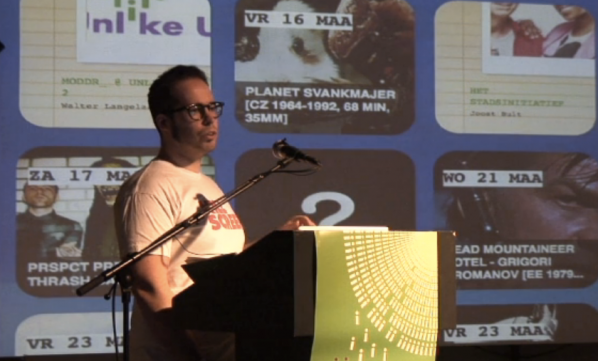
Intrigued by this project I contacted one of the co-founders, Walter Langelaar via email and asked him a few questions about this new platform.
Marc Garrett: Commodify.Us is for people to have greater control over their data. And it works when users export their data from social media websites and upload it to your platform. How will these users gain more control over their data and why is this important?
Walter Langelaar: Commodify.Us provides a platform for you to regain control over the commercial exploitation of your personal data. After exporting your profile data from social media websites and uploading the data to Commodify.Us, you can directly get in contact with interested buyers. On the importance for users I would say that it’s part raising awareness surrounding the monetization of profile data, and part creating a platform where people might work out and discuss how to do this themselves.
MG: It proposes to re-imagine the potential of relational data, creating a casting agency for virtual personas. I’m wondering what this may look like?
WL: We were too. In an early stage of the project we played with the idea that peoples’ various profiles could function like that within an agency; a client would ask for a specific set of qualities and/or characteristics within a set of profiles, and we could provide for this based on the uploads and their licensing options as set by the user. In the end we abandoned this idea for clarity.
MG: Commodify.Us offers people the opportunity to be part of an economy where interested buyers will pay to use the data supplied, unlike existing social media websites. How does this work?
WL: We are gearing up for a launch where the main goal will be to get a critical mass of around, a 1000 profiles. We anticipate that only with this kind of mass or volume will our initiative take hold with the potential buyers we have in mind, and the same goes for the more creative projects that could use the (open) data. Regarding the open profile data and otherwise licensed profiles that allow for reuse, we are researching the idea of ‘Fair Data’ (as in Fair Trade) and how to implement this as a profitable protocol for the end-user.

“Net activists construct tools whose intervention potential can be initiated by users under net conditions. These tools enable activists to develop new strategies in the data space of the Internet because they offer new means: New means afford new ends.”[4] (Dreher)
In his publication Networks Without a Cause: A Critique of Social Media, Geert Lovink lays down the gauntlet and asks us to “collectively unleash our critical capacities to influence technology design and workspaces, otherwise we will disappear into the cloud.” Anna Munster opens her excellent survey, Data Undermining: The Work of Networked Art in an Age of Imperceptibility, by saying “The more data multiplies both quantitatively and qualitatively, the more it requires something more than just visualisation. It also needs to be managed, regulated and interpreted into patterns that are comprehensible to humans.”[5] Commodify.Us goes one step further by allowing users to manage, regulate, repattern and reappropriate their own data using tools that share an essential functionality (if not purpose) with the power tools of Web 2.0.
Those previously seen as rebellious hacktivists are moving into new territories that deal with concepts of service. There has been a significant rise of artists exploring technology to influence mass Internet activity, against the domination of corporations who are data mining and tracking our on-line activities. Another example is TrackMeNot developed by Daniel Howe and Helen Nissenbaum. This is an extension created for the Firefox browser. “It hides users’ actual search trails in a cloud of ‘ghost’ queries, significantly increasing the difficulty of aggregating such data into accurate or identifying user profiles.”[6]
Howe and Nissenbaum mention they are aware their venture is not an immediate solution. However, the more we hear of and join these imaginative strategies “whereby individuals resist surveillance by taking advantage of blind spots inherent in large-scale systems” [7], and the more we adapt our behaviours to adopt these new ‘activist’ services, the more we demonstrate the demand for these new alternatives. And by so doing, we argue for the value of services that we can trust not to steal or manipulate our social contexts for financial and political gain.

A significant value offered by the Commodify.Us platform is the power to manage our own data. The simple act of downloading our own data from Facebook, and then uploading it to Commodify.Us supports us to rethink what all this information is. What once was just abstract data suddenly becomes material that we can manipulate. Alongside this realization arrives the understanding that this material was made by our interactions with all these platforms, and that other people are spying on us and making money out of it all. Once this data material is uploaded onto the Commodify.Us platform, it asks if we want this stuff to be a product under our own terms, or if we wish to make art out of it using their tools.
This is a cultural shift that demonstrates how contemporary Hacktivists are developing software that promises to offer realistic service infrastrucutures. When I interviewed Charlie Gere in 2012[8] he said that these artists “are not part of the restricted economy of exchange, profit, and return that is at the heart of capitalism, and to which everything else ends up being subordinated and subsumed. Thus they find an enclave away from total subsumption not outside of the market, but at its technical core.” For me, this kind of work is of central importance to the contemporary era, and it only occurs where artists cross over into territories where their knowledge of networks directly contributes to the building of alternative structures of social independence.
#Carnivast (Windows and Android apps, 2012) Mez Breeze and Andy Campbell.
Behind the rollercoaster hype cycle of Virtual Reality (VR) over the last quarter of a century, artists have kept working with VR as an increasingly mature medium. Realtime interactive 3D computer graphics is the most visually immersive medium for illusion in art, and text is the most imaginatively immersive. Both have been used to create virtual reality, with 3D virtual worlds in the case of the former and text-based worlds such as MUDs, MUCKs and MOOs in the case of the latter. They might appear to clash but there is a long history of 3D VR that incorporates text into or as its spatial environment.

I reviewed Mez Breeze’s book “Human Readable Messages”, which collects Mez’s “Mezangelle” micro net.text artworks, for Furtherfield here and wrote:
Mezangelle surfaces and integrates the hidden aesthetics of computer mediated human activity, setting computing and human language in tension and synthesizing them. It expands the expressive possibilities of text and is a form of realism about the conditions in which human reading is currently flourishing. “Human Readable Messages” provides an ideal opportunity to familiarize ourselves with Mezangelle in the depth that it deserves and rewards.
Collected in book form, the ephemerally distributed but thoughtfully crafted code-like text of Mezangelle becomes a book of days. Placing the avowedly low-bandwidth textuality of Mezangelle into virtual space might seem perverse, but that is what the App “#Carnivast”, produced with Andy Campbell, does very successfully.
Launching #Carnivast displays a virtual world looking like the insides of a nebula rendered in cheesecloth, accompanied by a glitchy, breathy, echoey, wavey, phaser-y, stringy soundscape. Superimposed over this in white formal capital san-serif type is the hashtag title “#CARNIVAST”. To the top left of the screen are some small button controls. Warm autumnal evening motes of colour flicker slowly across the view as the virtual world rotates slowly giving a combined impression of immensity, solidity, weight, and atmosphere. The textures on the surfaces of the world (or that are the surfaces of the world) slide slowly over each other creating interference patterns.

It’s a sensuous world, although not entirely a comfortable one, and one that invites exploration of its depths, or at least a closer look at its surfaces. The motes and the breathing are reminiscent of Char Davis’ ambitious “Osmose” (1995), the aqualung-controlled immersive virtual forest environment.
Selecting a world from the buttons and exploring it by swiping and pinching shows that the texture of the surfaces of the virtual world is Mezangelle, undulating over and through the world in a way reminiscent of some of the scenes from Laurie Anderson’s interactive CD-ROM “Puppet Motel” (also 1995) or of Michael Takeo Magruder’s VRML visualizations. The finesse of the text and the undulating environment contrast with Jeffrey Shaw’s “Legible City” (1989), a virtual environment of larger-scale text, Barbara Kruger’s Futura gallery installations, or the jagged phosphor green glow of Neo’s view of the underlying code of reality in the Matrix.
#Carnivast is very much its own experience, a series of distinctive spaces to float in. The first and third world are curvilinear and warmly coloured, the first feels like the interior of a nebula or a tokamak, the third feels like the inside of a cell or an atom. The second world is rectilinear and more acidicly coloured, closest to traditional imaginings of cyberspace. They are all meditative spaces, somewhere to spend time outside of the everyday world and to reflect. Mezangelle is an unlikely construction material for such a space, it demands too much attention to be decorative and contains rough ASCII symbols that contrast with the smooth curves or rectilinear forms of each space. It exists in tension with the surfaces of the virtual worlds, and it is this that gives #Carnivast its conceptual energy.

If you’re unfamiliar with Mezangelle, the [] button switches the screen to a rotating carousel of panels of coloured Mezangelle text that you can swipe through. Mezangelle is personal expression in an impersonal style with a social context. The geometry of the virtual spaces of #Carnivast is a substitute for the latter, and it creates an unlikely but compelling allegorical visualization of the flow of Mezangelle through mailing lists and blogs. It is a model of the social and conversational Internet rather than its technological infrastructure.
#Carnivast is finely tuned to make a space that you can lose all sense of time and self in as you explore it. As well as running on Windows PCs it works well on different sizes of portable device (I tried it on a phone, on a small tablet and a 9 inch tablet), and would work well large-scale in a gallery. How I would love to see it is modified to work with the Oculus Rift, the new consumer stereo vision head-mounted display (HMD). A Rift-enabled #Carnivast would afford a less constant opportunity of escape than the mobile version, but would be even more immersive. It’s a shame that the software is proprietary (closed source), as otherwise the community could add that feature.

#Carnivast is a mature VR artwork that represents an immersive extension of the strategies of Mezangelle into an exploration of virtual and network space. Explore it in evenings at the desktop, or keep it on your phone and get away from commuter noise and crush whenever you need to. It is a meditative experience deepened through restraint in its choices of navigation and materials and through fine tuning of its aesthetics and experience.
The text of this review is licenced under the Creative Commons BY-SA 3.0 Licence.
In conjunction with Shu Lea Cheang and Mark Amerika exhibition, Furtherfield is pleased to host Shu Lea Cheang’s Seeds Underground Party.
In certain parts of the world, the vast farmlands have been colonised by genetically modified crops for our staple foods (i.e. wheat, soybeans, corns). Introduced 30 years ago, the transgenic biotechnology has since been commercialised by the patent-protected corporate sectors. Taking over the wholesale markets, the Herbicide-tolerant and pest-resistant seeds promise higher yields and profits without much ecological concerns. This year, the European Union is about to adopt a new seed policy, which favours the seed industry corporations by making all seeds subject to strict regulation. It is feared that this will hurt organic varieties and prevent seed exchange by seed farmers and savers.
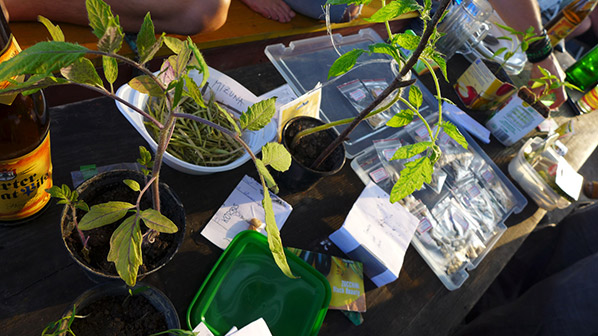
Join us for a seed exchange party where packets of seeds change hands and go underground in the fields around Finsbury Park and beyond.
Bring your self-harvested homegrown seeds of sorts! Sign on to trade seeds, to adopt and germinate, to broadcast and track their distribution. Share some food, drinks and seeds stories while we celebrate the harvest season together in the relaxing setting of Finsbury Park.
+ To join Seeds Underground Party, and trade and track your seeds, please register on http://seedsunderground.net
Click on TRADE and select Furtherfield, London from the “join a seeds underground party” pull down menu.
Seeds Underground holds seed exchange parties where packets of seeds change hands and go underground in the fields across nation borders.
+ More information:
now@seedsunderground.net
www.seedsunderground.net
Furtherfield Gallery
McKenzie Pavilion, Finsbury Park
London N4 2NQ
T: +44 (0)20 8802 2827
E: info@furtherfield.org
Furtherfield Gallery is supported by Haringey Council and Arts Council England
Featured image: Thomson and Craighead, Here (2013)
Visiting Jon Thomson and Alison Craighead’s survey exhibition, Never Odd Or Even, currently on show at Carroll / Fletcher Gallery, I found myself confronted with an enigma. How to assemble a single vision of a body of work, impelled only by the dislocated narratives it offers me? ‘Archaeology’ is derived from the Greek word, arche, meaning ‘beginning’ or ‘origin’. The principle that makes a thing possible, but which in itself may remain elusive, unquantifiable, or utterly impervious to analysis. And so it is we search art for an origin, for an arising revelation, knowing full well that meaning is not something we can pin down. Believing, that the arche of a great work is always just about to take place.
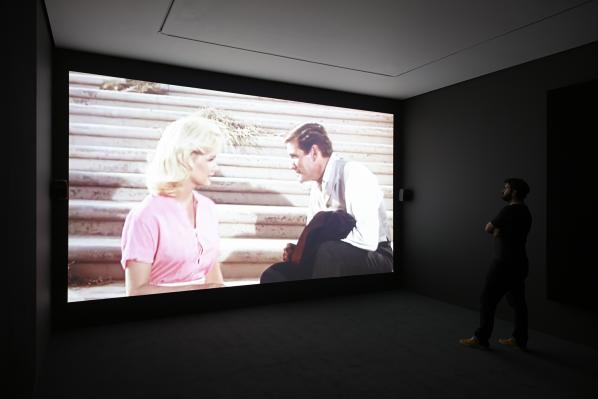
In an essay written especially for the exhibition, David Auerbach foregrounds Thomson and Craighead’s work in the overlap between “the quotidian and the global” characteristic of our hyperconnected contemporary culture. Hinged on “the tantalising impossibility of seeing the entire world at once clearly and distinctly” [1] Never Odd Or Even is an exhibition whose origins are explicitly here and everywhere, both now and anywhen. The Time Machine in Alphabetical Order (2010), a video work projected at the heart of the show, offers a compelling example of this. Transposing the 1960 film (directed by George Pal) into the alphabetical order of each word spoken, narrative time is circumvented, allowing the viewer to revel instead in the logic of the database. The dramatic arcs of individual scenes are replaced by alphabetic frames. Short staccato repetitions of the word ‘a’ or ‘you’ drive the film onwards, and with each new word comes a chance for the database to rewind. Words with greater significance such as ‘laws’, ‘life’, ‘man’ or ‘Morlocks’ cause new clusters of meaning to blossom. Scenes taut with tension and activity under a ‘normal’ viewing feel quiet, slow and tedious next to the repetitive progressions of single words propelled through alphabetic time. In the alphabetic version of the film it is scenes with a heavier focus on dialogue that stand out as pure activity, recurring again and again as the 96 minute 55 second long algorithm has its way with the audience. Regular sites of meaning become backdrop structures, thrusting forward a logic inherent in language which has no apparent bearing on narrative content. The work is reminiscent of Christian Marclay’s The Clock, also produced in 2010. A 24 hour long collage of scenes from cinema in which ‘real time’ is represented or alluded to simultaneously on screen. But whereas The Clock’s emphasis on cinema as a formal history grounds the work in narrative sequence, Thomson and Craighead’s work insists that the ground is infinitely malleable and should be called into question.
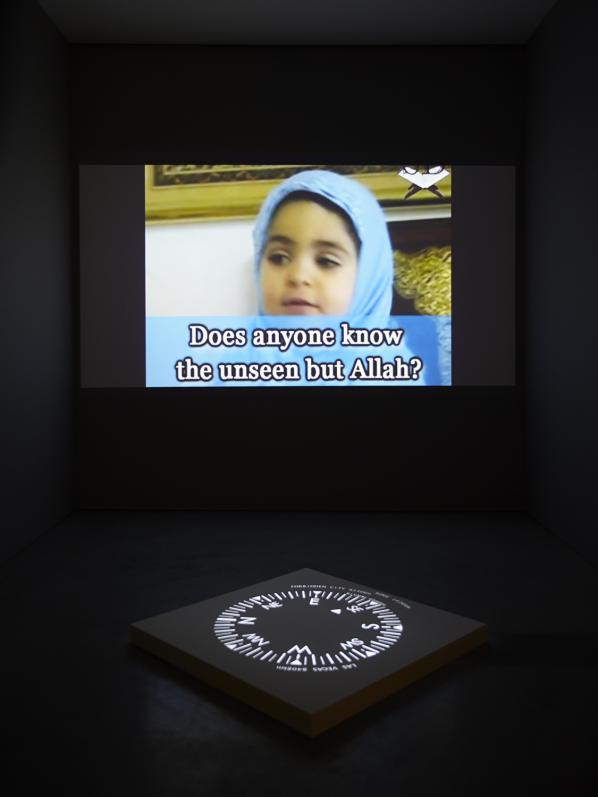
Another work, Belief (2012), depicts the human race as a vast interlinked, self-reflexive system. Its out-stretched nodes ending at webcams pointing to religious mediators, spiritual soliloquists and adamant materialists, all of them searching to define what it means to be in existence. Projected on the floor of the gallery alongside the video a compass points to the location each monologue and interview was filmed, spiralling wildly each time the footage dissolves. Each clip zooms out of a specific house, a town, a city and a continent to a blue Google Earth™ marble haloed by an opaque interface. Far from suggesting a utopian collectivity spawned by the Google machine, Belief once again highlights the mutable structures each of us formalise ourselves through. As David Auerbach suggests, the work intimates the possibility of seeing all human kind at once; a world where all beliefs are represented by the increasingly clever patterns wrought through information technology. Instead, culture, language and information technology are exposed as negligible variables in the human algorithm: the thing we share is that we all believe in something.

Never Odd Or Even features a series of works that play more explicitly with the internet, including London Wall W1W (2013), a regularly updated wall of tweets sent from within a mile of the gallery. This vision of the “quotidian” out of the “global” suffers once you realise that twitter monikers have been replaced with each tweeter’s real name. Far from rooting the ethereal tweets to ‘real’ people and their geographic vicinity the work paradoxically distances Thomson and Craighead from the very thing twitter already has in abundance: personality. In a most appropriate coincidence I found myself confronted with my own tweet, sent some weeks earlier from a nearby library. My moment of procrastination was now a heavily stylised, neutralised interjection into Carroll / Fletcher gallery. Set against a sea of thoughts about the death of Margaret Thatcher, how brilliant cannabis is, or what someone deserved for lunch I felt the opposite of integration in a work. In past instances of London Wall, including one at Furtherfield gallery, tweeters have been contacted directly, allowing them to visit their tweet in its new context. A gesture which as well as bringing to light the personal reality of twitter and tweeters no doubt created a further flux of geotagged internet traffic. Another work, shown in tandem with London Wall W1W, is More Songs of Innocence and of Experience (2012). Here the kitsch backdrop of karaoke is offered as a way to poetically engage with SPAM emails. But rather than invite me in the work felt sculptural, cold and imposing. Blowing carefully on the attached microphone evoked no response.
The perception and technical malleability of time is a central theme of the show. Both, Flipped Clock (2009), a digital wall clock reprogrammed to display alternate configurations of a liquid crystal display, and Trooper (1998), a single channel news report of a violent arrest, looped with increasing rapidity, uproot the viewer from a state of temporal nonchalance. A switch between time and synchronicity, between actual meaning and the human impetus for meaning, plays out in a multi-channel video work Several Interruptions (2009). A series of disparate videos, no doubt gleaned from YouTube, show people holding their breath underwater. Facial expressions blossom from calm to palpable terror as each series of underwater portraits are held in synchrony. As the divers all finally pull up for breath the sequence switches.
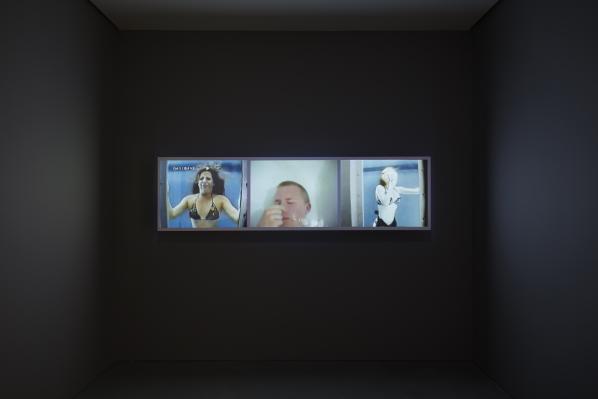
According to David Auerbach, and with echoes from Thomson and Craighead themselves, Never Odd Or Even offers a series of Oulipo inspired experiments, realised with constrained technical, rather than literary, techniques. For my own reading I was drawn to the figure of The Time Traveller, caused so splendidly to judder through time over and over again, whilst never having to repeat the self-same word twice. Mid-way through H.G.Wells’ original novel the protagonist stumbles into a crumbling museum. Sweeping the dust off abandoned relics he ponders his machine’s ability to hasten their decay. It is at this point that the Time Traveller has a revelation. The museum entombs the history of his own future: an ocean of artefacts whose potential to speak died with the civilisation that created them. [2] In Thomson and Craighead’s work the present moment we take for granted becomes malleable in the networks their artworks play with. That moment of arising, that archaeological instant is called into question, because like the Time Traveller, the narratives we tell ourselves are worth nothing if the past and the present arising from it are capable of swapping places. Thomson and Craighead’s work, like the digital present it converses with, begins now, and then again now, and then again now. The arche of our networked society erupting as the simulation of a present that has always already slipped into the past. Of course, as my meditation on The Time Traveller and archaeology suggests, this state of constant renewal is something that art as a form of communication has always been intimately intertwined with. What I was fascinated to read in the works of Never Odd Or Even was a suggestion that the kind of world we are invested in right now is one which, perhaps for the first time, begs us to simulate it anew.
On second day of summer, Maja Kalogera & Med-i-kids from AKC Medika in Zagreb, will gather in Finsbury Park in front of Furtherfiled Gallery. They will present Classical Sitting Squatters. They are quite a joyful bunch, they recite, chirp, sing, blink, sit still, just name it. You are invited to join them/us for a drink and meet them in ‘person’, on Saturday 22 June 2013, between 11am and 5pm.
Classical Sitting Squatters (CSS) is an installation made of a dozen full-sized figures or ‘sitting’ sculptures. They are reciting poetry of Gertrude Stein, Dylan Thomas and Emily Dickinson, on the input of the passers-by.

Med-i-kids is an open group of street artists which connected in Medika, Zagreb. Their mission is to make public artworks to raise awareness and question the many dogmas present in Croatian society, the very same society positoned in third place as one the most courrupted countries positioned.
Maja Kalogera is an artist, curator and catalyst who consistently places herself at the convergence of art and technology. Born in Zagreb, she holds B.F.A. from School of Applied and Visual arts, Zagreb and M.Arch. from Architecture University, Zagreb. From 1999 she is member of the online collective wowm.org. Her creative work over the past 15 years has included a wide range of mediums: digital and interactive media, photography, painting, video and film. In 2005, she founded Center for synergy of digital and visual arts, a Zagreb based NGO, that provides her unique approach focused on synergy between traditional art media with new, digital media. In her own artwork she is interested in ways how people participate in physical and virtual spaces. Lately she started to collaborate with med-i-kids on socially engaged projects.
Unmanned mobile devices, better known as drones, are one of the most significant ‘dark technologies’ of the 2010’s, and proceeds to reconfigure sociopolitical relations through the gesture of the remote gaze. Note that I say ‘mobile’, as opposed to ‘aerial’, as drones encompass unmanned land and water-based craft as well, but for our purposes, the flying eye has been the most visible technology in Baudrillard’s mediascape in terms of its use by the CIA in the Afghanistan/Pakistan and African theatres of operation.
To compound matters, the 2012 FAA Reauthorization Act has created a milieu in which estimates are that there could be 10,000 domestic drones in use by 2020 (Bennett & Rubin). Drones are going to be one of the US’s major technology growth markets, with the devices being used in geographic, aerospace, and environmental research as well as military and law enforcement uses.
From this, a strange series of cultural disconnects are emerging as drone images become Tumblr fodder as part of the ‘New Aesthetic’ art movement via James Bridle’s Dronestagram site (Bridle), and drones proliferate through sites like DIYDrones.com and even retailer Costco. What emerges is a complex cultural landscape where a burgeoning remote air force polices the globe in the name of American power, while the images generated by them elicit a perverse visual fascination amongst certain subcultures. Furthermore, only slightly domesticated versions of these technologies are now being flown by techno-enthusiasts and children. What is developing is a complex set of relations that is abstracting power, interaction, and representation.

In March of 2012, a panel of five artists, writers, and designers presented a panel at the media festival South by Southwest entitled, “The New Aesthetic: Seeing Like Digital Devices” (Bridle, et al). In this panel, they stated that the aesthetics of digital vision and representation, created through algorithmically-driven imaging and devices, including generative art, Kinects, and drones, are creating a machine aesthetic signaling a distinct step in the creation of the digital image since its emergence in the 1960’s. The panel expounded upon the aesthetics of new re-presentation technologies like 3D printing as well. Keep in mind that this panel drew with a very broad brush, including everything from algorism to computer glitch media, but what has intersected with current events are robot eyes like those of drones and their cyborg sighting mechanisms that team pattern recognition with human remote operators. This panel may have faded into obscurity if it were not for Bruce Sterling’s endnote talk foregrounding the concept (Sterling).
Bridle’s creation of the Dronestagram Tumblr foregrounds the drone’s eye view or the ‘shadow’ of the drone on the landscape, as depicted by Bridle’s Drone Shadow 002 (Bridle), which was a 1:1 scale outline of a drone’s shadow in Istanbul for the 1st Istanbul Design Biennial. Other projects that highlight the gaze from and the gazing of military drones are Trevor Paglen’s Drone Vision and Omar Fast’s film, Five Thousand Feet is the Best, which tells a fictionalized encounter of a Nevada-based drone operator with an interaction between a Middle Eastern family and a group of men planting an IED. Fast makes an interesting observation in the narrative, “Seeing the world from above doesn’t just flatten things, it sharpens them. It makes relationships clearer.” (Fast) Conversely, Trevor Paglen remarks on the nature of drone vision:
“What is particularly interesting to me are the ways in which ‘seeing like a drone’ is and is not like seeing through a standard bombsight: the techno-optical regime through which conventional bombing has been conducted differs from the high-resolution full-motion video feeds that inform (and misinform) the networked bombing of late modern war. Those feeds significantly compress the imaginative distance between the air and the ground, but they do so in a highly selective fashion.” (Paglen, from Gregory)
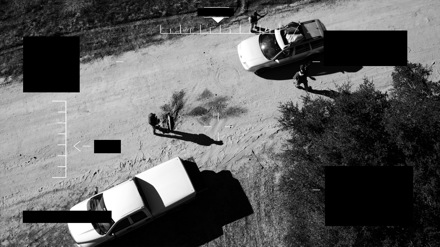
How I see the gaze of the drone is not through relief, technological regimes, or even traditional paradigms of Mulvey’s acquisitiveness of the male gaze (Mulvey), but of a Latourian network of objects (actors) in a network (Latour) that reconfigures the definition of the viewed object that the line of flight that the drone-gaze confers. In my model, the operator-node views the ‘sighted’ object through a framing of the drone camera, part of which is controlled by pattern-acquisition algorithms. What results is an augmented ‘cyborg’ sight in which the mise en scene is given the illusion of being sharpened by the technological regime of the drone’s technological systems. It is a line of flight that travels along of three nodes in a network of gaze; the operations site, the programmatic framing node of the drone-object which then redirects the gaze to the objective, transforming it from a house, person, or loved one to a target or objective. This is the problem of the cyborg gaze of the drone.
Another read of the drone gaze can be found in James Cameron’s movie, Avatar(ibid.) In it, disabled soldier Jake Sully operates a bioengineered clone of one of the native species, the Na’vi, to infiltrate their culture. While many have likened Avatar to a criticism of the Iraq and Afghanistan engagements, I posit that Jake’s avatar, is in fact a drone in biomorphic form. The difference here is not merely the optic (and haptic) immediacy of the avatar and its less destructive mission, but the avatar’s mission to win the “hearts and minds” of the native population, similar to that of the Afghanistan conflict. The drone-dream of Avatar is experience and agency without presence, although Jake does end up ‘going native’ when his human body is killed and his soul transfers into his Na’vi body. This echoes many films in which the colonizing body becomes part of the colonized demographic after spending time with them, like Dances with Wolves. It’s safe to say that a drone pilot might not want to ‘go native’ until such a biomorphic agent is invented, but Avatar problematizes the notion of remote engagement in terms of Fast’s affective gaze of the drone and its context to human relationships in addition to Cameron’s romanticization of the avatar-drone.
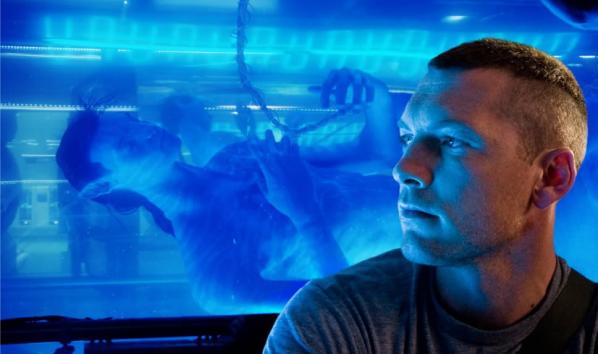
The second aspect of remote engagement that Avatar brings into focus is the lack of distinction between the technologically enabled person of disability versus the able-bodied person placed into a state of paralysis by being tied to the workstation or network-connected device. In The Third Interval, (Virilio) Paul Virilio posits this liminal (dis)abled state as an effect of the technological collapse of space through networked technology, but as Raunig states, a Deleuzian line of flight and invention appropriated by the state apparatus as a tool for the institution of war. Jake becomes freed by his cyborg existence, only to be trapped by the war machine of the corporate state until he is freed by the elimination of his techno-duality. It appears that true freedom can only come from the severance from remote control and cognitive integration with the drone itself. To experience the ontology of a drone, you must become one, not merely control it. (Bogost)
“There are eyes everywhere. No blind spot left. What shall we dream of when everything becomes visible? We’ll dream of being blind.” – Paul Virilio
Setting aside the idea of becoming drones, I want to share a cognitive dissonance that I experienced at the end of 2012. While reading descriptions of the dark spectacle of “The Light of God” (what the laser homing beam used for the Hellfire missile has been called) in the Middle East, over Christmas 2013 I was horrified to see stacks of drones for sale at the local Costco (a regional US wholesale big-box chain) in a picture posted on Facebook by scholar Richard Grusin. I had been working with devices like the ARDrone for a couple years, but to see stacks of them for holiday sale was a grim fantasy made real. It is not that, as Paul Virilio said, there are just more eyes in the panoptic First World (in addition to police cameras, phones, ATM machines and the like), but these particular eyes that are being used as extensions of state power are being sold as infantilized versions at holiday retailers. The ARDrone was the early techno-adopter’s fetish of the 2012 shopping season, military technology commodified as completely as any iPad (which it uses as a controller, by the way). As Laurie Anderson said in the film, McLuhan’s Wake, “if you want to get the job done, you‘re gonna want the latest thing…”(McLaughlin, et al), and in this case, the thing is the ARDrone. Or it could be any of the products promoted by Chris Anderson’s new project, DIYDrones.com, a start-up he left WIRED Magazine in part to create.
The connecting conversation between the military Predator and our “pet” predator (i.e. the videodrone; and there is an irony that many of our pets are predators, such as dogs, cats, and ferrets) is that I was communicating with artist Art Jones in Karachi, Pakistan who was doing an art project with the US State Department. He called it The Pakistani Playlist(), where US artists would send media and links to him in Karachi as a form of intercultural dialogue. I sent links to devices like the ARDrone and videos of children playing with these infantilized versions of military technologies that were zipping around the outer tribal lands. My aim, and Jones understood this, was that technoculture and the military-industrial complex sells a dark dichotomy between remote hunter-killers abroad and sexy flying eyes at home that one woman even asked me to use to see if her landlord had successfully removed the bird nest from her rafters. How can something so fun and useful, because it’s little more than a radio-controlled plane with a camera, be that dangerous? What’s the worst that could happen, except for perhaps having your teenage son spying on the sunbathing girl next door? As a point of note, that scenario was one illustrated briefly in a PBS documentary called The Rise of the Drones.
The cultural effect of the domesticated drone is that of banalization and aestheticization of military technology and its products that elide the stark reality that the ARDrone at the Costco is not a General Atomics Predator. The swarms of synchronized quadricopters being developed at Penn State in videos on YouTube are not seen in the context of their potential applications for the violation of personal privacy. In addition, Parrot (the maker of the ARDrone) offers tools to dynamically upload your flight videos to YouTube without vetting, and another app allows you to create snazzy dance numbers by creating aerial ballets for your drone on your iPad. Those who have always dreamt of flight, like me, can now share our dreams of flight through the social nets. Given this, drone flight logs have the potential of having the banality of funny cat videos and hipster Tumblr sites, while eliding the social issues these devices raise. What is the meaning of a domestic commons when Foucault’s panoptic vision is merely intensified by the number of Virilio’s public eyes? Is the fact that public eyes are now nearly universal, justifying the installation of more of them? And who are the operators, and what is the intent of the gaze of the domestic drone? And what of the configuration of the drone as fetishized object itself, such as Antoine Catala’s objectified drone exhibition (Kirsch) or Burt Jensen’s Orvillecopter(Netburn), the merger of taxidermied cat and quadridrone?
The emergence of the drone in all its configurations, fixed-wing, quadricopter, or rover, how they represent the detached gaze and how they are depicted in the media, call into the question the ethics of remote warfare, new forms of objectification, commodification, and aestheticization of intrusive technologies and their mediated production. The use of drone strikes by the CIA around the world, the intersection of these practices through critical artmaking sectors of The New Aesthetic and its obsession with the machine eye, as well as the proliferation of domestic drones (at least in North America) show the complexities of the cultural impact of this ‘dark’ technology. Furthermore, where technology is in one place a weapon, in another a toy, and yet in another a fetishized object brings us to a complex discursive locus where the extension of military power, McLuhanist body augmentation, and cultural production are all brought into question. Where the military-industrial complex has given technological apparatuses with multivalent uses such as the Internet, drones complicate the concept of the remote eye in ways that are in no way even close to resolution.
Glitch as an aesthetic signifier of technological presence dates back at least to the 1980s. Look at The Vaught-Kampf machine in Blade Runner (1982) or the titular character in Max Headroom (1985). The use of Glitch as an artistic aesthetic in itself has accelerated with the democratization of newer technologies that make older glitch-prone technology obsolete. When a technology becomes redundant, its previous technical inefficiencies become available for aesthetic recuperation and appreciation.
The hiss and crackle of vinyl records, to be ignored or reduced as far as possible by the mid-20th century audiophile, became signifiers of historical authenticity in 1990s Trip Hop. The lens flare, light seepage and colour shift of cheap mass-produced chemical film-based cameras have been turned from annoyances to fetishes with Lomography (experimental analogue film photography) and Instagram. And the glitches of poor video connections or corrupted floppy disks have followed a similar path in Glitch art.
This is a process of ironisation. Irony changes or inverts content without altering form. Meaning is introduced into systems by ironising non-signifying forms. It is modified and modulated by further ironising those forms. The glitches that once frustrated media professionals and home users of electronic media are ironised into aesthetic form in Glitch Art.
Glitch Art sits in the historical tradition of process art and chance art. Automatism and chance acts in Dada, Surrealism, Situationism and the Oulipo, and Scatter art. Generative and algorithmic art. Action painting provides the useful concept of “all-over composition” as a way of avoiding a requirement of specific, localisable intent in aesthetically, evaluating an image.
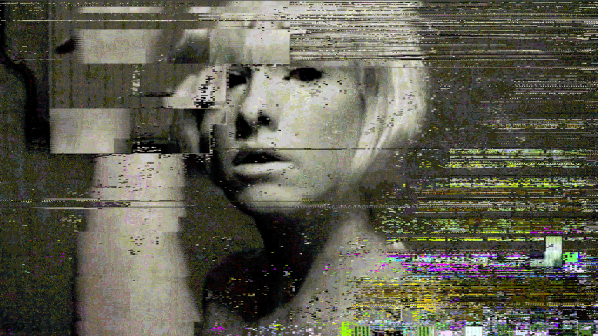
Glitch art also sits in the historical traditions of remix art, detournement and décollage. The knowledge that the image has been altered is key to its aesthetic reception. It’s tempting to talk about the creative destruction of capitalism and to damn Glitch as neoliberal apologia, but that’s too easy and would leave the speaker too comfortable. It is also very tempting to try and place Glitch Art within the traditions of anti-aesthetics or of nominalistic/found art, or to compare the use of image corruption to artistic outsourcing or crowdsourcing in terms of artistic abrogation of authorship. But Glitch is at least curated by the artist, and its generation requires an engagement with the specificities of digital media that they are not supposed to have. The Glitch artist is artisan, not manager, and Glitch Art is sublime, not ordeal.
Panofsky’s extension of the idea of symbolic form to perspective can be applied to Glitch as form. Glitch is effect (a body of effects) that generates *critical* form. The patterns of noise or confounding signals that result from analog or digital image corruption and the effects on displaced sections of the corrupted image are form, presented for positive aesthetic evaluation rather than removed to avoid negative technical evaluation. This complicates Shannon’s diagram of information transmission. Noise is ironised into signal.

The smooth running of inhuman systems is disquieting. Glitch reasserts their materiality. To the extent that it did so to generalise specific failings to a general system in order to make them appear fallible and human this would be kitsch. To the extent that it did so to remind us of older technology, it would be Cory Arcangel-style leveraged nostalgia. And to the extent that it generationally positioned itself against the previous generation’s perception of value in its own culture would be adolescent, social positioning.
Glitch art avoids these failings by producing tension and contradiction rather than jouissance and confirmation. It is disquieting in a way that disturbs the new without allowing a return to an idealized earlier social and aesthetic order, and it is aesthetically creative in a way that does not hide the destruction involved.
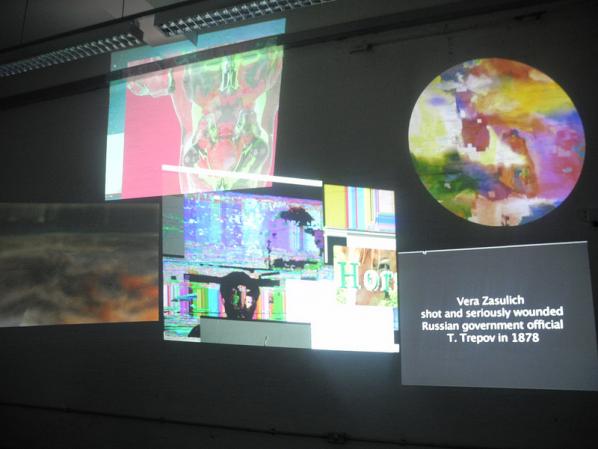
The 8 and 16-bit console software beloved by some Glitch artists is comprehensible to them and to their audiences in a way that 64-bit cloud-based network software is not. The former is therefore a useful artistic proxy for the latter. Defamiliarising the one familiarises the other, and provides a way in to critique its unseen operation through visible means.
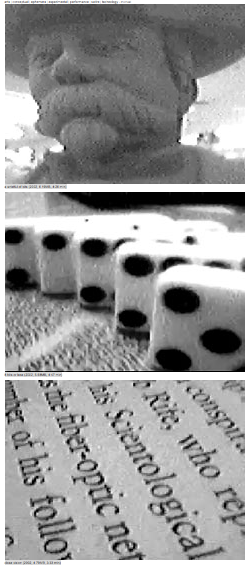
Art makes invisible order tractable by making it visible. Glitch aesthetics are all-over irruptions of the hidden technological order that reveal its operation through its failure. They assert not a reactionary nostalgia but a potential challenge to closure. Engaging with Glitch aesthetics allows us to exercise and develop our regard in a way that increases our fit to the smooth operation and to the catastrophes and contradictions of our post-digital environment.
The text of this review is licenced under the Creative Commons BY-SA 3.0 Licence.
Don’t forget the Glitch Moment/ums exhibition at Furtherfield
Curated by Rosa Menkman & Furtherfield.
Opening Event: Saturday 8 June 2013, 2-5pm
with Glitch Performance by Antonio Roberts at 3pm
http://www.furtherfield.org/programmes/exhibition/glitch-momentums
Featured image: A random Geocities homepage, last updated sometime around 1997
Daniel Rourke visits the Photographers’ Gallery in central London and reviews their latest exhibit One Terabyte of Kilobyte Age by artists Olia Lialina and Dragan Espenschied, on THE WALL. Over an eight week period (18 April – 17 June 2013) they feature a non-stop stream of video captures of what they term as the lost city and its archival ruins. A documentation of a past visual culture of the web and the creativity of its users with new pages changing every 5 minutes. The project provides a glimpse into web publishing when users were in charge of design and narration in contrast to the automated templates of Facebook, YouTube and Flickr.
Sifting through a dormant internet message board, or stumbling, awestruck, on a kippleised [1] html homepage, its GIF constellations still twinkling many years after the owner has abandoned them, is an encounter with the living, breathing World Wide Web. At such moments we are led, so argues Marisa Olson, ‘to consider the relationship between taxonomy à la the stuffed-pet metaphor and taxonomy à la the digital archive.’ [2] How such descript images, contrived jumbles of memory and experience, could once have felt so essential to the person who collated them, yet now seem so indecipherable, stagnant, even – dare we admit it – insane to anyone but the most hardened retro-web enthusiast.
On show at London’s Photographers gallery until June 17th is an extensive archival exhibit designed to manage, reveal and keep these experiences alive. One Terabyte Of Kilobyte Age (1tb) is the fifth work to be commissioned for the Photographer Gallery’s ‘The Wall’, curated by two artists long associated with the era of the web the exhibition reveres: Olia Lialina and Dragan Espenschied. Perhaps best known for their book Digital Folklore (2009) the artists and retro-web evangelists have, with the 1tb project, strengthened their status as archivists, an impulse Hal Foster famously argued ‘concerned less with absolute origins than with obscure traces’ [3]. In the same year that Dragan and Olia launched their guide to the folk web, Yahoo! announced they were to close one of its greatest sources of inspiration: Geocities. A vast expanse of personal webpages, many of which had long since slid into html decrepitude, represented for Yahoo! little but financial embarrassment. So ancient and outmoded was Geocities that many contemporary browsers were incapable of capturing its essence, fragmenting images and link rolls randomly across modern laptop screens in an attempt to render their 800×600 pixel aura. Scraping and downloading the terabyte or so of data that made up the Geocities universe was thought important enough by some that a taskforce was put together, made up of technical wizards and wizardesses driven by the profound notion that all existent culture is worth saving. From Olia and Dragan’s webpage:
In between the announcement and the official date of death a group of people calling themselves Archive Team — managed to rescue almost a terabyte of Geocities pages. On the 26th of October 2010, the first anniversary of this Digital Holocaust, the Archive Team started to seed geocities.archiveteam.torrent.
Olia and Dragan’s gesture, to feed the wealth of culture contained in that torrent back to the masses in a palatable form, is a project whose fruition at the Photographer’s Gallery is but a minor part. After downloading, storing and sorting the 16,000 archived Geocities sites the task of exactly how to display them is a problem. Since most browsers would mangle the look and feel of the Geocities pages Olia and Dragan have turned to two main methods of re-representation. The first, let loose on an automated Tumblr blog that updates over 70 times a day, is an ever growing series of front-page screen captures. In this form 1tb bends to the will of a contemporary web user who concerns themselves with likes, reposts and uplinks.
Reflecting on the Tumblr-archive of the torrent-archive of the Geocities-archive, Olia and Dragan’s site contemporary-home-computing highlights particular screen captures that have garnered the most reposts and likes from their Tumblr followers. The results say much for the humour that still drives online culture, but perhaps little about the original contexts from whence those screen captures came. For instance, the screen captures that garner most attention are usually the ones that have failed a part of the retrieval/display/capture process. These ‘obscure traces’ may be GIF heavy sites, half loaded to interesting aesthetic affect, or, perhaps the most telling, captures that show nothing but the empty shell of a Netscape Navigator browser, caught forever like a millennium bug in digital amber.
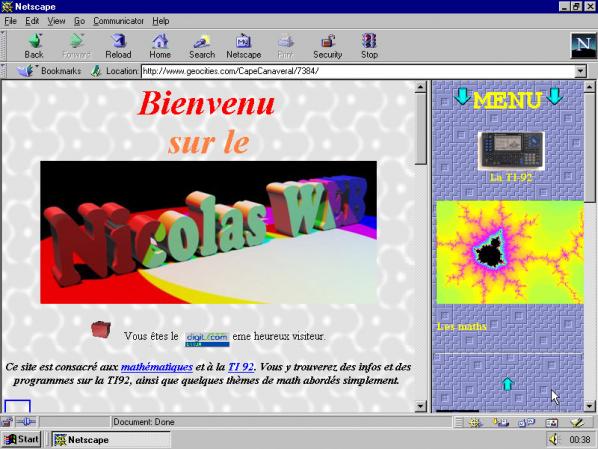
The second mode of capture and re-display takes place at the Photographer’s Gallery itself. Depicted on nine large intersecting HD video screens set into ‘The Wall’ of the entrance-cum-café, one’s first experience of the exhibit is ponderous. The display cycles through the vast array of Geocities homepages at five minute intervals, giving viewers a more than generous dose of 800×600 px nostalgia. Whether the websites that fade into view are a barrage of animated GIFs,insightful commentary on life in the late 1990s, or a series of barren ‘Under Construction’ assemblages, is up to chance.
As a reviewer, sent to derive something from the gallery experience, the wall leered at me with gestures that sent my inner taxonomist into a frenzy. Confronted with such tiny slithers of the archive, in such massive doses, it quickly becomes obvious that the real potential of the project has not been quite realised. Rather than static screen captures The Wall shows cleverly rendered quicktime videos, allowing the GIF whiskers of a Hello Kitty mascot to quiver once more. If you are lucky, or have the patience to watch a long series of the sites fade into view, you’ll be greeted by flickering ‘Welcome’ banners, by cartoon workmen tirelessly drilling, by unicorns cantering and sitemeter bars flashing. But The Wall also feels wholly at odds with its content, caught up in a whirl of web nostalgia that minimises the lives, experiences and aesthetic choices of a defining generation to static flashes that you can’t click on, no matter how much you want to. Archives are living, breathing entities wont to be probed for new meanings and interpretations. Whether depicted as static or faux animated, One Terabyte Of Kilobyte Age is a project with an endless surface, with little way for its viewers to delve deeper.
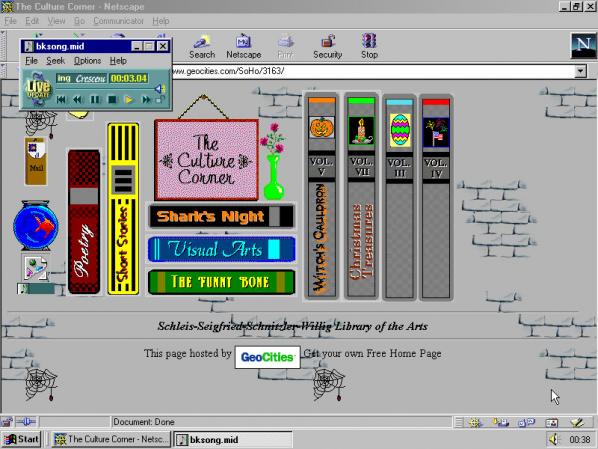
Trawling through the 1tb Tumblr is a much more visceral experience than the one that greets you at the Photographer’s Gallery, but the sense of a journey waiting to be embarked on is lost somewhat in the move to the Tumblr kingdom. Every five minutes offers a new chance to spot similarities on The Wall, to ponder on the origins of a site or, more profoundly, wonder where the people that toiled to make them are now. Before the days of user driven content, of Facebook timelines, and even before RSS feed aggregators, the whole web felt something like this. Today’s web is unarguably more dynamic, with a clean aesthetic that barely shifts behind the waves of content that wash over its surface. But the user has been relegated to shuffler of material.
The Geocities homepage was designed, and kept updated by an army of amateur enthusiasts, organising bandwidth light GIFs in ever more meaningful arrays, in the unlikely event that another living soul would stumble upon them. There is much to love about One Terabyte Of Kilobyte Age, and much to be learned from it given the time. But part of me wishes that the Photographer’s Gallery had given over their trendy café to a row of beige Intel 486 computer stacks, their unwieldy tube monitors better capturing the spirit of the web alá 1996. The clash between the 90s amateur enthusiast and the avid content shuffler of the 2010s is inherent in the modes of display Olia and Dragan chose for their project. Beginning from a desire to save and reflect on our shared heritage, 1tb now represents itself as pure content. An impulse to probe the archive replaced by an impulse to scroll endlessly through Tumblr streams, clicking like buttons on screen captures we hope will distract/impress/outrage our friends until the next cat video refreshes into view.
Go, go to the Photographer’s Gallery tomorrow, grab yourself a coffee and let the Geocities archive wash over you. If you can do it without Instagramming a snap to your friends, without updating your Facebook page with tales of your nostalgic reverie, if you can let the flickering screen captures do their own talking , only then can you claim you truly re-entered the kilobyte age.
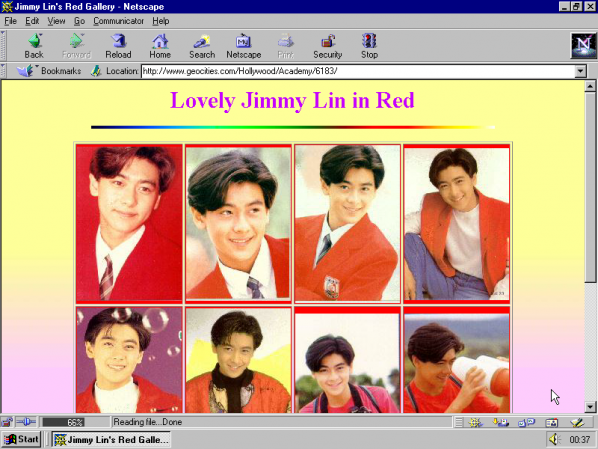
Erica Scourti’s work addresses the mediation of personal and collective experience through language and technology in the net-worked regime of contemporary culture. Using autobiographical source material, as well as found text collected from the internet displaced into social space, her work explores communication, and particularly the mediated intimacy engendered by a digital paradigm.
The variable status and job of the artist is humorously fore-grounded in her work, assuming alternating between the role activist, ‘always-on’ freelancer, healer of social bonds and a self-obsessed documenter of quotidian experience.
Millions are blissfully unaware of the technological forces at work behind the scenes when we use social network platforms, mobile phones and search engines. The Web is bulging with information. What lies behind the content of the systems we use everyday are algorithms, designed to mine and sort through all the influx of diverse data. The byproduct of this mass online activity is described by marketing companies as data exhaust and seen as a deluge of passively produced data. All kinds of groups have vested interests in the collection and analysis of the this data quietly collected while users pursue their online activities and interests; with companies wanting to gain more insight into our web behaviours so that they can sell more products, government agencies observing attitudes around austerity cuts, and carrying out anti-terrorism surveillance.
Felix Stalder and Konrad Becker, editors of Deep Search: The Politics of Search Beyond Google,[1] ask whether our autonomies are at risk as we constantly adapt and tailor our interactions to the demands of surveillance and manipulation through social sorting. We consciously and unconsciously collide with the algorithm as it affects every field of human endeavour. Deep Search illuminates the politics and power play that surround the development and use of search engines.
But, what can we learn from other explorers and their own real-life adventures in a world where a battle of consciousness between human and machine is fought out daily?
Artist Erica Scourti spent months of her life in this hazy twilight zone. I was intrigued to know more about her strange adventure and the chronicling of a life within the ad-triggering keywords of the “free” Internet marketing economy.
Marc Garrett: In March 2012, you began the long Internet based, networked art project called Life in AdWords, in which you wrote and emailed a daily diary to your Gmail account and performed regular webcams where you read out to the video lists suggested keywords. These links as you say are “clusters of relevant ads, making visible the way we and our personal information are the product in the ‘free’ Internet economy.”
Firstly, what were the reasons behind what seems to be a very demanding project?
Erica Scourti: Simply put, I wanted to make visible in a literal and banal way how algorithms are being deployed by Google to translate our personal information – in this case, the private correspondence of email content – into consumer profiles, which advertisers pay to access. It’s pretty widespread knowledge by now that this data ends up refining the profile marketers have of us, hence being able to target us more effectively and efficiently; just as in Carlotta Schoolman and Richard Serra’s 1973 video TV Delivers People,[2] which argues that the function of TV is to deliver viewers to advertisers, we could say the same about at least parts of the internet; we are the commodities delivered to the advertisers, which keep the Web 2.0 economy ‘free’. The self as commodity is foregrounded in this project, a notion eerily echoed by the authors who coined the term ‘experience economy’, who are now promoting the idea of the transformation economy in which, as they gleefully state, “the customer is the product!”, whose essential desire is to be changed. The notion of transformation and self-betterment, and how it relates to female experience especially within our networked paradigm is something I’m really interested in.
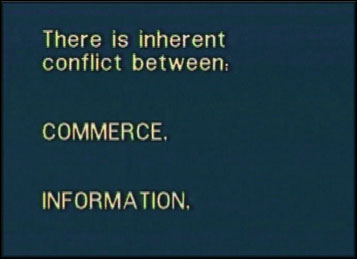
As Eli Pariser has pointed out with his notion of filter bubbles, the increasingly personalised web employs algorithms to invisibly edit what we see, so that our Google searches and Facebook news feeds reflect back what we are already interested in, creating a kind of solipsistic feedback loop. Life in AdWords plays on this solipsism, since it’s based on me talking to myself (writing a diary), then emailing it to myself and then repeating to the mirror-like webcam a Gmail version of me. This mirror-fascination also implies a highly narcissistic aspect, which echoes the preoccupation with self-performance that the social media stage seems to engender; but narcissism is also one of the accusations often leveled at women’s mediated self-presentation in particular, despite, as Sarah Gram notes in a great piece on the selfie, [3] it being nothing less than what capital requires of them.
![Girl with a Pearl Earring and a Silver Camera. Digital mashup after Johannes Vermeer, attributed to Mitchell Grafton. c.2012. [4]](http://www.furtherfield.org/wp-content/uploads/2013/05/vermeer_selfie.jpg)
And as this project is a form of autobiography and diary-writing, it could also be seen as both narcissistic and as asserting the importance of personal experience and emotions in the construction of a humanist, unified subject. Instead, I wanted to experiment with a way of writing a life story that operated somewhere between software and self, so that, as Donna Harraway says “it is not clear who makes and who is made in the relation between human and machine”. Part of the humour of the project arises from the dissonance between the staged realism of the webcam (and my real cat/ hangover/ bad hair) with the syntactically awkward, machinic language, which undermines any notion that this diary is the expression of any authentic subject.
The demanding aspect of it is something I was interested in too, since it calls up the notion of endurance as a virtue, and therefore as a value-enhancer, which many artworks – from mind-boggingly labour intensive supercut-style videos to sculptures made from millions of pins (or whatever) – trade on. You just can’t help but ask ‘wow…how long did that take?!’ – as if the time, labour and effort, i.e. the endurance, necessarily confer value. So there is a parallel between a certain kind of ‘age of austerity’ rhetoric that valorises resilience and endurance and artworks that trade on a similar kind of doggedness – like Life in AdWords does.
And finally – it made me laugh. Some of the text was so dumb, and funny, it amused me to think of these algorithms dutifully labouring away to come up with key-phrases like ‘Yo Mamma jokes’ and ‘weird pants’.
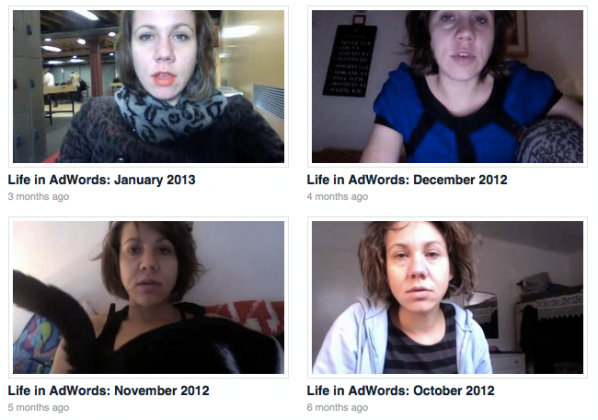
MG: It ran until 20th January 2013, and ended due to system changes in the Gmail ad settings. How many videos did you produce and were you glad when it all had finally ended?
ES: Not sure how many I made – but I was 6 weeks short of the intended year, so definitely over 300. Actually I was infuriated and somewhat depressed when it ended without warning and in a moment of panic I even thought about somehow cheating it out to the end; but working with a system that is beyond your control (i.e. Google) necessarily involves handing over some of your authorial agency. So instead I embraced the unexpected ending and threw a kind of send-off party plus performance in my bedroom/ studio to mark it.
But this question of agency is obviously crucial in the discussion of technology and runs through the project in various ways, beyond its unintended termination. At the level of the overall structure, it involves following a simple instruction (to write and process the diaries every day and do the webcam recording) which could be seen as the enactment of a procedure that echoes the operation of a software program carrying out automated scripts. And on the level of the texts, while all the language used in the project was generated and created by the software, I also was exercising a certain amount of control over which sections of the diary I favoured and editing the resulting lists, a move which seemingly reasserts my own authorial agency.
Thus the texts are more composed and manipulated than they first appear, but of course the viewer has no way of knowing what was edited out and why; they have to take it on faith that the texts they hear are the ‘real’ ones for that diary.
MG: During this period you recorded daily interactions of the ongoing experience onto webcam. As you went through the process of viewing the constant Google algorithms, I am wondering what kind of effect it had on your state of mind as you directly experienced thousands of different brands being promoted whilst handing over the content once again, verbally to the live camera?
ES: I’m not sure what effect it had on my state of mind, though considering the amount of concerned friends that got in touch after viewing the videos, Google certainly thought I was mostly stressed, anxious and depressed. Maybe it’s just easier to market things to a negative mind state.
But also, the recurrence of these terms was no coincidence; early film theorist Tom Gunning has argued that Charlie Chaplin’s bodily movement in Modern Times [5] ‘makes it clear that the modern body is one subject to nervous breakdown when the efficiency demanded of it fails,’ and compares his jerky, mechanical gestures with the machines of his era.
So I was interested in if and how you could do something similar for the contemporary body; how can we envisage it and its efficiency failures in relation to the technology of today when our machines are opaque and unreadable, if we can see them at all. Maybe what they ‘look like’ is code (a type of language), so it would entail some kind of breakdown communicated through language rather than bodily gestures – though the deadpan delivery certainly evokes a machinic ‘computer says no’ type of affectlessness.
Also, Franco Berardi has spoken of the super-speedy fatigued denizen of today’s infoworld, for whom “acceleration is the beginning of panic and panic is the beginning of depression”. In a sense this recurrent theme of stress and anxiety disavows the idea of the efficient, ever-ready, always-on subject of neo-liberalism – and yet the project as a whole kind of sneakily joins the club too, since it obeys the imperative of productivity by turning a diary (personal life, non-work) into a ‘project’ (i.e. work).
As mentioned earlier in terms of the ‘transformation economy’, I’m really interested in this idea of efficiency also as it manifests in rhetorics of self-betterment, and its relation to the neo-liberal promotion of self-responsibility (if you’re poor, it’s your fault….). Diaries and journal writing – as well as meditation, yoga, therapy, self-help etc – are often championed in everything from cognitive fitness to management literature as excellent ways of becoming more ‘efficient’. The underlying belief seems to be that by unloading all the crap that weighs you down, from emotional blockages to unhelpful romantic attachments to an overly-busy mind, you’d get an ‘optimised you’. Why this is necessarily a good thing – apart from the elusive promise of ‘happiness’ of course – is never really discussed.
Tiqquun’s notion of the Young Girl, the model consumer-citizen, is interesting in this regard – taking good care of oneself reframed as a form of subservience which maintains the value and usefulness of our bodies and minds to capital. Their idea that the Young Girl (not actually a gendered concept in their estimation) “advances like a living engine, directed by, and directing herself toward the Spectacle” also points to the irony beneath what appears to be a very humanist/ individualist inflection to these discourses of self-realisation: they could also be read as a latent desire to become somehow more ‘machine-like’, as if we could therapise/ meditate/ journal/ jog away our mind-junk with the swiftness and ease of emptying the computer’s trash, thereby becoming more productive.
And yet I’m clearly complicit in this, as I write diaries, meditate, do yoga and obsess over my bad time management, as Life in AdWords makes clear both in the recurrence of all these activities in the texts and obviously in its structure as a daily journal project.
MG: Robert Jackson in his article Algorithms and Control discusses in his conclusion that even though “use of dominant representations to control and exploit the energies of a population is, of course, nothing new”, when masses of people respond and say yes to this “particular reduced/reductive version of reality”, as an act of investment it “is the first step in a loss of autonomy and an abdication of what I would posit is a human obligation to retain a higher degree of idiosyncratic self-developed world-view.” Alex Galloway also explores this issue in his book Protocol: How Control Exists after Decentralization, where he argues that the Internet is riddled with controls and that what Foucault termed as “political technologies” as well as his concepts around biopower and biopolitics are significant.
Life in AdWords, seems to express the above contexts with a personal approach on the matter. Drawing upon an artistic narrative as the audience views your gradual decline into boredom and feelings of banality. The viewer can relate to these conditions and perhaps ask themselves similar questions as they go through the similar experiences. Thus, through performance and a play on personal sacrifice on a human level, it elucidates the frustrations on the constant, noise and domination of these protocols and algorithms and how they may effect our behaviours.
With this in mind, what have you learnt from your own experience, and how do you see others regaining some form of conscious independence from this state of sublimation?
ES: I found Galloways’ explanation of Foucault’s notions of biopower to be some of the most interesting parts of that book – as he puts it “demographics and user statistics are more important than real names and real identities”, so it’s not ‘you’ according to your Amazon purchase history, but more ‘you’ according to Amazon’s ‘suggestions’ (often scarily accurate in my experience). Which is where the algorithms come in; they do the number-crunching to be able to predict what you might buy, and hence who you are, not because anyone cares about you particularly, but because where you fit in a demographic (a person who is interested in art, technology, etc..) is useful information and creates new possibilities for control.
Regaining conscious independence… hmm. I found it interesting that during the project, the people I explained it to would often report back to me on what keywords their emails had produced, and what adverts came up on Facebook, as they hadn’t really noticed before – so perhaps in these cases it made people more conscious of the exchange taking place in the ‘free’ web economy. Others took up AdBlocker in response, which is one way of gaining distance – by opting out. However, the info each of us generates is still useful, since even if you aren’t seeing the ads, your choices and interactions are still being parsed and thus help delineate a particular user group of citizen-consumers.
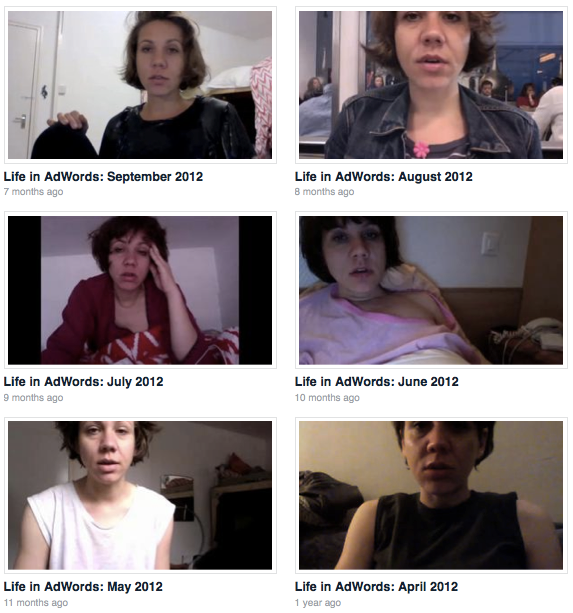
Despite this, my feeling is that opting out – if it’s even possible – can be a way of pretending none of this stuff is happening. I’m generally more interested in finding ways of working with the logic of the system, in this case the use of algorithms to sell things back to us, and making it overly obvious or visible. Geert Lovink asked whether its possible for artists to adopt an “amoral position and see control as an environment one can navigate through instead of merely condemn it as a tool in the hands of authorities” and his suggestion of using Google to do the ‘work’ of dissemination for you, in spreading your meme/ word/ image, is one I’ve thought about, particularly in other works (especially Woman Nature Alone). This approach entails hijacking the process by which Google’s algorithms organise the hierarchy of visibility to one’s own ends – a ‘natural language’ hack, as Lovink puts it.
In contrast, Life in AdWords makes visible the working of the algorithmic system more on the level of the language it produces. It also employs humour, and laughter has been one of the main responses people have had when watching the videos, for a number of reasons. The frequent dumbness of the language and/ or the juxtapositions (‘Where is God?’, ‘Eating Disorder Program’); the flattening out of all difference between objects/ feelings/ places (e.g. work-related stress, cat food, God, Krakow); and the lack of shame the software exhibits in enumerating bodily and mental malfunctions (blood in poop, wet bed, fear of vomiting) are all quite amusing in and of themselves.
That shameless aspect also echoes the over-sharing and ‘too much information’ tendencies the web (especially social media) seems to encourage, which Rob Horning has written about in his excellent blog, Marginal Utility. It also foregrounds that whatever the algorithms can do, what they still can’t do is emulate the codes of behaviour governing human interaction – including knowing when to shut up about your ‘issues’.
The frequent allusions to these bodily and mental blockages also point to the limits of the productivity imperative – a refusal to perform enacted through minor breakdowns – while bringing it back to an embodied subject, who despite her immersion in networked space is still a body with messy, inefficient feelings, needs and urges. And the comically limited portrait the keywords paint maybe suggests that despite the best efforts of Web 2.0 companies, we still are not quite reducible to a list of consumer preferences and lifestyles.
MG: What are you up to at the monment?
ES: Amongst other things I’m doing a residency with Field Broadcast (artists Rebecca Birch and Rob Smith) called Domestic Pursuits, a project which ‘considers the domestic contexts of broadcast reception and the infrastructure that enables its transmission.’
And I’m working on some drawings plus a video involving Skype meditation with members of the Insight Timer meditation app community, for A Small Hiccup, curated by George Vasey and opening 24th May at Grand Union, Birmingham- the video is being shown online tommorrow.
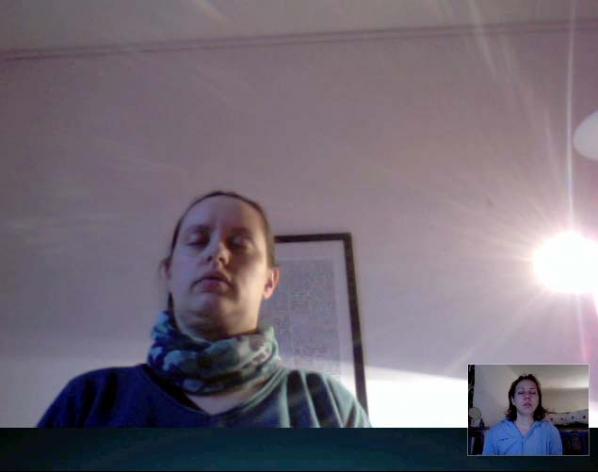
Also I’m attempting and mostly failing at the moment to write my dissertation for the MRes in Moving Image Art I’m doing at Central St Martins and LUX.
Personal Web searching in the age of semantic capitalism: Diagnosing the mechanisms of personalisation. Martin Feuz, Matthew Fuller, and Felix Stalder.
http://firstmonday.org/article/view/3344/2766
Live Performance. KONRAD BECKER (aka Monoton) featuring SELA 3 themes from “OPERATIONS” (15 min.). Published on Jul 9, 2012. YouTube.
http://www.youtube.com/watch?v=HMscYTAF4wY
Erica Scourti was born in Athens, Greece in 1980 and now lives in London. After a year studying Chemistry at UCL, an art and fashion foundation and a year of Fine Art Textiles at Goldsmiths, she completed her BA in Fine Art at Middlesex University in 2003 and is currently enrolled on a Research degree (Masters) in Moving Image Art at Central Saint Martin’s College of Art & Design, run in conjunction with LUX. Her area of research is the figure of the female fool in performative video works.
She works with video, drawing and text, and her work has been screened internationally at museums like the Museo Reine Sofia, Kunstmuseum Bonn and Jeu de Paume Museum, as well as festivals such as the Recontres Internationales, interfilm Berlin, ZEBRA Film Festival, Antimatter, Impakt, MediaArt Friesland, 700IS as well as extensively in the UK, where she won Best Video at Radical Reels Film Competition; recent screenings include Video Salon Art Prize, Exeter Phoenix, Bureau Gallery, Tyneside Cinema and Sheffield Fringe Festival.
Her work has also been published in anthologies of moving image work like Best of Purescreen (vols 1, 2 and 3) and The Centre of Attention Biannual magazine.
more info – http://www.ericascourti.com/art_pages/biography.html
Some have proposed Jennifer Chan to be part of what has been termed as the post-internet era. But, this is an inadequate representation of the spirit, criticality and adventure at play in her work. Chan’s awareness and use of the Internet reflects a way of life, that situates its networks as a primary resource. Chan lives amongst various worlds and engages in different shades of being; a self-described ‘amateur cultural critic’, a net artist, a media artist, and academic. Her work exists both online and in physical realms, it is always present and contemporary. This is because her work lives in a world where the scripting of official art definitions loses its power. People have exploited technology to facilitate new behaviours where the artist or art amateur redefine what art is on their own terms. We are now in a post-art context. It reflects a very real, societal shift. Mainstream art culture no longer owns the consciousness of art, Chan and others like her are pulling it apart.
Marc Garrett: In your video Interpassivity a kind of docu-performance made for the exhibition REALCORE, you’re in a park spraying a brown cardboard box, silver. As you go through the process of walking around the box whilst spraying it, you comment on the object’s formal aspects. But, what you mainly discuss are your own personal views about contemporary art. It then becomes apparent that the box is a prop for the performance, enabling the subject to be explored.
Alongside your interpretations of the work my own thoughts on the subject feel as though they are included in the conversation. I know as a viewer, that the artist is not aware of my thoughts on the matter. However, it feels like there is space for me to be a part of the conversation. Not literally through a feedback system or interaction, but as an individual considering your personal questions. The artwork knows I am experiencing it, it knows that a consciousness out there is somehow engaging with its dialogue.
It is clear you are in tune with the feeling of dysfunction. You say, “I need to spit out some creative truth”. On hearing this, I was not sure whether this was a parady, irony or an expression of despair, or all these. You also say “contemporary art is removed from our everyday feelings”. As you express these words I begin the view the box as a symbol of contemporary art as a centralized, institutional monolith? So, before I unwittingly place my own meanings onto the work could you tell us what it means to you?
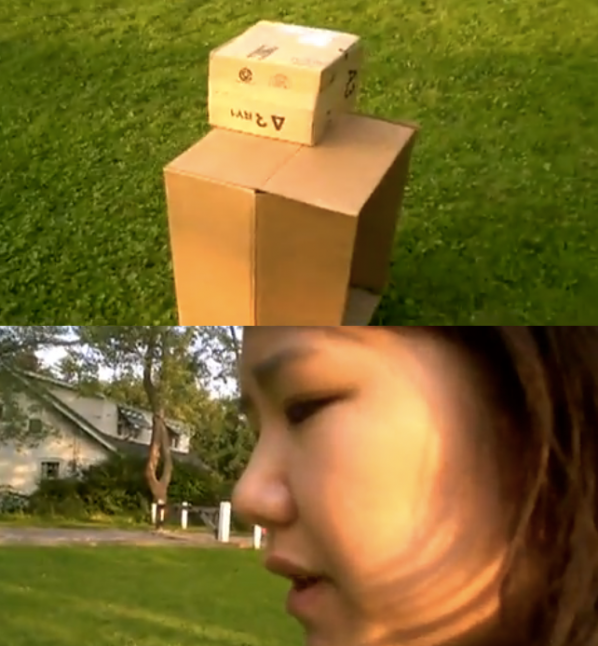
Jennifer Chan: Interpassivity is the instance of something cueing an audience to feel a certain way, such as canned laughter to stand in for humoured social reaction to jokes in a sitcom– even when it’s not funny. I titled it that because I felt like another art student trying to convince herself or the viewer what she made is art. I feel embarrassed about this self-aware but privileged complaining. A few people have found this work online and screened it, but I’m still mortified to watch it with them.
I made that video because I think a lot of contemporary art is sterile, mannered and removed from emotion. I wasn’t thinking of Donald Judd at that point but I could see the box standing in as a poor attempt at work, like his work. What I was working on (or seven years of art education) had little to do with what was happening in my life. (So to answer your question, yes, it is despair) Using my flipcam and talking over it was immediate for recording those ideas. It’s also a big trope of Canadian video art… a breathy voiceover conveys something serious and personal.
re: REALCORE. The title came about as a play on the idea of “real life”, or face-to-face life away from keyboard. Likewise, users would say “irl”(in real life), or “so real~” in Facebook comment threads to joke about the divide between online/offline contexts. The curator David Hanes felt the video was important to contextualize my use of sincerity and clichés, I was not being ironic in my intention. Arielle Gavin and Jaakko Pallasvuo thought it was questionably ironic and an emotive perspective on the Internet as a form of new sincerity.
I later found that someone wrote a paper by someone who coined “realcore” as a kind of amateur user-generated porn, which is a cool double-meaning. The “interpassivity” video was used to promote the show online but I showed my kitschy found footage videos on twisted pizza box plinths for the show. This was my fuck-you to geometric minimalism and boring white plinths, but I suppose it resulted in a different take of it…
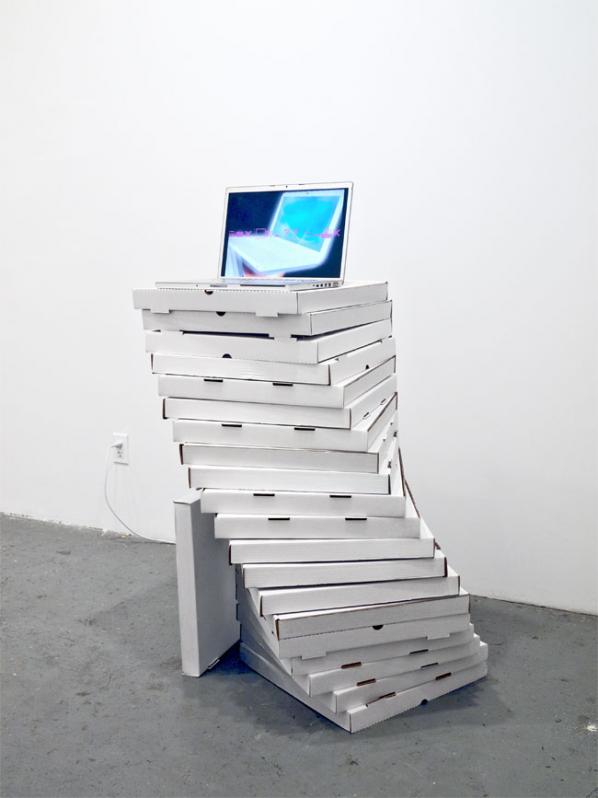
MG: In one of your recent videos “Grey Matter” when watching it felt like I was immediately pulled into a remixed world of teenage celebrity, products and brands, dripping in an orgasmic noise of techno-capitalism. Most of it is found footage, images, video and sound remixed into an edited compilation. Running through the video in between the high octane fuelled cuts and glitches, are messages to the Internet user who chances upon the video. These messages feel like they are from an individual voice but also of a multitude – caught up in a constant state of mediated folk hedonism.
What intentions lie behind this work as an artistic explorer of the entertainment culture you have remixed?
JC: Grey Matter is a first person account on feeling politically inactive online while having access to a wealth of information. I wanted to use remix in a confessional manner, so I combined obscure nostalgic media with embarrassing statements. The video begins with sped up footage of early 3D simulator ride called “Millennium Bug”. Y2K was the first technological “crisis” I recalled with clarity when I was growing up. The rest of the video includes cynical commentary on online spaces I’ve engaged with in the past year. (shopping on aliexpress.com and lurking people on OkCupid) “Little Prince” is compressed 25 times and sped up by 400%. I included old profile pics and some summary text from my OkCupid profile–I thought it was quite telling about how I wanted to be seen online and irl. I think it’s possible to feel mutually exclusive feelings at the same time, or maybe the experience of being active on different social networks produces a kind of schizophrenia. Collaging Internet pop culture is a way to appreciate it-as artifacts-in a complex light, and to be critical of it by acting out within its language.
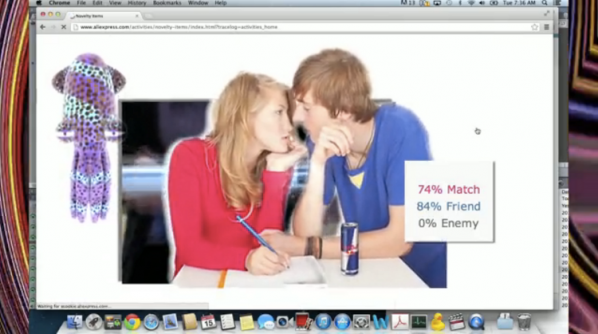
MG: What do you find fascinating about popular culture on the Internet?
JC: Anything minuscule has the potential to be popular amongst disparate users and they form vernaculars to talk about their interest in that. I find that desire relatable. That is what I think of as “community” online. It’s based on human interest and media fandom. Justin Bieber is made into something of a scapegoat for the first world’s shortcomings; people who like his image/music idolize him, and people who hate him are waiting for him to crack. Both are forms of fanaticism (one based on affinity; the other on hate-watching something.) Supercuts of Justin Bieber hairflips, object crushing fetishists, disease forums, long threads debating a detail…etc. I like the solipsism and intensity of all that.
MG: Can you share with us some of your critical insights and personal pleasures on this subject?
JC: Pop culture is paradoxical and audiences selectively enjoy it. (like teens dancing to hip hop with irreverence to its violent or sexist content.) Consuming and sampling pop allows people to indulge into its meanings, and through this there is a reconsideration of what “the masses” find important. Like the use of “users”, “masses” is what cultural studies calls everyone or everyone except-you. But every “user” has a specific relationship with interfaces and platforms, so they aren’t so homogenous.
Pop culture is also political. There was a time when more people voted for American Idol than the US elections, and if 10,000 people showed up to the 2012 cat video festival, entertainment is generally more seductive than current affairs–until there is a gatekeeping emergency (like mainstream media not covering the early days of Occupy). In terms of “internet pop culture”, perhaps traffic with social networking has overtaken porn and gambling online, but social news is also a kind of entertainment.

MG: Olia Lialina and Dragan Espenschied in their book Digital Folklore they celebrate everyday people’s use of personal computers with “glittering star backgrounds, photos of cute kittens and rainbow gradients”. They value the non-professionalism and amateur spirit that has come about from millions of people enjoying the Internet since it started. There is a difference now, the Internet masses have been shifted and prodded into large web 2.0 frameworks such as Facebook, and an abundance of personal web projects have been lost since.
And, like them do you find reassurance or a personal connection with the Internet Amateurs of the world?
JC: In context of new media art, it’s probably more accurate to think of amateurs as people who don’t self-identify as artists or technicians. What non-artists do with software and video appears facile, sincere, and intuitive. I make amateur-looking work to dialogue with that.. I like to say something dumb to say something serious. Something that’s made simplistically and filled with kitschy references can be packaged as critique that also appeals to non-art audiences.
I caught the tail end of the homepage-o-sphere/webring 1.0 period. Non-artists made personal websites out of a genuine interest in something. tumblr and pinterest is used in a same way today–to collect indiscriminately. Like 2.0 frameworks, the early internet also had free webpage hosting that users relied on (Geocities and Lycos). Personal website design isn’t over either; net artists still make them or bind together to create their own sites (like tightartists.com). I think I have an idea of what you mean though; it was less commercial and there weren’t as many distinct “most-visited” places online.
I made a lot of gothy dark art on DeviantArt before I knew about contemporary art, and my sensibility towards Photoshop was more romantic and impulsive without the baggage of art education. Maybe this “revival” cult of amateur-looking digital folklore happened because I/we exoticize that kind of amateur production. Web vernaculars have also become stylized and this aesthetic is shared with seapunks and filmmakers. Artists need to adapt to that.
MG: What do you feel is still alive and open for everyday online expression and play, in respect of what Lialina and Espenschied perceive as Digital Folklore?
JC: I think a lot of emerging artists have a greater awareness of obsolescence and upgrade culture than we give them credit for–while still complacent to the socialization structures on Facebook. Many seem more interested in navigating these networks to question their inner control mechanisms than overthrowing them or innovating new ones. It can be simple things like friending as many users as possible, looping webcam feeds, archiving and re-uploading banned content on different platforms, having an anonymous/alternate personas/using multiple accounts…etc. People like glitchr and Ian Aleksander Adams are always looking for ways to use a system against its intended functions in the same way jodi did all the cheat moves in max payne CHEATS ONLY. I admire glitch practices for that.
There’s also the possibility for re-appropriating anything to rebrand or critique particular communities. I think Angela Washko and Jaakko Pallasvuo are doing this in a compelling way that covers a large territory between art and Internet culture.
MG: So, what are you working on at the moment?
JC: <–for some reason this sounds less perverted than if I were an old guy doing this to teen girls but its really just as perverse–>
I’m observing what young adult/teen boys do on YouTube: bulking up, performing dares, talking about how to pick up a White/Asian girls etc. I’m also making a video about Asian guys (both diasporic, Asian American, and more specifically, Korean and Taiwanese men) and their interpretations of mediated masculinity. There is something disturbingly tantalizing in terms of how they have learned to look at the webcam as if they are boy band stars yet they are not fully grown men. A lot of this is informed by growing up in Hong Kong, and knowing that fashion and romance, is inspired by many “neighbouring” cultural media from Japan, Korea and Taiwan even though American/British influence is also prominent in the club scene.
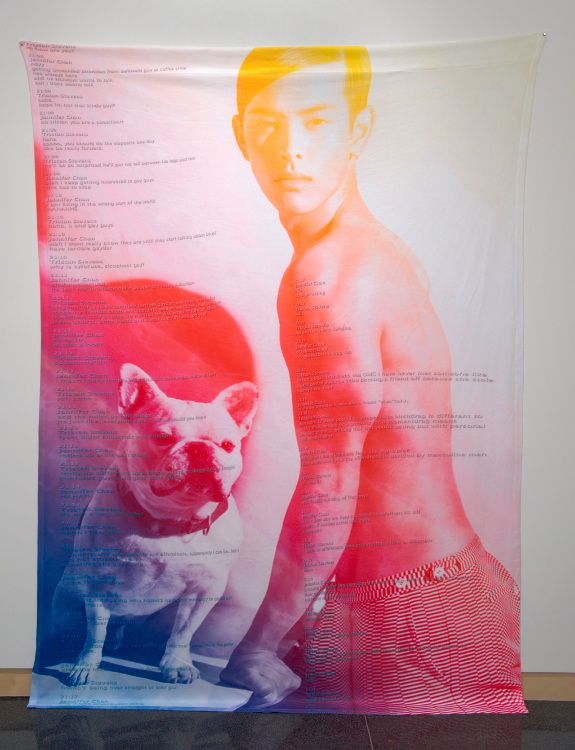
Here are two images from my late installation that will foreshadow this interest. It’s chat text over layered on modified fashion and makeup adverts targeted at Korean and Chinese men, and printed onto micro-fibred bedding. I feel like they’re treated as pleasant freak shows on tumblr but this imagery is a banal, idealized kind of masculinity in Asia. I think western facial features are really common amongst these popular images of Asian-ness, and most would tend to read it as aspiring to western culture, though the hyperfemme “doll” look or metro-masculinity has been a regional style since the 90s.
Chan’s work reflects an emerging condition described by Zizek as “interpassivity” in which our engagement with interactive experience has lost traction and is replaced with “its shadowy and much more uncanny supplement/double “interpassivity””[1], a “Fetish between structure and humanism”[ibid]. We are pulled into a paradox, where ‘interaction and passivity’ are joined together as spectacle of constant mediation. Millions have joined online centralized, megastructures such as Facebook, and this is not a black and white situation. Many are coerced from social and consumer pressures into the state of being seen as interacting. As the futuristic time machine streams onwards at high-speed, agency slouches into a spurious and distant dream. Others and the same are enjoying the flow for the sake of self expression within these scripted frameworks.
Chan’s work critiques, plays with, and exploits this networked, social intervention, as well as her viewers’ desires. Her imaginative palette revivifies questions about agency, passivity, sexuality, privacy, individuality, behaviour, networked consumption and its production. These remixed artworks have much material to work with, as the endless ether of everyday noise is uploaded and distributed through blogs and social networking sites; then returned into the ether as cut-ups where a transforming culture is engaged in its own mutation.
Its noise engages us whether we enjoy it or not, in the medium of “interpassivity”, and we all find ourselves caught within this spectacular enticement driven by the Netopticon. “On a holiday trip, it is quite common to feel a superego compulsion to enjoy, one “must have fun” — one feels guilty if one doesn’t enjoy it.”[ibid]
Jennifer Chan – http://www.jennifer-chan.com/
Heavy MetaVernacular video after the popularization of the internet
http://jennifer-chan.com/index.php?/curatorial/heavy-meta/
SELF-LOVE A non-consensual exhibition of emerging net art
http://jennifer-chan.com/index.php?/curatorial/self-love/
New Insularity Peer backpatting. A screening of works by friends and users whose works I admire.
http://jennifer-chan.com/newinsularity.html
Feeling VideoThe affective appeal of antisocial video
http://jennifer-chan.com/index.php?/curatorial/feeling-video/
Trivial Pursuits Distracting “new media art”
http://jennifer-chan.com/index.php?/curatorial/trivial-pursuits/
Curated by Rosa Menkman & Furtherfield.
Opening Event: Saturday 8 June 2013, 2-5pm
with Glitch Performance by Antonio Roberts at 3pm
Open Friday to Sunday 11-5pmContact: info@furtherfield.org
DOWNLOAD PRESS RELEASE
IMAGES OF THE OPENING ON FLICKR
READ Glitch as a Symbolic Art Form BY ROB MYERS
WATCH VIDEO OF THE OPENING
“The glitch makes the computer itself suddenly appear unconventionally deep, in contrast to the more banal, predictable surface-level behaviours of ‘normal’ machines and systems. In this way, glitches announce a crazy and dangerous kind of moment(um) instantiated and dictated by the machine itself.” Rosa Menkman [1]
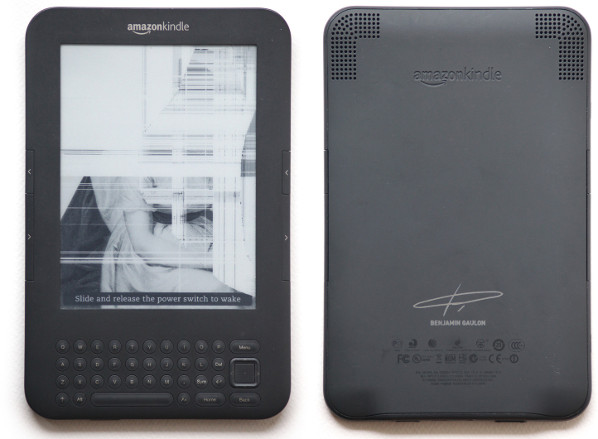
Glitches are commonly understood as malfunctions, bugs or sudden disruptions to the normal running of machine hardware and computer networks. Artists have been tweaking these technologies to deliberately produce glitches that generate new meanings and forms. The high-speed networks of creation and distribution across the Internet have provided the perfect compost to feed this international craze. The exhibition shows various approaches by artists hacking familiar hardware and their devices which include mobile phones, and kindles. They disrupt both the softwares and the digital artefacts produced by these softwares, whether it be in the form of video, sound and woven glitch textiles.
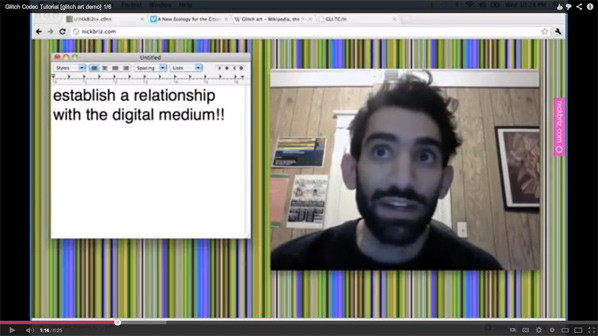
Glitch art subverts the way in which we are supposed to relate to technology, causing playful, imaginative disruptions. It is a low-tech and dirty media approach with a punk attitude. These artists appropriate the medium and forge expressions that go beyond what the mainstream art world expects artists to do, it is unstoppable – it is Glitch Moment/ums.
Copies of Rosa Menkman’s groundbreaking Glitch Art critique The Glitch Moment(um) will be available for purchase during the exhibition.
![numbermunchers from the untitled [screencaptures] series by Melissa Barron](http://www.furtherfield.org/wp-content/uploads/2013/04/melissabarton.jpg)
Empty Spinning Circle become Full (part b) (2012) from the Further Abstract series by Alma Alloro
One Square in colors (2012) from the Further Abstract series by Alma Alloro
untitled [screencaptures] (2010) by Melissa Barron
The Glitch Codec Tutorial by Nick Briz
KindleGlitched (2012) by Benjamin Gaulon
Thoreau Glitch Portrait (2011) by José Irion Neto
Copyright Atrophy (2013) by Antonio Roberts
What Revolution? (2011) by Antonio Roberts
Beyond Yes and No (2013) by Ant Scott
Glitch artists and enthusiasts are invited to add their work to GLI.TC/H 0p3nr3p0.net, a Glitch Art repository coded by and developed by Joseph ‘Yølk’ Chiocchi & Nick Briz. The submissions will be showcased during Glitch Moment/ums at Furtherfield Gallery. To include your work in the 0P3NR3P0 component of Glitch Moment/ums submit a link to any visually wwweb based file (html, jpg, gif, youtube, vimeo, etc.) and your piece will automatically be included in the line-up (one work per artist).
This new IRL exhibition has been organised in collaboration with Nick Briz and Joseph ‘Yølk’ Chiocchi.
SUBMIT && SHOW on 0P3NR3P0.NET.
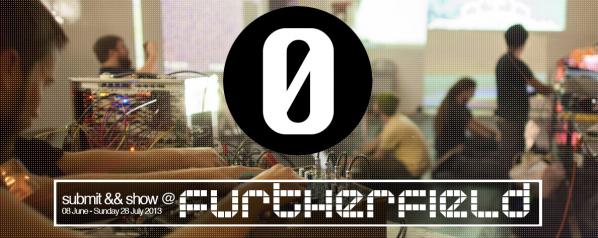
Alma Alloro
Alma Alloro (IL) is an artist, musician and performer from Tel Aviv. She is rooted in the backyard of popular culture using diversified media from drawing, installation, music, and animation to internet; her recent works focus on the correlation between old media and new media.
Melissa Barron
Melissa Barron is an artist living and working in Minneapolis, Minnesota. She studied at the School of the Art Institute of Chicago where she focused on new media and fiber. In her work she combines these two fields by reinterpreting hacked Apple 2 software through different fiber techniques. Her work has been shown at various international events, including the Notacon hack festival in Cleveland, Ohio, GLI.TC/H in Chicago and ISEA 2011 in Instabul.
Nick Briz
Nick Briz is a newmedia artist, educator and organiser based in Chicago IL. His work has been shown internationally at festivals and institutions, including the FILE Media Arts Festival (Rio de Janeiro, BR); Miami Art Basel; the Images Festival (Toronto, CA) and the Museum of Moving Image (NYC). He has lectured and organized events at numerous institutions including STEIM (Amsterdam, NL), the Museum of Contemporary Art Chicago, Marwen Foundation and the School of the Art Institute of Chicago. His work is distributed through Video Out Distribution (Vancouver, CA) as well as openly and freely on the web.
Benjamin Gaulon
Benjamin Gaulon is an artist, researcher and art college lecturer. He has previously released work under the name “Recyclism”. His research focuses on the limits and failures of information and communication technologies; planned obsolescence, consumerism and disposable society; ownership and privacy; through the exploration of détournement, hacking and recycling. His projects can be softwares, installations, pieces of hardware, web based projects, interactive works and are, when applicable, open source.
José Irion Neto
José Irion Neto is native of Santa Maria, in southern Brazil. His first contact with computers was in 1982 using a machine equivalent to Sinclair ZX Spectrum. He has an academic background in Media Advertising and worked for some years as a Graphic Designer. Today, he has been working with advertising only occasionally, focusing on creating posters, dedicating most of his time on developing Glitch Art. He has worked and researched Glitch since 2008.
Antonio Roberts
Antonio Roberts is a British digital artist whose artwork focuses on the errors and glitches generated by digital technology. Many people would simply discard such artefacts but Antonio preserves these errors and displays them as art. With his roots in free culture he develops his techniques using open source and freely available software and shares his knowledge through the development of software.
Ant Scott
Ant Scott (UK) is a glitch artist and co-author of the first glitch aesthetics coffee table book Glitch: Designing Imperfection (New York: MBP, 2009). His work is informed by cognitive distortions.
Rosa Menkman
Rosa Menkman is a Dutch visualist who focuses on visual artifacts created by accidents in digital media. The visuals she makes are the result of glitches, compressions, feedback and other forms of noise. By combining both her practical as well as an academic background, she merges her abstract pieces within a grand theory artifacts (a glitch studies), in which she strives for new forms of conceptual synthesis of the two. In 2011 Rosa wrote Glitch Moment/um, a notebook on the exploitation and popularization of glitch artifacts (published by the Institute of Network Cultures), organized the GLI.TC/H festivals in both Chicago and Amsterdam and co-curated the Aesthetics Symposium of Transmediale 2012.
Furtherfield Gallery
McKenzie Pavilion, Finsbury Park
London N4 2NQ
T: +44 (0)20 8802 2827
E: info@furtherfield.org
Furtherfield Gallery is supported by Haringey Council and Arts Council England
MOVABLE BORDERS: THE REPOSITION MATRIX workshop
organised by Dave Young
Saturday 18 May 2013, 1-5pm
BOOKING ESSENTIAL. Please register with Alessandra.
The devices that once populated the creepy dystopian futures of science fiction have broken through into our daily reality.
Drones of dozens of different types are becoming a part of everyday life. They scout our public (and private) spaces, carrying out surveillance or reconnaissance in the service of nation states and as unmanned robotic tools, armed with missiles and bombs, acting in defence of “national security”.
According to a European commission document drones will be commonplace in the skies within a decade. There are already many companies building these airborne, robotic spies for military and police use and this has “prompted concerns from civil liberties groups, who fear that the unmanned aircraft will result in more forms of surveillance.” [1]
During the three weeks of Movable Borders: Here Come the Drones! people are invited to view artworks and join a workshop by artists who are contemplating how drones are changing the way we see and relate to each other and the world around us.
Artworks and projects by Bureau of Inverse Technology (US & AU), Lawrence Bird (US), Patrick Lichty (US), Dave Miller & Gavin Stewart (UK), The Force of Freedom (NL) and Dave Young (NL).
Bit Plane by Bureau of Inverse Technology (Natalie Jeremijenko and Kate Rich) is an early artistic reflection on the relation between technology and surveillance and, as such it can be seen as a precursor to the emerging DIY surveillance video enabled by the new availability of drones. The bit plane is a radio-controlled model airplane, designed by the Bureau and equipped with a micro-video camera and transmitter. In 1997 it was launched on a series of sorties over the Silicon Valley to capture an aerial rendering. Guided by the live control-view video feed from
the plane, the pilot on the ground was able to steer the unit deep into the glittering heartlands of the Information Age.
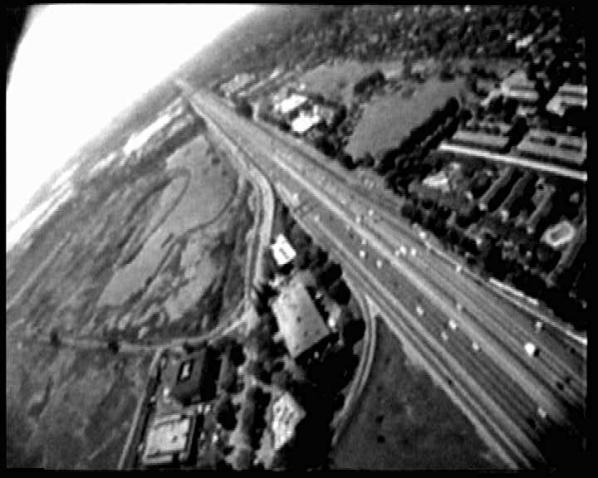
Parallel by Lawrence Bird uses Google Earth to track the 49th parallel, i.e. the prairie border between Canada and the United States. The digital projection invites open interpretations: it is a film about parallel countries; parallel modes of imaging and imagining; parallels between political, technical and visual territories. Obvious digital anomalies in the video, caused by satellite interference, allow for further speculation and imaginative readings.
The Private Life of a Drone by Patrick Lichty is a video travelogue recorded by flying video drones, exploring the area surrounding the Virginia Center for the Creative Arts in Amherst, Virginia (US).
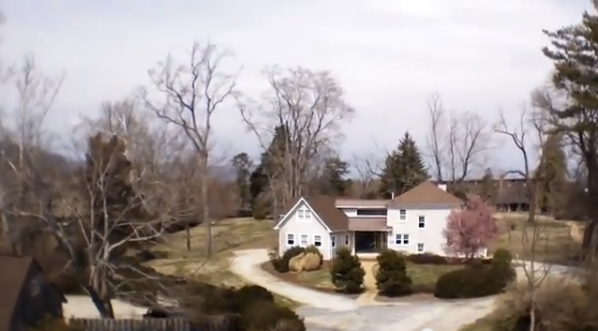
Lines by Dave Miller and Gavin Stewart draws on an emergent cultural interest in drones to explore related issues around privacy, mediation, power, security, morality, legality and others in all aspects of contemporary life. Lines aims to encourage and affect public debate.
TELEWAR is a book and video collaboration between Dave Young and The Force Of Freedom collective. The project tries to make some sense of the uses, effects and developments of the new warfare technologies, like military drones, through the analysis of news reports, military drone culture, drone speak and network theory.
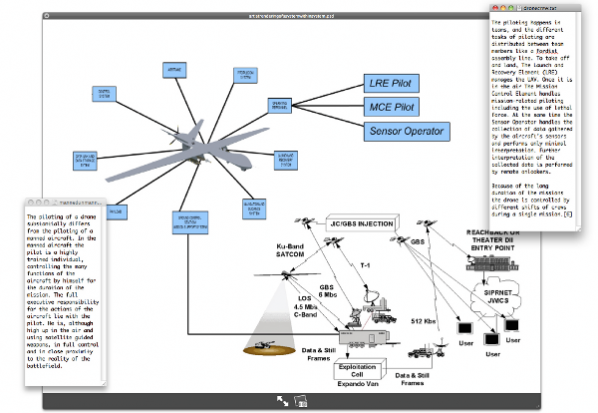
Movable Borders – The Reposition Matrix by Dave Young provides the central installation and information resource of the exhibition.
In a post-national age, where “territorial and political boundaries are increasingly permeable”[2], what has become of the borderline? How is it defined, and what technologies are used to control it?
Movable Borders is an ongoing research project that begins to explore possible answers to these questions through facilitating discussions around the ‘reterritorialisation’ of the borderline in the information age.
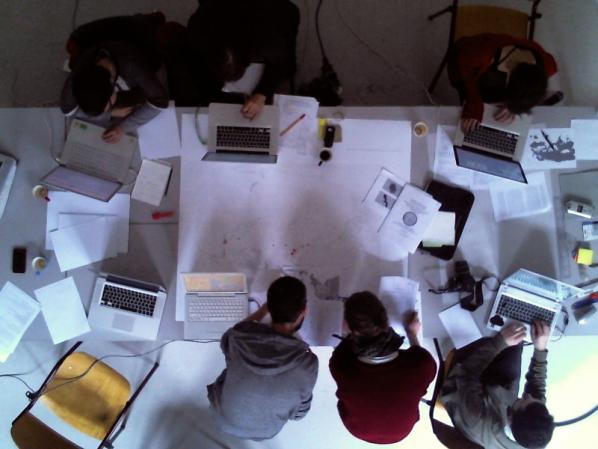
The Reposition Matrix aims to reterritorialise the drone as a physical, industrially-produced technology of war through the creation of an open-access database: a ‘reposition matrix’ that geopolitically situates the organisations, locations, and trading networks that play a role in the production of military drone technologies.
Alongside the installation Dave Young will be holding a workshop on the subject of drones on Saturday 18 May, 1-5pm – BOOKING ESSENTIAL. More info here.
Lawrence Bird
Lawrence Bird is a designer, instructor and writer with an interest in cities and their image. He has trained in architecture (B.Arch), social sciences and urban design (MSc), and history and theory of architecture (PhD). He has recently completed the SSHRC-funded postdoctoral project Beyond the Desert of the Real, based in Winnipeg, Canada. The project focused on desolate urban sites, elicited visual narratives from city residents and graduate students of architecture in response to them, experimented with representations of the city based on these narratives, and used these strategies as points of departure for urban design and urban landscape proposals. Lawrence also makes films, and is currently developing a hybrid film and animation project WPG_POV.
Bureau of Inverse Technology
The Bureau of Inverse Technology (aka BIT) is an organisation of artist-engineers whose stated aim is to be an information agency servicing the “Information Age”. Bureau engineers are involved from design to deployment and documentation of radical products based on commercially available electronic entertainment components such as cameras, radios, networks, robots, sensors, etc. Though its work has long been publicly available, the composition of the Bureau itself is shrouded in some mystery, for some years cloaking its identity in anonymity. In 2004 the Bureau initiated a “retreat from anonymity” when radio journalist and BIT co-founder Kate Rich took up a three month Research Fellowship at Piet Zwart Institute for Media Design Research, Rotterdam in 2004. Current Bureau products include BIT Radio, Feral Robotic Dogs and the Despondency Index.
Patrick Lichty
is a technologically-based conceptual artist, writer, independent curator, animator for the activist group The Yes Men, and Executive Editor of Intelligent Agent Magazine. He began showing technological media art in 1989, and deals with works and writing that explore the social relations between us and media. Venues in which Lichty has been involved with solo and collaborative works include the Whitney & Turin Biennials, Maribor Triennial, Performa Performance Biennial, Ars Electronica, and the International Symposium on the Electronic Arts (ISEA). Patrick also works extensively with virtual worlds, including Second Life, and his work, both solo and with his performance art group Second Front, has been featured in Flash Art, Eikon Milan and ArtNews. He is also an Assistant Professor of Interactive Arts & Media at Columbia College Chicago, and resides in Baton Rouge, LA.
Dave Miller
Dave Miller is a South London based artist and currently a Research Fellow in Augmented Reality at the University of Bedfordshire. Through his art practice Dave draws out the invisible forces that make life difficult. His work is about caring and being angry as an artist. His art enables him to express feelings about the world, to attempt to explain things in a meaningful, yet subjective way, and make complex information accessible. Recurrent themes in his work are: human stories, injustices, contentious issues and campaigning. Recently he has been very bothered by the financial crisis.
Gavin Stewart
Gavin Stewart is Lecturer in Digital Media at the University of Bedfordshire, poet and writer. He is the current convener of the Interactive Media Group. His research interests are the aesthetics of digital texts and the impact of corporate digital media on our understanding of community. Gavin is course leader in BA Media Production and currently teaches units in Media and Cyberculture and Print, Culture and Technology at MA Level. Gavin is is also the co-organiser of the Playful Paradox mini-festival, the End of Journalism conference and the Under the Mask: Perspective on the Gamer conference series.
The Force Of Freedom
The Force Of Freedom is a Rotterdam based collective founded by Micha Prinsen and Roel Roscam Abbing in 2009. In their work they react critically but playfully to new emerging technologies and developments on the internet.
Dave Young
Dave Young is an artist, musician and researcher currently studying the Networked Media course at the Piet Zwart Institute in Rotterdam (NL). His research deals with the Cold War history of networked culture, exploring the emergence of cybernetic theory as an ideology of the information age and the influence of military technologies on popular culture.
Furtherfield Gallery
McKenzie Pavilion, Finsbury Park
London N4 2NQ
T: +44 (0)20 8802 2827
E: info@furtherfield.org
Furtherfield Gallery is supported by Haringey Council and Arts Council England.
Featured image: Five Thousand Feet is the Best by Omer Fast.
In perusing Honor Harger’s recent missive on drone aesthetics and James Bridle’s ongoing posts of drone images at Dronestagram, taken in context with the Glitch un-conference in Chicago, some new questions have come to mind. These questions have to do with conceptions of New Aesthetics in its various forms in terms of interaction with the program/device and its level of autonomy from the user. In my mind, there seems to be a NA continuum from generative programs that operate under the strict criteria of the programmer to the often-autonomous actions of drones and planetary rovers. As you can see, I am still chewing on the idea that The New Aesthetic as it seems to be defined, as encompassing all semi-autonomous aspects of ‘computer vision’. This includes Glitch, Algorism, Drone imagery, satellite photography and face recognition, and it’s sometimes a tough nugget to swallow that resonates with me on a number of levels.
First, image-creating technological agents are far from new, as Darko Fritz recently stated in a talk that algorithms have been creating images, in my opinion, within criteria of NA since the 60’s, and pioneers like Frieder Nake, A. Michael Noll, and Roman Verostko have been exploring algorithmic agency for decades. If we take these computer art pioneers into account, one can argue that NA has existed since the 60’s if one lumps in genres like Verostko’s ‘style’ of Algorism or the use of algorithms as aesthetic choice. A notch along the continuum toward the ‘fire and forget’ imaging (e.g. drones) is the Glitch contingent, which is less deterministic about their methodologies of data corruption aesthetics by either running a program that corrupts the media or they perform digital vivisection and watch what little monster they’ve created. Glitchers exhibit less control over their processes, and are much more akin to John Cage, Dada or Fluxus artists in their allowance of whimsical or chance elements in their media.

However, as we slide along the spectrum of control/autonomy from the lockstep control of code to the less deterministic aesthetics of face recognition, drone imaging, robotic cameras, Google Street View cams, Mars Rovers and satellite imaging, things get murkier. Autonomic aesthetics remind me of the ruby-hued Terminator T500 vision generated by intelligent agents running the ‘housekeeping’ on the machine platform. I consider this continuum from Algorism to Glitch to autonomous robotic agents under an NA continuum of aesthetics is important insofar as it defines a balance of agency between the operator and the ‘tool’. For me this is the difference between the high degree of control of the Algorist, the ‘twiddle and tweak’ sensibility of the Glitcher, and the gleaning from the database of pseudo-autonomous images created by Big Imaging created by drones and automatic imaging. Notice I use the term ‘pseudo’ in that there are operators flying the platforms or driving the car, while the on-board agents take care of issues like pattern/face recognition and target acquisition. We also see this in Facebook, as recent technological changes as of 2012 have introduced face recognition in the tagging of images. From this, a key issue for me in this discussion of what began as a nebulous set of terms (the criteria of NA as defined by the global conversation) is that of agency and autonomy, and how much control the New Aestheticist gets in the execution of their process. Another important point is that I am not calling the ‘New Aestheticist’ an artist or curator, but something in between, but I’ll get to that later as this is also an issue of control of intent.
Back to this idea of autonomy between the subject, the ‘curator’ and the viewer, what interests me is the degree of control or not that the person creating, tweaking, or gleaning the image has over the creation or contextualization of that image. In the case of the Algorist, this is the Control end of the spectrum, where the artist takes nearly full control of the process of creation of the image, unless there is a randomization function involved in the process, and that it itself is a form of control – very Cybernetic in nature. Agency is at a maximum here, as the artist and machine are in partnership. Roman Verostko is a prime example of this, as he explores intricate recursive images created by ink pen plotters using paints in the pens. What he, and the AI-driven AARON, by Harold Cohen, for that matter, are machine painting.
The next step down the autonomy spectrum would involve the use of ‘glitch’ tools and processes that distort, disturb, and warp digital media. The process involves executing a given intervention upon the medium, such as saving it improperly, hex editing its code to corrupt it, or as Caleb Kelly writes, ‘crack’ the media. There are differing degrees of disturbance of the media to inject chance processes into it, from a more ‘algoristic’/programmatic application of programs upon the media to directly changing the internal data structure through manipulating the information through hex code and text editors. The resultant process is an iterative ‘tweak and test’ methodology that still involves the user in the process to varying degrees. Of course, the direct manipulation of the data with a hex editor is the most intimate of the processes, but there is still one factor to account for. The factor in question is that there is the set of causes and effects that are set in motion when the artist/operator opens the media and the codec (Compressor/DECompressor) mis/interprets the media, as is intended by the artist.
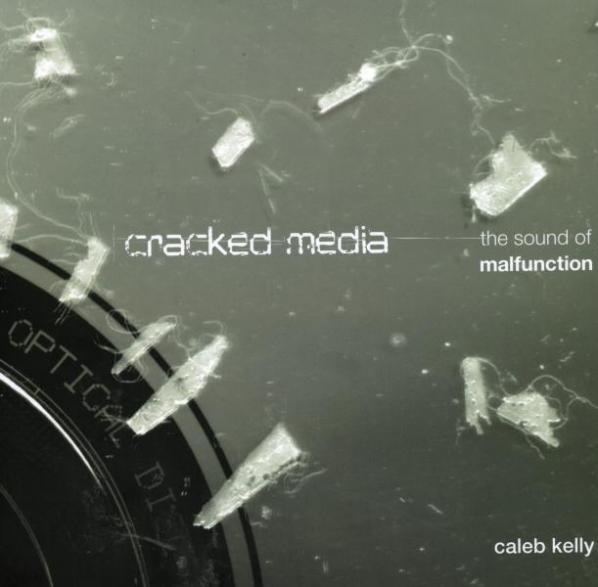
If we are to look at the glitch process, we can say that there is a point of intervention/disturbance upon the media, which is entirely a function of control on the part of the user. Afterwards, it is set loose into the system to allow the corruptions within the media to trigger chance/autonomous operations in its interpretation in the browser, etc. This is where the glitcher straddles the line between control and autonomy, as they manually insert noise into their media (control), then the codecs struggle with the ‘cracked’ media (autonomy). The glitcher, then, has the option to try a new iteration, thereby making the process cybernetic in nature. In Glitch, there is a conversation between the operator, the media and the codec. With the aesthetics created by drones, algorithmic recognition software, and satellite reconstructions, the process is far more autonomous/disjoint, and the New Aestheticist has to deal with this in the construction of their practice.
In the genre that I will call ‘mobEYEle’ imaging, the robot, satellite, or parabolic street eye abstracts from the ‘artist’, aptly turning them into an ‘aestheticist’, as their level of control is defined as that of a gleaner/pattern recognizer from the image bank of Big Data. Rhetorically speaking, we could say that a connection between the aestheticist and the generator of the image would be less abstract if, say, a New Aestheticist were to be in the room with a drone pilot, conversing about points of interest. It is likely that a military remote pilot and a graphic designer would have sharply differing views as to what constitutes a ‘target of interest’. Like that’s going to happen…
Therefore, let us just say that the collaboration of a New Aestheticist and a drone pilot is nightly unlikely, and that the New Aestheticist is therefore abstracted from the decisions of command and control involved in acquiring the image that eventually gets in their hands. This, however, presents us with two levels of autonomous agency, one human and one algotrithmic. But before I expand on this, I would like to discuss my decision to call the practitioner an ‘aestheticist’ as opposed to an artist or curator.
This decision rests on what I feel is the function of the aestheticist, that is, to glean value from an image and ‘ascribe’ an aesthetic to it. This position puts them in a murky locus between artist and curator, as they have elements of neither and both. For example, does the drone-image NA practitioner create the image; are they the artist per se, of the image? No. Although they are more closely aligned to curatorial practice as they collect, filter (to paraphrase Anne-Marie Schleiner), and post on tumblrs and Pinterests? From my perspective, the role of a curator is the suggestion of taste through and informed subjectivity through ecologies of trust and legitimacy, but the social image aggregator, although they might want to perform the same function, has no guarantee of accomplishing this unless they develop a following. Therefore, under my definition, they are neither creators nor taste-makers in the traditional sense, so what makes sense is to call them ‘aggregators’ of aesthetic material and thus my term ‘Aestheticist’.
Returning to our conversation, the drone aestheticist, then, is subject to one of two degrees of completely abstracted autonomy of the creation of the image; that of the operator or that of the algorithms operating the drone. The abstraction surrounding the human operator is easiest to resolve, as the images of interest are either the preference of the drone operator or those created by the operator under the parameters of the mission, and not the results of a New Aestheticist’s joyride on a Global Hawk. It is merely someone else’s volition selecting the image, and a confluence of personal interest deciding as to whether the image deserves to be on the New Aestheticist’s social imaging organ. However, it is the drone’s algorithmic image acquisition system that creates a more alien perspective in regards to aesthetics and autonomy of the image.
Compared to the Algorist or the Glitcher, all loosely placed under the banner of New Aesthetics, the Drone/Big Data Aestheticist is most problematic, as they are a fetishizer of sheer command and control operations that are potentially utterly abstracted from the pilot/driver’s volition. This creates a double abstraction through first the pilot, and then the algorithmic recognition system. There is no cybernetic loop here at all, as the gleaning of the item of interest from the beach of Big Data is twice removed from any feedback potential. Secondly, as I have written before, the Drone Aestheticist is exactly that, a gleaner of interesting images for use on their social image site, which in itself is a bit of an abject exercise.
Or is it? For example, if one is to say that the Aestheticist gleaning the images does so without intent or politics, and is merely operating on fetish/interest value, then this is perhaps one of the least interesting practices in New Aesthetic practice. But on the other hand, if one looks at the work of practitioners like Jordan Crandall, Trevor Paglen, or Ricardo Dominguez, who examine the acquired image as instrument of aggression, control, and oppression, this puts a new lease on the life of the Drone Aesthetic. In a way, though inquiry, there is an indirect feedback loop established in questioning the gaze of the device, its presence, and its function in its theater of operations. The politics of the New Aesthetic emerges here, in asking what mechanisms of command and control guide the machine eye and determine its targets of interest. This is of utmost importance, as the abstracted eye is guided without subjectivity or ethics and is determined solely by the parameters of its algorithms and the stated goals of its functions.
Is the aesthetic of the machine image merely a function of examining its processes, fetishizing its errors, or something else? The criteria of the New Aesthetic attempts to talk about a spectrum of digital imaging that stretches back into time far longer than 2010, and has a problematically broad sense of definition. Once these problems are set aside as a given, one of the key criteria for the evaluation of NA practice and the function of its images depends upon the degree of control and autonomy inherent in the process within the creation of the image. This is formed in a continuum of control and abstraction from Algorism and Generative Art to autonomous eyes like drones and satellites. Algorism is one of the oldest NA practices, and exhibits the closest relationship between artist, machine and determinacy of digital process. A greater degree of indeterminacy is evident in the Glitch, but the iterative process of tweaking the media and then setting it forth into the process of interpretation by the codec, foregrounds the issue of digital autonomy.
The eye of the unmanned platform abstracts creation from the human organism at least once if a human does not operate it remotely, and twice if it is. There is the Terminator-like fear of the autonomous robot, but at this time, perhaps the more salient questions regarding what I have qualified as drone/autonomous aestheticism under NA of what the function of the image is, and is it really that interesting? Are the practices of NA blurring artistic and curatorial practice into a conceptual aestheticism, creating a cool detachment from the image despite its source or method of creation? Is the bottom line to the genres of NA the degree of control that the artist or aestheticist has over the image’s creation or its modality/intent? It seems that NA is an ongoing reflection upon the continuum of control over the generation of the image, our beliefs regarding its aesthetics, and what the intentions or politics are behind the creation of the New Aesthetic image. Or, as I have written before, are we just pinning images from Big Data and saying, “Isn’t that kinda cool?”
Maybe it’s somewhere in the middle of intention and cool.
Featured image: Journey to Ard al Amal (The Land of Hope). Screenshot box & video installation. Impakt festival & exhibition. Image Pieter Kers
Foundland, Ghalia Elsrakbi (SY) and Lauren Alexander (SA), is a multi-disciplinary art and design practice based in Amsterdam. With backgrounds in graphic design, art and writing Foundland’s approach focuses on research based, critical responses to current issues. While moving around in advertising, printed matter, the Internet, and off line art spaces they dig up interesting stories about Disney, SpongeBob and defected soldiers.
Annet Dekker: Where does the name Foundland come from, or what does it mean?
Lauren Alexander: We started working together in 2009 and at the time we had worked on a project about being stateless, so Foundland seemed fitting. It is quite literally a way of thinking about how to found a land and to create a space that we could use as a platform for thinking about ideas with some kind of visual output. For us, space is related to political scenarios, and also to something virtual, online, all these different places that we inhabit.
Ghalia Elsrakbi: Foundland relates also to finding and discovering something new, looking behind something. We are very interested in speculation, we speculate about images and their meaning, in order to find something unexpected.
AD: What is your focus, what are you trying to find and tell?
LA: We want to tell stories in new ways, because by telling a story in a different way, especially related to subjects which are often seen in the media, you are offering an alternative perspective.
GE: The exhibition we just did for Impakt festival is a good example. With the installation Journey to Ard al Amal (The Land of Hope) we speculated how popular characters and animations, dubbed from Japanese to Arabic, or adapted from Walt Disney, play a valuable role in imagining heroes and villains. We were looking at a history of cartoons. This isn’t obviously political, but when seeing how cartoons are used in Syria and other places, interesting issues came up and we constructed a story that reflected on the current situation. We looked for connections between the way people see cartoon characters now and how they are embedded in childhood memories. In the end what we present is a kind of imagined picture of how things could be, maybe as an alternative to watching the news.
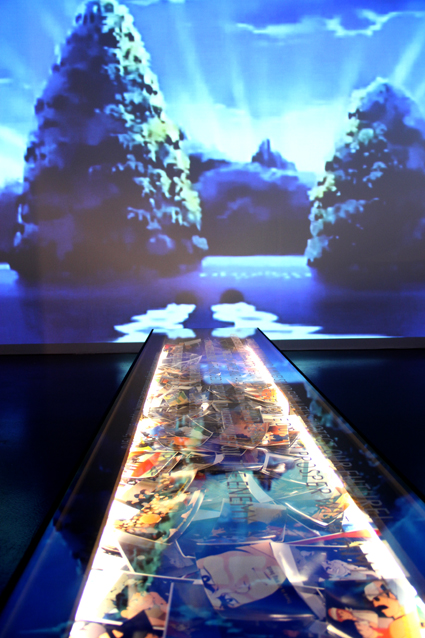
AD: Can you elaborate a bit, what images did you see and how did you (re)use them?
LA: In the installation we focused on this specific case study of the apocalypse scenario which is sketched in a cartoon series called Adnan and Leena in Arabic. In an earlier research essay Simba, the last Prince of Ba’ath country, we extracted images and characters from Arabic websites and speculate on appropriation by showing original images, before they were photoshopped. In a talk we did, we were also drawing connections to the way that Western cartoon characters are suddenly popping up in news footage, and how activists use cartoon identities on the Internet.
GE: Currently there is a full swing of the way Western stories are adapted. For example images of Mickey Mouse or SpongeBob are painted on walls in Syria. In the talk we question whether it is still Mickey Mouse that we see, the one that we remember from our children books, or if it means something else? We compared and related these images to the way such iconography is appropriated and used by both activists and ruling parties. The reuse of symbols and images and how sometimes historical moments are turned into something completely different is very interesting. Such findings are what we are really focusing on.
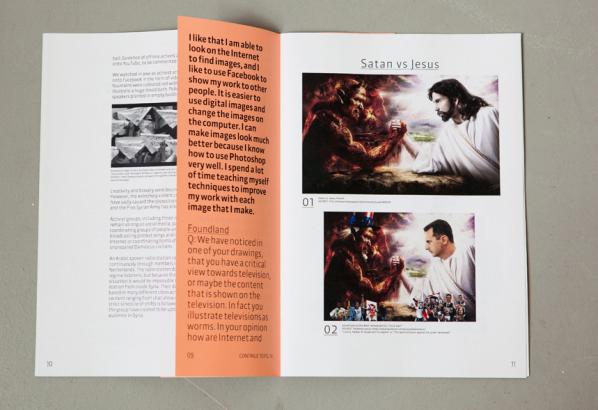
AD: There is also a long and popular tradition of autonomous animation in middle east, how does that relate to what you’ve been researching?
LA: Cartoons are very differently perceived in Syria, and also in South Africa, unlike in the Netherlands, they pose a huge threat to those in charge. For example the government is continuously suing political cartoonists like Ali Farzat in Syria and Zapiro in South Africa because their cartoons undermine existing power structures.
GE: There are indeed many artists who create political cartoons or satirical statements but with these Disney cartoons it was about finding the hidden story of an image. We recognise the cartoons from a Western perspective and the local one. By making connections and telling a different story we want to give a different perspective and a better understanding of what is really happening. Actually I grew up with Japanese Manga, but today Disney is everywhere. This is also political because in the time that Hafez Al-Assad was running Syria there was no American culture at all, when he died his son opened the country a bit for the Western market and you started to see American programmes. Nevertheless, everything is dubbed to Arabic so children don’t necessarily view it as an American production because it speaks their own language and sometimes stories and words are changed in order to better relate to Arabic countries.
LA: The connection to America is not obvious, what we found is that characters like SpongeBob and Mickey Mouse are simply friendly characters. They are your buddy, they help and like you.
GE: That is why they are used in this process of freedom fighting. ‘Your friends’ carrying the freedom flag and are used to create a kind of identification with the message that they want you to see. I mean, it is difficult to hate or not to trust these images because they are icons of friendliness. Whereas the image of a politician or some other hero who is telling a personal story can easily be damaged, a cartoon image is unbreakable. It appeals to children involved in the revolution. So, these images consist of many layers and bring up interesting questions. We aren’t looking for the true answer, because in the end we create our own story.
AD: Could you speak of a sort of universal populism or at least a continuing iconography?
GE: There are many different images, from the Lion and the Father and the Son, to things you see in public space, or images that people grew up with. These are all reused in a digital form and become part of the revolution. People tend to think of them as new images, but when you compare them to older ones, the original, it reflects very much the ideology of the regime. By putting them in a different context we try to force people to question the images and the stories.
LA: I remember that I was in South Africa when we were working on the fiction interview with a propaganda makers text and I had asked my mother to read it. She commented that ‘This is what the government used to say during apartheid, I recognize this’. I guess this shows quite a universal context. We are so used to advertisement and iconography that we don’t question it and tend to ignore the meaning.
GE: Yes, it’s not so different at all, propaganda still uses the same techniques, they have not changed and people fall for it. I think it’s very good to expose propaganda makers.
AD: What new context are you giving it?
LA: Up till now our work has been presented in a western context within the framework of festivals or art spaces.
GE: We wanted to show it to a Western audience, but now we also want to see how it will work when we go to Syria or the Middle East. This will be a challenge because we need to find a way to make that translation back again. We tried already a few times to publish texts for example, but the expectation is very different, stories are more direct and literal, you say exactly what you mean, not the way that we do it here which is reading between the lines.
AD: Is that also why you work in so many ways, from installations, to print, to presentation, to video?
LA: Yes, a lot of this is about experimentation with how things work. We often start from something that we have found online. We find a lot of information, which can be confusing, and then it is about finding the right moment, time and place to present it. Giving it all your attention to dig into an issue, know more and tell more.
GE: Each time we try to define the best way to present what we want to say. It is interesting to open and use the whole research process, it is not just about an end result that is presented. For example, now we are collecting a lot of defection movies from soldiers who are leaving the official army Syrian and joining the free army. What we notice is that the visibility of this free army is that it is only online, on YouTube. We are interested in how an identity of an army that exists on the ground and performs all kinds of operations, primarily takes place on YouTube. The videos of the defectors are almost like a physical performance of defection. We want to collect the story of it, to help people appreciate this image, why it was made, and think about what this means for us.
AD: Digging up memories and confronting people?
GE: When we started the cartoon project we noticed that people were hiding their identity online behind popular cartoon masks. It was really about how people used the Internet.
LA: We discovered that using the Internet is not always about the technical functions of connectivity, distribution, uploading and liking.
GE: If you look for example at how Syrians use the Internet, it’s really for emotional support. A few months ago there was no Internet in the whole of Syria, which was emotionally a big thing because people abroad couldn’t connect to people online and read their contributions. The revolution is nothing without these contacts. All of a sudden a Facebook campaign started called ‘Here is Damascus’. At first I didn’t understand it, but it turned out to be a reference to an event that happened in the 60’s in Cairo, while at war with Israel, the radios were cut off and there was no communication in the city. At that point the city of Damascus changed the name of their radio to ‘Cairo radio’. A political statement, like a re-enactment, happened now on Facebook. The Internet has all these different kinds of layers, of reflecting on history and bringing events to life.
See more Foundland work and updates at www.foundland.info
Featured image: Image from Fab Lab (fabrication laboratory), small-scale workshop offering digital fabrication
There is currently a significant amount of interest in the relationship between free and Open Source practices in art and the aim of this report is to map out some of these shifting relationships in contemporary models of education both online and offline. The recent expansion of so-called ‘free culture’ has contributed to placing the debate over authorship, ownership and licensing of the artwork at the centre of artistic production. Crucially, the transformation of art in the age of global culture and the consequent move from autonomous art objects into cultural artworks and services, has resulted in the emergence of three visible tendencies: 1) free/Open/Source software as artistic-pedagogical method, 2) the critical emancipation of the self-education movement and 3) the digitisation of art education practices into Open Source packages of cognitive labour.
One possible way to navigate this complex ideological terrain is the conciliatory term free/libre/Open Source software (floss), seeing it as “part of an emerging transdisciplinary field that deals with different forms of openness.” [1] At the heart of the debate is the political distinction between the Free Software Foundation[2] and the Open Source Initiative.[3] The ‘copyleft’ attitude (free software movement) asserts four freedoms for software: free from restriction, free to share and copy, free to learn and adapt, free to work with others.[4] The Open Source definition,[5] on the other hand, in spite of apparent similarities, has developed into flexible arrangements such as the Creative Commons licenses[vi][6], some of which restrict these freedoms when applied to media/cultural works and publications, not allowing for derivative artwork or its commercial use under specific license combinations.[7]
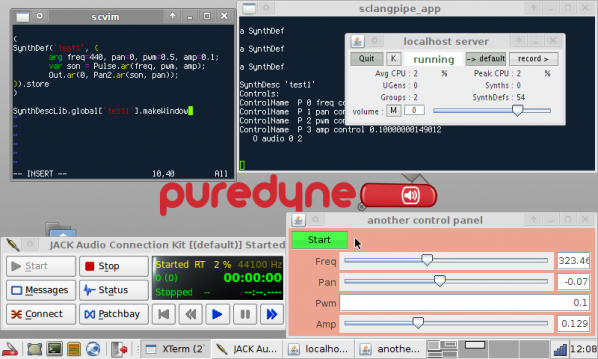
A number of projects, such as the pure:dyne[8] – GNU/Linux operating system for live audio visual processing and teaching – are, however, fully identified with the principles of free software. They have emerged from artists’ collectives whose relationship to art education is informally associated with sharing spaces, the hacklabs and free media labs where they run workshops and introduce participants to the use of free digital art tools. [9] Their mode of production is centred on ‘live code’ and feature two essential characteristics: 1) collaborative- relying on large-scale public participation and 2) distributive- offering the tools and the process notes (notation) to empower the others to carry on the work on their own.[10] This philosophy implies that the artistic performance of the work is complemented by a set of pedagogical approaches associated with the enabling of production by others. [11]

The movement for free education has gained greater relevance as a result of the global financial crisis and the battle for control of university fees.[12] In this context, art education has been developing into an artistic project while also providing an emancipatory movement reacting against dominant forms of institutionalised knowledge production. Within this movement, the role of free/open technology has been central in the mediation of self-education as a social movement.
On the one hand, artists –freelancers, sometimes temporarily/precariously plugged into educational institutions whilst working as teachers, others times as workshop facilitators in free access spaces– have opened up their classrooms to the environment of the read/write web, and with their students-collaborators, have produced and shared in wikis, blogs and Second Life, art and education resources that make an increasingly significant contribution to a larger body of knowledge that is the web. [13] Wikiversity is a model of this confluence of self-education movements and open online education.[14]
In parallel with the above-mentioned tendencies of online systems, numerous critical projects have appeared that are associated with the reclamation of space that occurs as artists have found themselves at the forefront of self-organised and self-managed self-education projects.[15] Some have happened side-by-side with the reclamation and occupation of spaces such as the Temporary School of Thought[16] and the Really Free School.[17] Part of these groups activity is the establishment of a free programme of workshops on topics that can range from free software tools to Ivan Illich and Deschooling Society.[18] Others that make opportunistic incursions into the artworld such as the Bruce High Quality Foundation University,[19] the Future Academy[20] or Unitednationsplaza,[21] are platforms for experimental art as research, investigating the production of knowledge that occurs when art education itself becomes artwork or exhibition.[22]
While the debate on free education has been enjoying significant visibility, the Higher Education sector has also joined in. A few recent initiatives have supported universities of the arts developing virtual learning environments and providing access to open education resources (OERs). This is the case with the JISC Practising Open Education Project (2010-2011)[23] with six art, design and media departments in UK universities. A number of these OERs include art work (photographs, drawings and videos), but the majority are art theory, mostly research papers, dissertations and art education research documents produced by artists-teachers-researchers as part of their continuing professional development. These are distributed with Creative Commons licenses with varying degrees of freedom, but rarely have the ‘copyleft’ attitude that has been associated with the free software.
Such an enterprise can be interpreted in the light of current debates in the fields of immaterial labour and cognitive capitalism revealing that whilst (digital) art becomes postproduction, art education is being packaged into open resources that circulate as part of the capitalist system, and become central to the new eLearning/networked economies. In addition to filling a gap in subject-specific open resources, this raises the question: why is the free and the open so popular in contemporary art education? A cynical hypothesis is that art education, by declaring itself as a type of production of knowledge, attempts to gain a new legitimacy, in the bureaucratised global knowledge market. The other possibility is that in the face of such a doomed scenario, art education searches for new possibilities beyond pure commercialism, reclaiming access through “contingencies of opening and mobility of cognitive packages beyond confines of ownership.” [24]
1. Floss as artistic –pedagogical method
The Digital Artists Handbook
The digital handbook, published by the arts organisation folly and artists’ collective GOTO10 in 2008, aims to give artists information about the available tools and the practicalities related to Free/Libre Open Source Software and Content such as collaborative development and licenses.
FLOSS+Art
This book edited by Aymeric Mansoux and Marloes de Valk in 2008 reflects critically on the growing relationship between Free Software ideology, open content and digital art. With contributions by: Fabianne Balvedi, Florian Cramer, Sher Doruff, Nancy Mauro Flude, Olga Goriunova, Dave Griffiths, Ross Harley, Martin Howse, Shahee Ilyas, Ricardo Lafuente, Ivan Monroy Lopez, Thor Magnusson, Alex McLean, Rhea Myers, Alejandra Maria Perez Nuñez, Eleonora Oreggia, oRx-qX, Julien Ottavi, Michael van Schaik, Femke Snelting, Pedro Soler, Hans Christoph Steiner, Prodromos Tsiavos, Simon Yuill. Available both in print and as torrent download
Technology Will Save Us
The project by Daniel Hirschman & Bethany Koby is a haberdashery for technology and alternative education space dedicated to helping people to produce and not just consume technology.
Openlab
Openlab Workshops was started by artist and educator Evan Raskob in mid-2009 to fulfil the need for practical education about digital art and technology. Floss workshops are developed and taught by working artists and media practitioners, giving participants direct access to practical experience.
GOTO10
GOTO10 is an artists’ collective that organises floss workshops on subjects such as Pure Data, Linux audio tools, physical computing, SuperCollider, puredyne, RFID, Audio Signal Processing, and other related areas of practice.
UpStage
UpStage is an Open Source platform for cyberformance and education: remote performers combine images, animations, audio, web cams, text and drawing in real-time for an online audience. Initiated by the globally dispersed performance troupe Avatar Body Collision, it runs the annual Upstage festival, open to proposals.
2. Self-organised and self-managed art education
Really Free School
Free school based in a squatted London pub. “Amidst the rising fees and mounting pressure for ‘success’, we value knowledge in a different currency; one that everyone can afford to trade. In this school, skills are swapped and information shared, culture cannot be bought or sold. Here is an autonomous space to find each other, to gain momentum, to cross-pollinate ideas and actions.” (Communiqué #1)
Bruce High Quality Foundation University
A free university project set up by NY-based artists’ collective The Bruce High Quality Foundation. “We believe in the artistically educational possibilities of collaboration. Collaboration, as we mean it, means a group of concerned people come together to hash out ideas, try to figure out the world around them, and try to take some agency within its future. That’s the why and how of The Bruce High Quality Foundation. BHQFU is an attempt to extend the benefits of this collaborative model to a wider number of people.”
Unitednationsplaza
A temporary, experimental school in Berlin, initiated by Anton Vidokle following the cancellation of Manifesta 6 on Cyprus, in 2006. Developed in collaboration with Boris Groys, Liam Gillick, Hatasha Sadr Haghighian, Nikolaus Hirsch, Martha Rosler, Walid Raad, Jalal Toufic and Tirdad Zolghadr, the project travelled to Mexico City (2008) and, eventually, to New York City under the name Night School (2008-2009) at the New Museum. Its program was organized around a number of public seminars, most of which are now available in their entirety online.
FOSSter creative Learning
Lesson plans that can be used in the art classroom, developed by The FOSSter Creativity Team, a group of students of the University of the Arts (USA)
3. Open Source Repositories
University of the Arts institutional OER repository
University for the Creative Arts institutional OER repository
VADS (Visual Arts Data Service) A collection of over 100,000 art and design images that are freely available and copyright cleared for use in learning, teaching and research in the UK.
OER Commons A repository of materials about teaching, technology, research in the emerging field of Open Education. Art materials at OER commons.
You can find paula’s original article on Collaboration and Freedom – The World of Free and Open Source Art http://p2pfoundation.net/World_of_Free_and_Open_Source_Art
This article is part of the Furtherfield collection commissioned by Arts Council England for Thinking Digital. 2011
Cyposium
an online symposium on cyberformance
Friday 12th October 2012
http://www.cyposium.net/
We all perform on the Internet. The social media profiles that we are contractually obliged to give our real names to are just as much performances as our World Of Warcraft or Minecraft avatars. Yet these impromptu performances of our socialised and fantasy selves lack the literary quality of drama. Not drama in the sense of a Usenet or Tumblr flamewar, but in the sense of theatre.
The 1993 New Yorker cartoon captioned “On the Internet, nobody knows you’re a dog” identifies two important features of the early public Internet. Firstly it’s a place, somewhere you can get onto. Secondly that place has limited bandwidth for establishing identity and communicating affect. This meant that the Cyberspace of the net became a site for identity play and imagined realities.
As the text-based virtual reality of MOOs gave way to the image-based Palace Chat and then three dimensional AlphaWorld the available bandwidth increased and with it the available ambiguity decreased. Describing a character or a scene or an action with a few words leaves the members of the audience much freer to exercise their own imaginations than seeing it in full motion animation with a high polygon count.
The visual, social and even economic order of virtual worlds and social media have become a more fixed and uncritical embodiment of mass media and the established social order. This has reduced their potential for alterity but it has made them useful representations both of shared reality and shared fantasy that can be used as a stage on which to perform critically, reintroducing the literay against the grain of their unreflective consumption of identity and spectacle.
Throughout this history, from the early 1990s to today, the Internet’s affordances have been used to produce dramatic performance in Cyberspace, “cyberformance”. The problem is we don’t remember this, at least not as clearly as we should. Individually, institutionally, and technologically we have lost our memories of artistically groundbreaking and important performances.
This problem is not unique to cyberformance. All digital art suffers from the decay of digital media and the creeping obsolescence of the hardware that it runs on. Internet art suffers from bitrot, software obsolescence, linkrot, the loss of web pages and sites elsewhere on the net that are connected to the work, and netrot, changes in the protocols used to distribute it.
Above and beyond those problems, cyberformance involves live perfomance. Unique events produced by historical communities at a particular moment using media that will rapidly become obsolete need to be recorded in order to be remembered or at least to be critically re-evaluated later. This creates a second layer of conservation and archiving problems.
Take the example (outside of Cyposium) of Judy Malloy’s “Brown House Kitchen”, a narrative environment created in the LambdaMOO text-based virtual reality. Despite being mentioned in surveys of virtual art in the 1990s, despite being produced with institutional support, and despite being stored on one of the longest-running textual virtual world servers the software objects that made up the work were recycled as part of the normal running of LambdaMOO and are now lost. Many other text-based virtual realities, some specifically designed for dramatic works, are not even online any more. And the protocols used to access them are old, with software to connect to them increasingly not installed by default on newer operating systems. Even those created after the Internet Archive started will not appear in it, as they are not web-based.
I mention LambdaMOO as by chance I was researching text based virtual worlds and performance in the months before Cyposium was announced. One work that was described in the literature but untraceable online was Stephen A. Schrum’s “NetSeduction”. Which Schrum presented and discussed at Cyposium. And the script of the original performance was made available through the Cyposium website. Without Cyposium, these resources would not have been made available.
These contrasting examples drive home just how badly needed Cyposium was. The Internet does enable us to digitise and experience more culture than ever before, but it also erases our memories of the culture that is native to it. And the often highly experimental nature of cyberformance makes it harder to record and remember than almost any other kind of technologically enabled art.
As well as addressing a specific need to recover the history of net performance, Cyposium is an exemplary model for a new kind of online event in the era of Massively Online Open College courses. It performs the function of a symposium or convention online, reducing barriers to access and increasing reach for institutions, speakers and audience members. The Waterwheel Tap software used for most of Cyposium allows side-channels of audience communication, which help to build a sense of place and community and allow the audience to ask (and answer) questions and share knowledge among themselves and with the speakers.
The panel discussions that Waterwheel enabled meant that old and new net performers could discuss each others work in the light of new developments or freshly reconsidered history. And we, the audience, wheoever we were and wherever we were, could watch and learn from this discussion and join in. I am often wary of the word “open”, but there was an intellectual and social generosity and inclusiveness to Cyposium that made it feel like a very open event.
A ripple of excitement went through the mailing lists I subscribe to when Cyposium was announced. Its organizers and line up promised something special, and the event itself didn’t disappoint. To be part of the audience, chatting in text alongside the live streaming video presentations, was to be part of both a welcoming ad hoc conversational community of interest and participating in a key moment in a larger historical conversation.
Cyposium went beyond recovering and presenting the history of online performance. It brought together net performers old and new in productive dialogue in front of an engaged audience and served as an example of a new kind of net native event. Now that the event itself has finished the Cyposium web site serves as an important record of an important aspect of online creativity.
This essay will appear in the forthcoming Cyposium book.
The text of this review is licenced under the Creative Commons BY-SA 3.0 Licence.
James Lowne won the Animate Digitalis Prize in 2011, with his computer animation Someone Behind the Door Knocks at Regular Intervals. His latest animation, Our Relationships Will Become Radiant (2012) was recently screened at the BFI and Tate Modern, and is now available on DVD.
Sarah Thompson: First let’s talk about Someone Behind the Door Knocks at Irregular Intervals. How did you go about creating this piece?
James Lowne: Something that interested me was the idea of contemplation and distraction, how we relate to these contrasts in a space where images are in circulation. The production of gestures and poses that are prepared, cropped and then framed for output as media content. So for this film I tried to convey these themes, within a cinematic sense, by way of a narrative. A friend gave me a piece of music and I thought I would set down some pictures to this. I began to source pictures from different places, personal photographs, movie stills, magazine ads, and consider new arrangements of these, treating them as objects. For me this appropriation is an important part of the process.
ST: Appropriation of data objects?
JL: Images could be seen as condensed information perhaps, but what I find interesting is the effect of accumulation, like interchangeable tiles. A grand narrative of the exchange, and this is what becomes more important than the singular image. But conversely, and what I find incredible, is that always within the homogeneous there is this latent singular moment, where one image, an instance of infinite copies, presents itself as unique in a particular situation to a particular viewer. The image selects the viewer, not the other way around.
ST: It has the particular quality of exploring psychic space, which I think is a key quality of Computer Animation. Do you think this is why the medium suits you so well?
JL: Well, I think we should elaborate on the term psychic space. And also think about what we mean by computer animation. What is the working process? What is the form of presentation? Still it is being used within the parameters of filmmaking. Mainstream cinema CGI relies heavily on anthropomorphism, a long line of tradition from early cell animations. To move an object suggests giving it life of some kind, but the process of making the image move is different now, it’s much quicker for one. What the computer brings to the animator is the illusion of a 3 dimensional environment as a working space, the monitor resembling the camera frame. What interests me is the ability to very quickly explore what effects a camera can have over a subject and how the subject has been posed. Capturing gestures from different angles and rendering them into images brings the meaning of this body language into question. The computer can allow you to make these decisions at incredible speeds, whizzing the camera around the subject with your mouse and keyboard. You couldn’t do this so quickly with actual cameras and so a new selection process comes into play, and this for me suggests the relationship of space and surface, and you can work like a machine, running through infinite choices.
ST: So the relationship is perhaps more of a spatial one?
JL: Yes, but a simulated space. The computer allows us to enter into this space and this is with the use of an interface, and this is the fundamental difference from, say, drawing on paper, or painting.
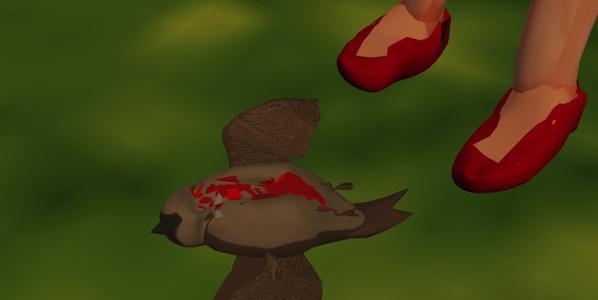
ST: The characters in both films are ‘roughly drawn’ as though you were ‘feeling the way’ as you were making it. Is that so?
JL: Drawing and writing form a starting point for my work, and I am more interested in ideas. I didn’t have a camera or any actors, but I did have a computer. I had learnt how to use all these graphic software programmes from the commercial work I had done. It struck me that the software packages end up monopolising aesthetics somewhat, with a focus on simulating cinematic styles, animating figures in a certain way, and so on. To me this seemed rather pointless and I wanted to try and get a different connection with the machine, to see if I could apply drawing through the interface. I found it very tricky, really.
ST: But through this process you make acutely emotive characters. What sort of commercial work did you make?
JL: The commercial work I had done would involve applying motion graphics onto things, or manipulating footage in post-production. I would go through frame by frame watching the actors or models in corporate adverts and film trailers. Their stylised expressions and poses I really liked, you get to think about them differently when watching them over again, and freezing on a frame of your choice.
ST: Maybe this is why these works are both funny as well as saddening. There is also a strong filmic influence like Psycho, and Blood of a Poet…
JL: For me cinema is a greater influence than animation. I like the way film can generate mood as well as story, and often the techniques of production can overwhelm the overall form. This is what is great about the old, Italian horror films of Fulci or Argento, which have relatively low production values and often, dubious narrative coherence. But this is what is so empty and distancing about them, this form makes them incredible. And the fact that I would watch them on VHS copies of variable quality only amped up the level of horror. I think these old horror films straddle that feeling of humour and terror.
ST: Like Antonioni except horror?
JL: I am not familiar with the work of Antonioni. I know Blowup, and I want to see Red Desert. But I wouldn’t make a connection with him and someone like Fulci though, that’s a whole different ball game. Fulci’s lack of filmmaking skills is the wonderful aesthetic I think, rather than the other way around.
ST: It also has qualities of traditional animation, like leaves quivering in the breeze…
JL: Yes, I like that scene as a cut away. I like the fact that in films you can uses images and sounds of nature to set certain romantic moods. I was interested in the affect that the computer generation of this style would achieve. Is it the same? The leaves look like they are kind of flashing.
ST: The narrative is all implied; do you think this puts the emphasis on the psyche of the central character?
JL: Well, I was learning about cinematic techniques as I was making the film, trying things out. Editing a sequence is very interesting to me, the way subjectivity can be manufactured by putting things next to each other. I think we tend to think about films, web and TV in a natural way when looking at media content – that this is the correct way to order a sequence of images together to tell a story – but for me this is a problem and it lends itself to playing on emotions, and this is also how we are marketed to. Is narrative implied in the dialogue between the object of advertising and the subject of consumer? In the capitalist society we are put into a space to engage with the object of choice, we shift through many surfaces of appearances quickly to construct a reality. Maybe we should edit more films like this, reflect back the illusion and test out new durations. I love the way Warhol’s films have impossible durations, making us consider ourselves rather than the work.
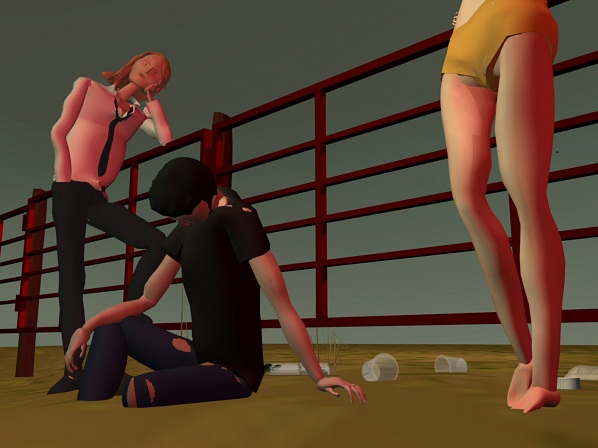
ST: We are very used to, if not inculcated in commercial object relations?
JL: I think Baudrillard uses the term absolute advertising, the form itself of advertising as an operational mode. He also speaks of the demand for advertising. I find it interesting in that we may try to determine our positions in the social sphere within this backdrop, even as we disregard it as meaningless, it has a role in mapping the coordinates in which media moves about.
ST: Do you think we see computer animation in a prejudicial way, and expect certain things from it?
JL: I think people expect certain styles and genres from their cinematic entertainment. I think we look for authenticity in things. We see computer animation everyday and don’t question it, for example on TV commercials, idents for the web, branding and corporate logos. Computer games are having an effect on cinema too. I think only if the context is changed people may question it.
ST: I mean that it’s possible to do things and say things with animation which wouldn’t be so realisable with film, animation is maybe more iconic?
JL: I think film and computing are very much as one now. Anything can be achieved in a post-production suite, and is quite often expected of film today. I think the aesthetics should cross even more rather than CGI trying to emulate film. The opening scene to David Lynchs’ Mulholland Drive for me is a perfect way of using computer graphics and film, and this achieves an amazing effect for the cinema.
ST: In Our Relationships Will Become Radiant there is a similar exploration of the psychic space between individuals to Someone Behind the Door but it is drawn out further and even more oblique. The characters have a special relationship with images in a frame? Like i-Pads almost. They find the ‘photographs’ lying on the ground.
JL: Well, I was trying to use narrative to look at subjects, to look at relationships within a network of some kind. I wanted to let the film generate some of its own relationships. In the narrative there is this kind of defined physical space that these people find themselves in, although they try to make this space limitless. I was interested in the idea that they lose their physicality somewhat, maybe disregarding their bodies, or appropriating themselves as images.
ST: Perhaps the specifics of the narrative ‘don’t matter’, it is as though you are finding the essence of manners of relating which can be more subtle in CG because you can manipulate the models more quickly?
JL: Certain narrative forms we take for granted as real, news reports or some big corporate event, the way these things are mediated to us we accept as a truth, the way that it actually is or actually happened, which is obviously not true. I think narrative forms should be explored to allow us to think about what we take for granted as truth, and even further, how do we act in the space of choice between different truths when the mediation of these subjects is the same?
ST: Is it that a narrative can be suggested, but it doesn’t actually have to be a narrative to have a narrational effect? And then it is sort of how we find meaning symbolically in pictures, and that helps us to make sense of life?
JL: Well, exactly. Questioning things is very important, especially if we are to live in a network of images. In conventional narrative forms emotion and passion can be exploited very easily, and maybe this helps keep those accepted forms of mediation in operation. Cinematic narratives can be reframed in new stylistic approaches to adapt to the present ideology, but are we breaking away from the conventional structures?
The DVD is available from the BFI shop, published by Filmarmalade, and it also includes a second new film, Corporate Glossy Warhol Burger, co directed with Gordon Shrigley
I met Eugenio Tisselli in Edinburgh at the Remediating the Social conference in November 2012. Eugenio gave a presentation on the project Sauti ya wakulima, “The voice of the farmers”: A collaborative knowledge base created by farmers from the Chambezi region of the Bagamoyo District in Tanzania, and “by gathering audiovisual evidence of their practices they use smartphones to publish images and voice recordings on the Internet”, documenting and sharing their daily practices.
I was struck by his sensitivity to the social contexts and political questions around this type of project engagement. This interview explores the challenges we all face in connecting to a deeper understanding of what technology can succeed in doing beyond the usual hype of the ‘New’ and its entwined consumerist diversions. Not only does the conversation highlight how communities can work together in collaborating with technology on their own terms. But, it also discusses the artists’ role in the age of climate change and the economic crisis, locally and globally.
Marc Garrett: Can you explain how and why the Sauti ya wakulima, “The voice of the farmers” project came about?
Eugenio Tisselli: Sauti ya wakulima is the fruit of my collaboration in the megafone project, started in 2004 by Catalan artist Antoni Abad. During six years, we worked with different groups at risk of social exclusion, such as disabled people, immigrants or refugees. The idea was to provide these groups with the tools to make their voices heard: smartphones with a special application that made it easy to capture images, sound recordings or short videos, and a web page where these contents could be directly uploaded. Using these tools, the participants of each project were able to create a collaborative, online “community memory”, in which they could include whatever they considered to be relevant. Although megafone was relatively successful and, in some cases, made a positive impact on the people who participated, I was worried that the project was becoming too dispersive. We worked in six countries, with extremely different groups. So, in 2011, I decided to follow my own path and apply a similar methodology into more focused projects, related with sustainable agriculture and environmental issues. I realized that the projects which sought to increase the empowerment of a community could become too complex for a single artist to handle. That’s why, in Sauti ya wakulima, I’m not “the artist”, but a member of a transdisciplinary team which includes biologists, agricultural scientists and technicians. Such a team came together after my PhD advisor Angelika Hilbeck, my colleague Juanita Sclaepfer-Miller and myself came across the possibility of working with farmers in Tanzania. The network formed by local researchers, farmers and ourselves was quickly formed, so we started the project on March, 2011.
MG: I find it interesting that you made the decision to put the role of artist aside. This reminds me of a discussion in Suzi Gablik’s book published in 1995 ‘Conversations before the end of time’; where James Hillman in an interview talks about learning to refocus our attention from ourselves and onto the world. Further into the conversation Gablik says “In our culture, the notion of art being a service to anything is an anathema. Service has been totally deleted from our view point. Aesthetics doesn’t serve anything but itself and its own ends”.[2]
So, I have two questions here. The first is how important was it for you to put aside your status as an ‘artist’, and what difference did it make?
And, where do you think you and others may fit when considering the discussion between Gablik and Hillman?
ET: It is important for me to make it clear that I didn’t abandon my role as an artist. Instead, I fully assumed my status, but only as a member of a transdisciplinary team. I believe that this may be a point of departure from the classical view of the artist as a “lone genius”, which is closely related to the discussion about service in art. So I’ll try to interweave both questions together. In a recent publication, Pablo Helguera aimed to set a curriculum for socially engaged art. He identified the new set of skills to be acquired by the artists, and the issues they must address when dealing with social interaction. But, as Helguera suggests, perhaps what’s most important is to overcome the “prevailing cult of the individual artist”, which becomes problematic for those whose goal is “to work with others, generally in collaborative projects with democratic ideals.” [3] To me, this implies that the artist must give up control of the work to a certain degree. I find myself in this scenario, and I think of my role in Sauti ya wakulima as that of an instigator and coordinator. Furthermore, all of us involved in Sauti ya wakulima aim to effect actual changes in the lives of the participating farmers, rather than obtaining purely symbolic results. Our project is a socially engaged artwork that wants to be useful, to deliver a service.
We are living in urgent times, beyond any doubt. Looming global challenges, such as climate change, radically cancel the luxury of being useless, of not doing anything. This includes the artist who, as any other citizen, is called to use his or her abilities to help in preventing a catastrophe. I especially like Franco “Bifo” Berardi’s proposal about the new task that the artist might assume: that of reconstructing the conditions for social solidarity. This work of reconstruction would oppose competition, a value often found in the markets that deal with self-referential, self-serving artworks. Solidarity, writes Berardi, is neither an ethical nor a political program, but a pure aesthetic pleasure [4]. In my opinion, the artists who still embrace the idea that art should only serve its own ends will become those who play the lyre while our world burns.

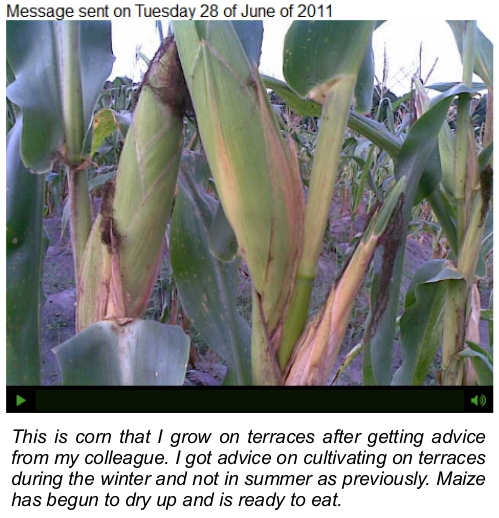
MG: What kind of behaviours began to emerge once the farmers took control of the smartphones supplied?
ET: It was quite interesting to see that the farmers started to use the phones for purposes which were different from those that we had originally proposed. This happened very soon after the project started. Only one month had passed, and the farmers had already started to go beyond merely documenting the effects of climate change. They interviewed other farmers, and asked them all sorts of questions about their crops and agricultural techniques, their opinions and views. In short, they slowly laid out a web of mutual learning. This was a real eye-opener for us. As we began to observe this, the environmental researchers in the team became worried that the farmers were deviating from the goals that we had set. I wanted to leave room for this deviation, as I was particularly interested in studying the process of technological appropriation. So I had to convince the researchers that we should leave enough room for the farmers to freely explore the potentials of the smartphones. It was not easy but, in the end, negotiating the tensions between a goal-oriented and an open-ended research turned out to be quite fruitful.
On one hand, the farmers found that they could shape the project to fit their interests which, as they said, were to “learn about what other farmers in remote areas were doing.” On the other, the researchers finally realized that the images and voice narrations posted by the farmers were an invaluable source of information about what was actually going on in the farms and within the communities. Sometimes, agricultural initiatives may be designed with an insufficient understanding of the social context in which they are applied. By allowing the farmers to publish a wide range of topics, Sauti ya wakulima became a “community memory” that reveals rich details about farming and the social life of rural communities in Bagamoyo.

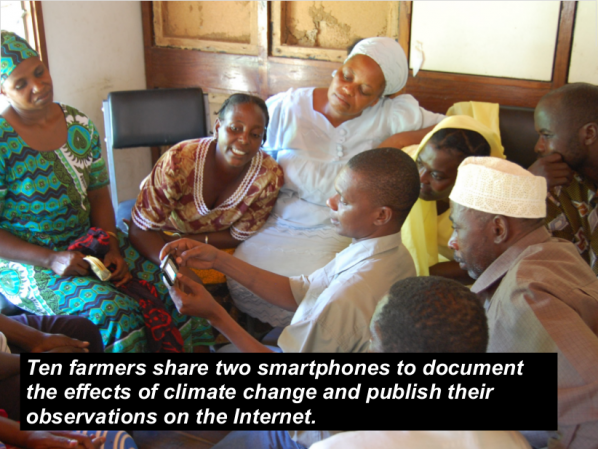
MG: In your presentation at Remediating the Social, I remember a quote from one of the farmers saying “The project helped me learn that phones can be used for other things besides calling people, and that computers can also be used to solve problems: they are not just a fancy thing for the rich people in towns.” What’s interesting here is, these words could be said any where. And that our consumer orientated culture could still learn a few things regarding uses of technology.
What lessons can the farmers teach ‘us’ in a culture where computers are part of the everyday life?
ET: I have interpreted this particular quote in two different ways. The first, most obvious one, is that the farmers discovered that the smartphones and the web can be useful tools, which may be shaped and adapted to meet their needs. For many of them, Sauti ya wakulima was their first chance at trying out these technologies. And, happily, the project showed us all that they can become an important ingredient in making farmers’ lives a little better.
However, my second interpretation is not as optimistic: in the quote, there is an explicit comparison between the (poor) farmers living in remote areas and “the rich people in towns.” Moreover, the fact that smartphones are explicitly considered as fancy devices points towards issues which need to be handled very carefully. In every part of the world, technological gadgets are quickly becoming symbols of social status. Currently, I am working in a rural zone in southern Mexico where cellphone coverage was nonexistent only two years ago. But as soon as the first antennas were installed, young people in those communities started buying smartphones, and now there is an open competition to see who has the fanciest one. A similar thing happens in Bagamoyo.
So, of course, smartphones can be useful tools, but they can also bring more consumerism into poor communities. This is very dangerous. I’d like to stress that, in our project, the smartphones are used as shared tools. This means that there is a limited number of devices available, and everyone must have a chance to use them at least once. I believe that this is a small but significant contribution towards diluting the extreme individualism and consumerism that are closely linked to these technologies.
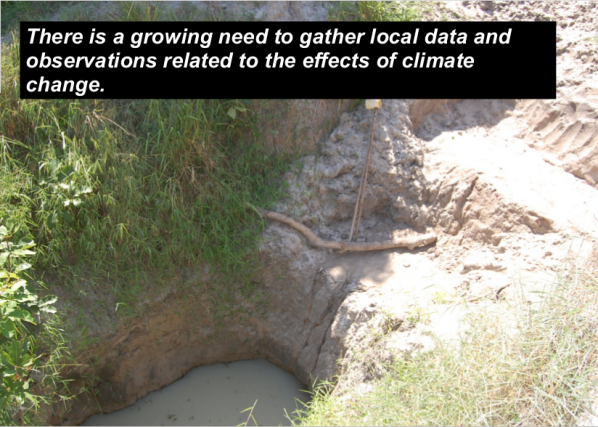
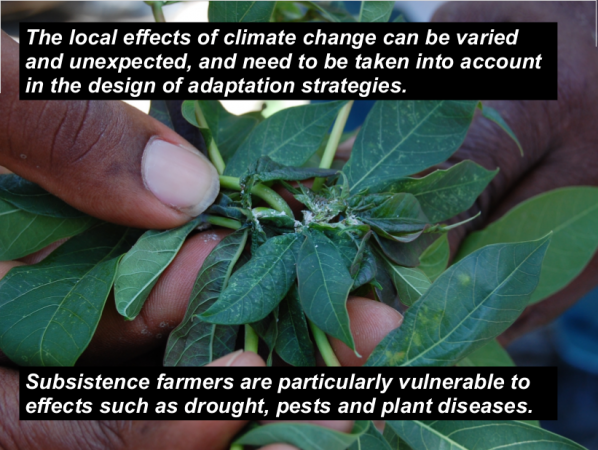
The farmers I have met in Bagamoyo have a very strong sense of community. Although their farms can be very far apart, sometimes with no roads between them, they still get together very often. They work together, learn together, have fun together. That’s the biggest lesson I’ve learned: we need each other’s presence. Quoting “Bifo” again, we are living in a time of precarization of the encounter of bodies in physical space. I agree with him that the most important poetic revolution has to be the re-activation of bodies. The farmers, with the great efforts they make to get together, and the great joy they find in doing so, have taught me a great deal: I need to get out of Facebook and step in to the “here and now”, together with others.
MG: What has this experience taught you. And how will it impact your future practice as an artist?
ET: I have partially replied to the first part of this question. But besides learning how to re-dimension the importance of computers in my life, I have also learnt a lot about agriculture. This is not a minor thing for me: after all these years of living in big cities, and realizing that I lack a basic connection to the earth, I believe I have found the best possible teachers. Of course, I’ve also learnt a lot about how to work with non-expert users of technology. This has made me better as a teacher. And, as you can imagine, many of the things we take for granted at home won’t necessarily work in Bagamoyo. So, doing projects in difficult environments has taught me to adapt, and to transform things that escape my control into opportunities. All of this changes me, not only as an artist but as a human being. My artistic practice is already quite different from what it was before Sauti ya wakulima. I have adopted a very critical position towards technology. Now, this is also a major shift: I started programming creatively when I was ten years old, and have been a media artist almost since then. But I feel I can’t go on with those artistic explorations, knowing what I know now. Consequently, last year I wrote and published a small note explaining why I stopped creating works of e-Literature, a field in which I was involved for more than ten years [5]. That was both a closure and a point of departure. Let’s see what the future brings.
Excerpt from ‘Why I have stopped creating e-Lit’ by Tisselli (November 25th, 2011)
Dear friends: this morning I went for a walk along the Naviglio Grande in Milan, and I entered a shop selling second-hand books. There I found a small book, “The Computer in Art”, by Jasia Reichardt, published in London in 1971. The book described the works of pioneers of Computer Art, such as Charles Csuri or Michael Noll, who were active at that time. A real gem. But the biggest surprise came when I turned to the last page, on which the previous owner had written: “I married on 23, November. I would like to be a man, not artist, not engineer, a man.”
I took the book with me.
Those involved in the Sauti ya wakulima / The voice of the farmers project.
The farmers: Abdallah Jumanne, Mwinyimvua Mohamedi, Fatuma Ngomero, Rehema Maganga, Haeshi Shabani, Renada Msaki, Hamisi Rajabu, Ali Isha Salum, Imani Mlooka, Sina
Rafael.
Group coordinator / extension officer: Mr. Hamza S. Suleyman
Scientific advisors: Dr. Angelika Hilbeck (ETHZ), Dr. Flora Ismail (UDSM)
Programming: Eugenio Tisselli, Lluís Gómez
Translation: Cecilia Leweri
Graphic design: Joana Moll, Eugenio Tisselli
Project by: Eugenio Tisselli, Angelika Hilbeck, Juanita Schläpfer-Miller
Sponsored by: The North-South Center, Swiss Federal Institute of Technology – Zürich
With the support of: The Department of Botany, University of Dar es Salaam (UDSM)
THE CRYSTAL WORLD
The White Building, London
3 August – 30 August 2012
The Space’s White Building cultural centre is within walking distance of the 2012 Olympic stadium in post-industrial, post-regeneration London. As I walked down the steps that lead to it I saw a diesel locomotive pulling a train of cargo containers across an old railway bridge over the canal nearby. Millions of these rational forms will be in transit around the world at any given moment, arranged in two or three dimensions like crystalised capital on trains and docks and ships.
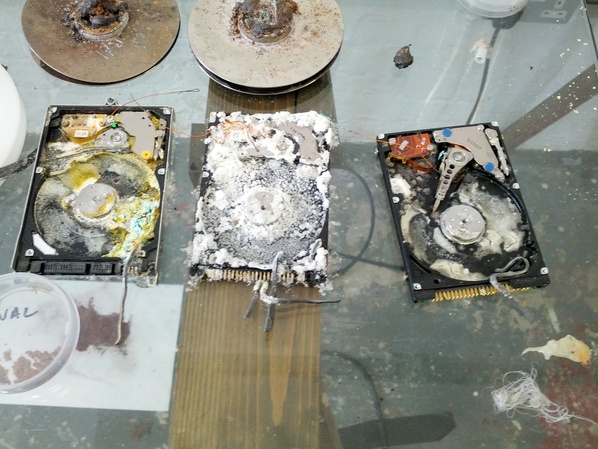
The logistics of their production and distribution are determined by computing machinery using algorithms that operate with inhuman speed and complexity. This same economic logic warps the architecture of the area around The White Building, with old factories and warehouses retro-fitted as office space and as gallery space.
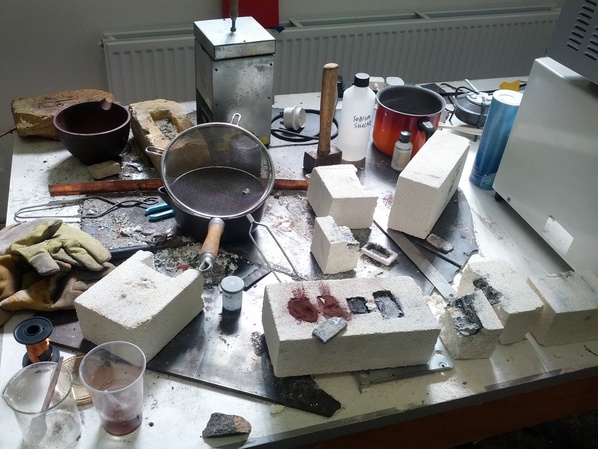
Inside the White Building’s project space the computational enabling technology of the global economy is the subject of a show by Martin Howse, Ryan Jordan and Jonathan Kemp. It takes the title of J. G. Ballard’s novel “The Crystal World” as its starting point. In Ballard’s novel a virus progressively turns all life – vegetable, animal and human – into crystal forms frozen in time. It is a Cold War allegory of the catastrophic imposition of rigid order.
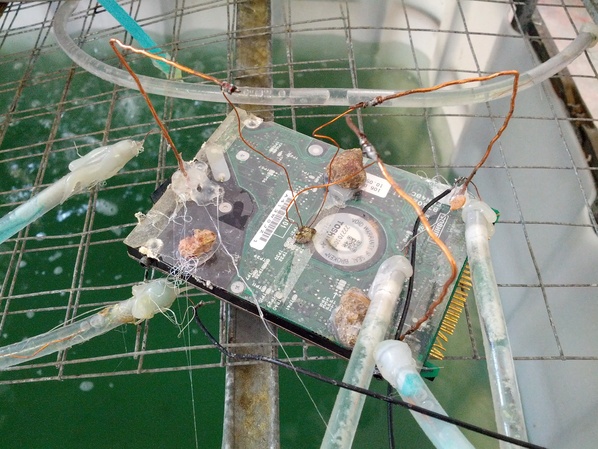
For Howse, Jordan and Kemp these imaginary crystals become the very real minerals refined in the production of the computing machinery used to structure our contemporary world. Inside every digital computer are wires, circuit boards, integrated circuits and other components. They are made from iron, copper, phosphorous, boron, tantalum and other rare earth elements. The central processing unit of a computer keeps time using a quartz crystal. The products of deep geological time are suddenly unearthed and set to pulsating millions of times a second.
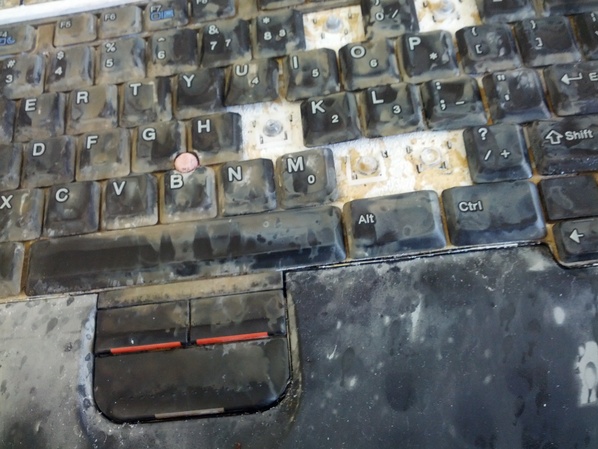
Computers are crystal engines. They are mineral fetishes that we use to manipulate powerful unseen forces that we believe we have mastered, like crystal healers working with a patient’s energy grid. But they are so invisibly familiar to us as our smartphones and laptops and their use in logistics and media is so pervasive that it takes an effort for us to perceive their operation or their implications.
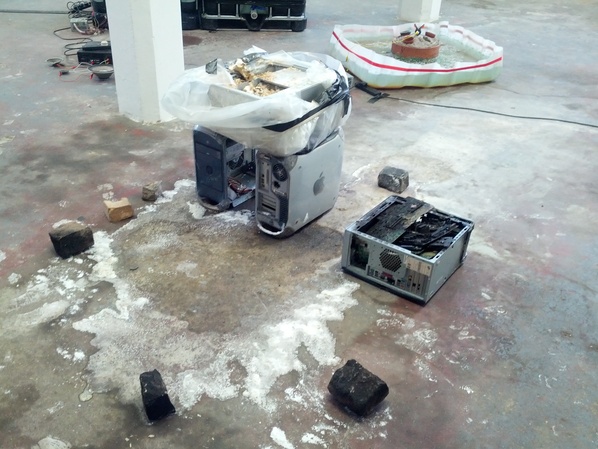
It takes almost two tonnes of raw materials to make a desktop PC. Unlike “Tantalum Memorial” (2008), by Harwood, Wright and Yokokoji, “The Crystal World” focuses on these raw materials geologically and temporally rather than geopolitically. But computing waste is toxic and valuable. The former makes disposing of old computers a growing problem, the latter makes recycling old computers a growing business. The minerals that computers contain can be recycled where they are valuable enough, or left to leach into the water supply in e-waste dumps where they are not.
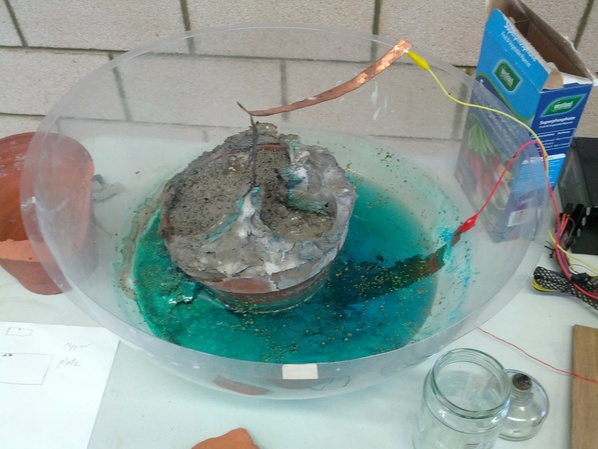
Or in the case of “The Crystal World” an open laboratory and the resultant art installation can re-extract them from their components and printed circuit boards using acid, water, electricity and heat in order to re-crystalise them and return them to geological time. The gleaming silent boxes that organize and mediate our lives are returned if not to the earth from whence they came then at least to their raw materials.
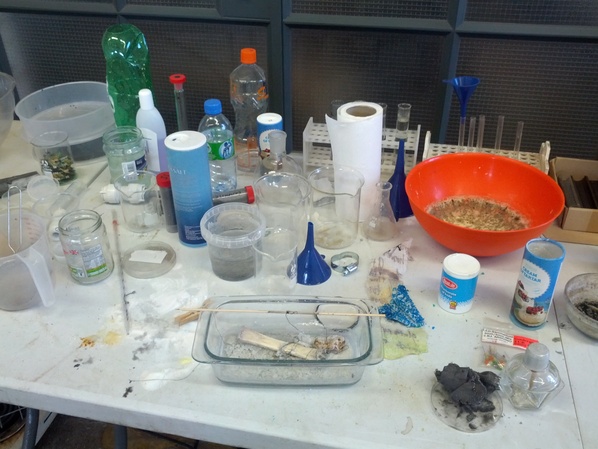
Tables edge the White Building project space, covered with the equipment and results of five days of workshops (and one with books, including Ballard’s, giving any spectators unsure of what is happening a conceptual framework to proceed from). Table after table of crystals, circuit boards, jars, electical equipment, and wires are overwhelming in the details of their appearance and implication. These traces of human activity and inquiry frame the flow of water and electricity in the center of the space, convincing the viewer of the creative intent of its production and drawing them in to its logical universe.
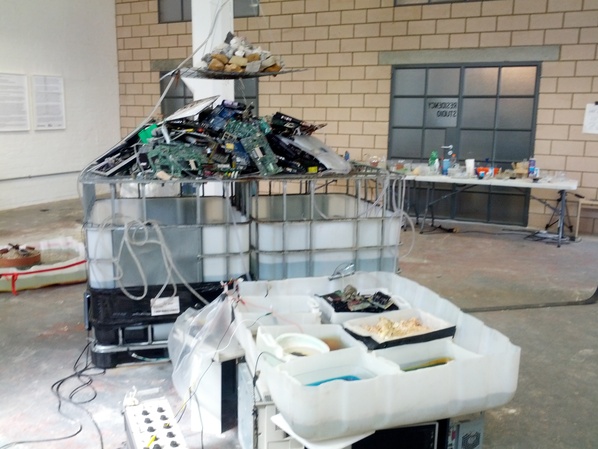
The centre piece of the show is a favela chic water feature that drips acid-loaded water through calcinous rock fragments, over e-waste, into two cut plastic-drum tanks. Next to it an array of smaller plastic containers contain circtuit boards having their copper leeched from them by acid, fungus growing on the by-prodcucts of the project, and other watery deconstructions of computing machinery. It looks dangerous and uncertain, deconstructing both the physicality and the meaning of computers. Seeing the innards of an IBM ThinkPad computer becoming encrusted with calcium like a digital stalagtite, or CPUs branching feathery crystals, returns computing machinery to its raw mineral state. FLOPS give way to eons once more. Neither is a human timescale, yet we must live between them at the moment.

The most fantastical artifact along the walls of the project space is the “Earth Computer”. It’s a battery-like construct of recycled copper and zinc in a tray of silver nitrate attached to lightning conductor-style copper strips. Sitting in earth on a plastic sheet and surrounded by the left-over materials of its creation for the duration of the show, it will be buried nearby afterward. Such a device can function effectively, but not literally. It is more likely to spring to life in the mind of the viewer than if it is struck by lightning. It is effective art, psychic engineering rather than technological cargo culting.
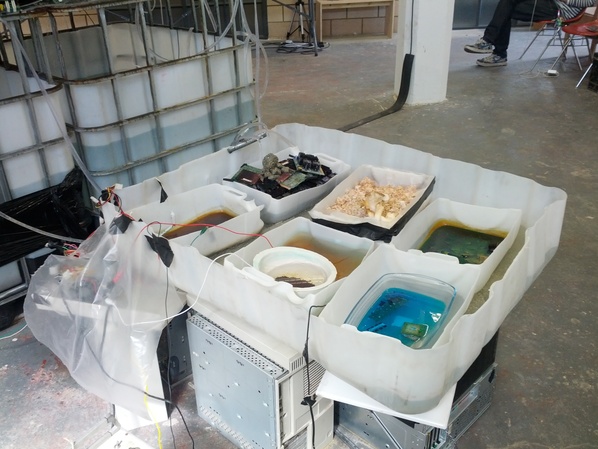
Acid, water and electricity mixed together with e-waste look and feel dangerous. The recycled ad-hoc materials and equipment containing and channeling them reinforce this feel and leaven it with an aura of creative investigation. The form of the show is timeless, the workshop of the alchemist, outsider scientist, or mad inventor. Its content is very contemporary, from Ballard’s rising cultural stock and the social and environmental costs of e-waste to Long Now deep time and posthuman philosophy. Art symbolically resolves the gaps between ideology and reality, and computing is so pervasive and key to society that most people don’t even regard it as ideological never mind conceptualise its failings as such.
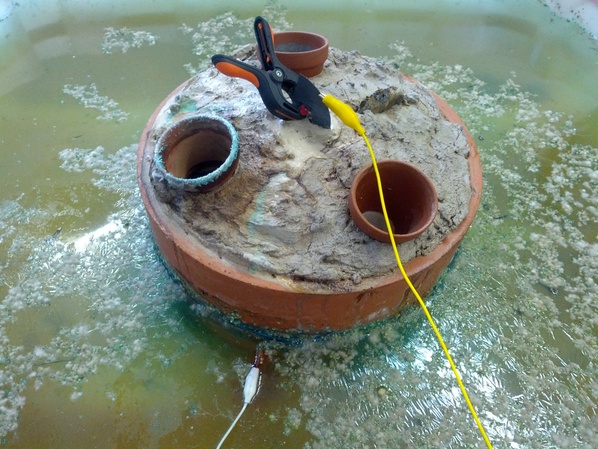
The water and abandoned human artefacts of some of the installations is more “Drowned World” than “Crystal World”, and the broken machinery is more “Crash”. Ballard’s catastrophes provide a modern mythology that is a more useful resource for art than its literary roots might suggest. It achieves the defamiliarising and critical impact of hauntological art without requiring its supernaturalism or nostalgia. There is a Ballardian attitude at play here.
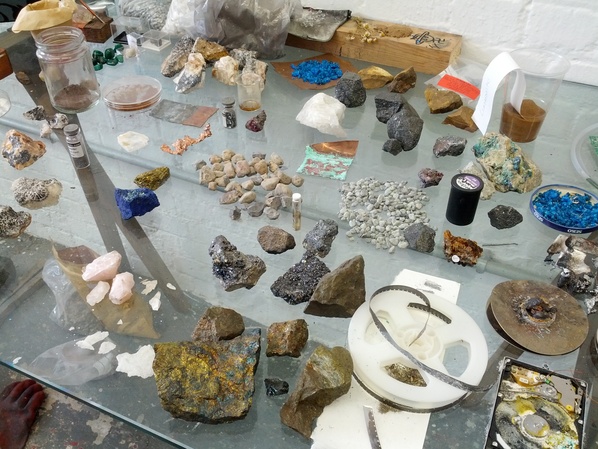
I found “The Crystal World” mind-blowing. It relates the tools of our human existence to non-human substances and timescales, providing the kind of corrective to anthropocentric vanity that object-oriented philosophy aspires to. It achieves this profound insight and presents it in an accessible way precisely because of the modesty of its materials and aesthetics, and because of the resonances of the cultural materials chosen as its starting point.
http://spacestudios.org.uk/whats-on/events/the-crystal-world-open-laboratory-exhibition-
The text of this review is licenced under the Creative Commons BY-SA 3.0 Licence.
Dual
Nottingham Playhouse
5 September – 30 October
After a glorious false start in the 1990s, the previously over-hyped technologies of virtual reality have been quietly reclaimed in a more sustainable and democratic way through Free Software and Open Source hardware. The show “Dual” at Nottingham Playhouse showcases art that mostly uses these new technologies. A theatre is the perfect setting for the reality play of virtual reality. Curatorial collective The Cutting Room (Clare Harris and Jennifer Ross) have organized the funding, production, and presentation of artworks that mix the virtual and the real in creative ways.
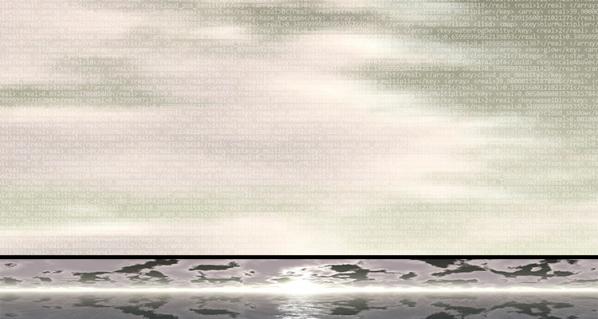
Michael Takeo Magruder’s “Deconstructed Metaverse” (with Drew Baker and Erik Fleming), 2012, is installed on the upper landing of the theatre. The windows on the landing have been glazed with images of warmly coloured softly undulating colours. On closer inspection they are pixellated and have endless lines of computer code superimposed over them in small white type. The code is XML representing a virtual world, and that virtual world can be seen and interacted with on monitors in front of the windows. They display a ceiling-less ultra-modern rotunda with windows glazed in images of the views that could originally be seen through the real windows that are now glazed with images of the site-specific virtual world.

The first, smaller, monitor sits on a plinth alongside the circuit board that runs the virtual world using OpenSim under GNU/Linux from a single USB memory stick. You can use a keypad to explore the world, your presence there represented by a generic default human avatar that walks and flies around the island. Or you can visit the virtual world over the Internet. In either case, a large screen further along shows a rotating view of the island, its architecture and inhabitant(s).
Magruder has worked with virtual environments since the VRML era, and “Deconstructed Metaverse” continues some recurring themes while bringing them to a new level. There are multiple layers of reality and presence to this work that the viewer can find themselves looking into and out from, relating to other onlookers as part of the audience or part of a performance in the virtual world themselves.
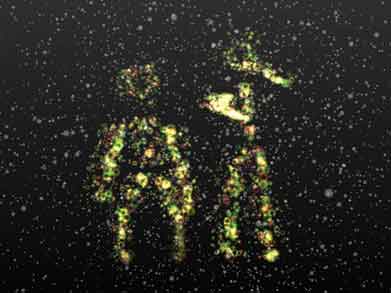
Brendan Oliver’s “Particulation” uses a Microsoft Kinect to capture the poses and motion of pairs of patrons walking through the Playhouse’s ground floor bar. A laser-scanning motion tracker and the software to process its input would have been unobtainable for most artists a decade ago. Oliver makes good use of hardware that was liberated against the wishes of its manufacturers and of software frameworks that are shared more freely.
Oliver uses them to capture and evoke the movements of two people who may not realise that they are the inspiration for the visual art on the wall. They are translated into a particle system of bubbling circles of light projected just far enough away from the sensor that monitors them that the connection between captured movement and animated image is not immediately obvious from all angles. Particulation has the feeling of joyous discovery and exploration that the best interactive multimedia art can bring to a space.
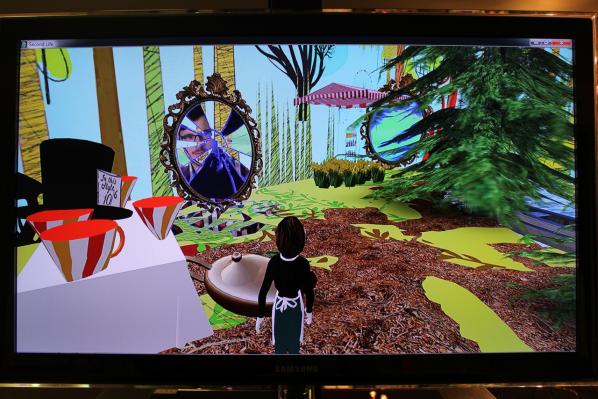
Below ground, “Mirror On The Screen” by Charlotte Gould and Paul Sermon uses similar technology to Deconstructed Metaverse to create a pocket universe of symbolic scenery and objects from children’s stories. In order see the screen presenting the virtual world and use the keypad to move your avatar around it you must stand in front of a printed backdrop where you are watched by a webcam. The resulting video stream is fed into the virtual world and superimposed onto cracks in its reality.
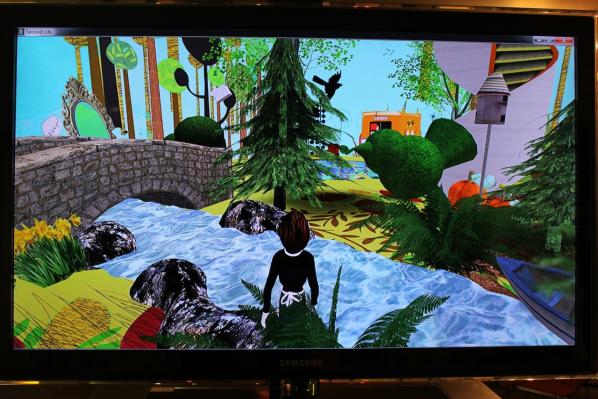
In addition to seeking the highest place in the forest, the edges of the world, and all the objects and characters within it, you find yourself hunting your own reflection. The tables are turned as the avatar you are watching starts watching you, and your purpose becomes seeking out further reflections. The setting of the theatre puts the viewer in a frame of mind open to the drama of the virtual world and its looping back on reality. Far from jolting you out of the experience, suddenly being faced with your own image in the virtual world draws you in further.
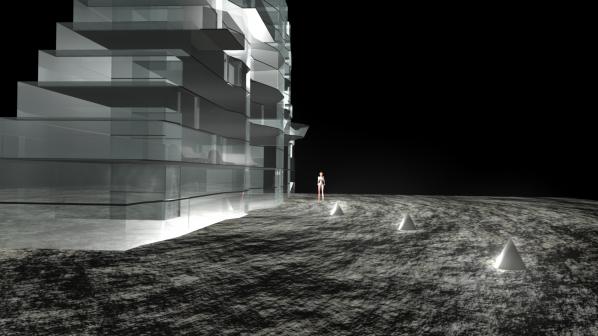
Finally, Kim Stewart’s “Sigma 6” is a 3D computer animated film set in a dystopian high modernist moonbase-like environment of harsh architecture and harsher treatment. The virtual world-like quality of the animation, and the avatar-like quality of its persecuted protagonist have their reality punctured in a way that continues the theme of mixed realities in a way that turns towards body horror.
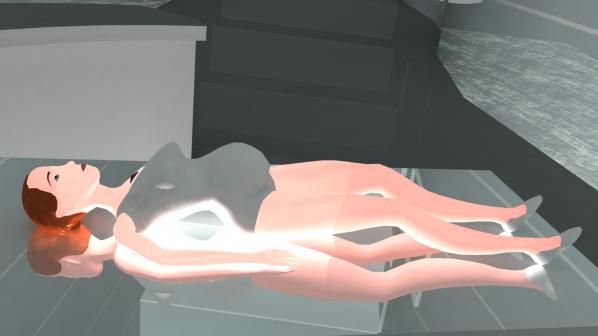
These common themes of blurring virtual environments with real bodies and places allow the works to complement and distinguish themselves from each other artistically and technically. The Cutting Room are to be applauded for assembling such a thematically tight and technologically competent show that both serves and is served so well by the context of the institution that it is staged in.
http://www.nottinghamplayhouse.co.uk/about-us/the-cutting-room/
The text of this review is licenced under the Creative Commons BY-SA 3.0 Licence.
12 Remixes, by Michael Szpakowski
From August 2011 to July 2012, the video artist and musician Michael Szpakowski entered a remix competition every month, and compiled his remixes (some of them with accompanying videos) on his website. “I’m 54 years old,” he explained at the beginning of the project, “and although I’m musically reasonably deft I know little about the culture in which I’m attempting to intervene. I know none of the specialised vocabulary, can’t distinguish genres and although I understand what is being said, just about, I don’t speak the language in which posts or comments on this kind of work are framed.” The project, in other words, was a deliberate step outside his “comfort zone”.
The results are often startling. It’s worth comparing the remixes with the original tracks from which they derive, because it provides some insight into Szpakowski’s working methods, and makes you realise the extent of some of the transformations he has achieved.
One of the most striking examples is the remix of “Sandwiches” by the Detroit Grand Pubahs. The original track is a grotesquely overstated hyper-lecherous rap. A synthesised-drum-and-bass arrangement underpins a chipmunk-style speeded-up vocal, warbling lyrics of such obvious symbolism that they hardly qualify as suggestive: “I know you wanna do it/You know I wanna do it too/Out here on the danceflo’/We can make sandwiches…/You can be the bun/And I’ll be the burger, girl…/Make your thighs like butter: easily spread…” The effect is quirky, irritating and compulsive; tongue-in-cheek, deliberately outrageous, blatantly sexist and borderline pervy all at the same time.
Szpakowski’s remix has an entirely different feel. The vocals have been slowed right down from warbly chipmunk to entombed Darth Vader; correspondingly, the bassline has slowed too, from a prefabricated booty-shaker to something subterranean and slightly menacing; and in the space above there are echoey keyboard-notes floating and pulsing like luminous jellyfish. The effect of the lyrics is no longer leeringly voracious, but mournful, obsessive and introspective. There is an instrumental coda with a vaguely Scottish Highlands flavour to it. The feel of the track has changed completely, and so have its texture and geometry. We find ourselves in a darker, much larger space.
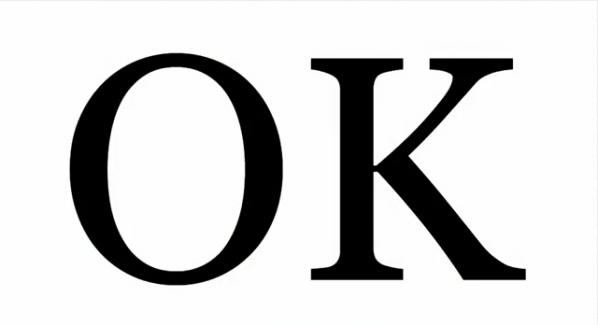
Another good example is “OK good stand clear”, based on “110%” by Laura Vane and the Vipertones. The original song is efficient, well-assembled funk/soul, complete with a punchy horn section and a sassy female lead vocal. It’s slick, sharp and professional, but hard-working rather than inspired. Szpakowski’s remix dispenses with almost everything except the rhythm section, which is slowed down slightly to give it more depth and a thumping creaky quality like an elephant in new walking-boots. To this he adds a sampled American voice saying “OK? Good” and “Stand clear of the closing doors!”, and a hammering piano-figure. Again the effect is to open the track out, to give it a more three-dimensional feel, and also to make it much less derivative, much less obviously the product of a particular genre.
In almost every instance Szpakowski’s remixes have a more resonant and spacious feel than the originals; the sounds are dirtier, fuzzier, more textured; and the rhythms are more complex. These changes may not always be entirely to his advantage. As he admits himself, “I don’t dance (or haven’t for twenty years or so), which actually makes a big difference in how one experiences popular music…” Certainly there is one track – a remix of “Paradisco” by Charlotte Gainsbourg and Beck – where Szpakowski’s version has a spiky, angular, echoey jazz feel, but loses out to the original in terms of finger-clicking compulsiveness. It’s true that his remix puts a stronger focus on Gainsbourg’s voice and lyrics than does the original; but whereas Gainsbourg and Beck’s version stays within the disco format and gives it an iconoclastic indie makeover, Szpakowski’s remix takes us beyond that format altogether, and comments on it from the outside.

In some of the tracks there is a move from the USA to Europe in terms of feel. One example is the remix of “What happens in Vegas” by Chuckie ft. Gregor Salto – a histrionic slab of USA club music. Szpakowki’s version (“Shit happens in Vegas”) has a distinctly Kraftwerk-esque, European-techno slant. Also, because the remixes are often crackly, fizzy and hissy, they tend to feel “older” than the originals. At times we seem to be listening to badly-tuned radios in the pre-digital era, or to vinyl LPs smothered in dirt and played through a fluff-laden needle. But this “distressed finish” effect is in keeping with a broader sense that Szpakowki’s remixing technique involves a kind of deconstruction or breaking-apart of the tracks on which he is working. They become less smooth and shiny, less self-contained. The original tracks are often tightly-focussed in terms of their musical styles, with a narrow range of subject-matter, and often with manipulative designs on the audience – wanting to make them feel like dancing, wanting to make them feel sexed-up, or trying to tug at their heart-strings (“Try to Stay Awake” by Frank Friend, “Trojans” by Atlas Genius and “Jigsaw” by Mimi Page are all relationship-based heartstring-tuggers). The remixes, on the other hand, aren’t looking for such straightforward reactions. Their subject-matter is less easy to pin down, and their ingredients bespeak a mixing-together of disparate materials, different cultures, and even different eras.
Non-musical ingredients are one noteworthy feature. In “OK good stand clear”, the voice saying “Stand clear of the closing doors!” comes, as Szpakowki explains, from “New York subway recorded announcements… grabbed, I think, from YouTube”. He is also fond of introducing a voice intoning random numbers – this occurs in several of the tracks. Usually the voice has a foreign accent, and sometimes the numbers are spoken in a foreign language. These number-sequences, says Szpakowski, come from “the so called ‘numbers stations’ which are believed to have been used by various intelligence agencies… they’re available at the internet archive“.
On “I’m getting a cat” the words come from mashed-up Tweets which have been run through a voice-to-text synthesiser. “I am that I am” borrows its vocal from the painter and sound poet Brion Gysin – a voice-sample which, until it begins to distort, sounds rather like a 1950s announcement on the BBC. “Speaking in Tongues” reverses the vocal on a hectoring soul track by Colonel Red called “Rain a Fall”, so that it ends up sounding as if it’s in some unspecified European or possibly Middle Eastern language. And “Sugar Plum Fairy on the Dancefloor” introduces the chiming melody from Tchaikovsky’s Sugar Plum Fairy into a rap called “Disco Technic” by Stan Smith, to surprisingly good effect. There is a genre-busting transgression of boundaries, a throwing-together of cultures, a jumbling-up of eras, and a deliberate use of incongruous material.
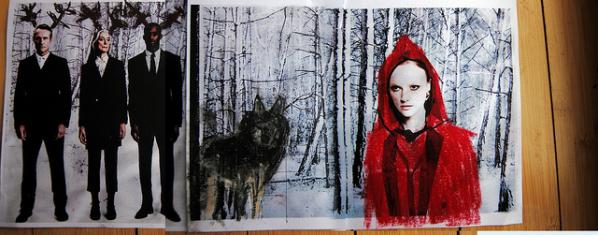
The videos Szpakowski has produced to accompany some of these tracks show similar traits. Again his admission that he doesn’t dance is relevant here, because the starting-point for many music videos – a very tight and emphatic synchronisation of visual effects with the beat of the track – is not a particularly dominant feature in his work. The one which succeeds best in this respect is the video for “OK good stand clear”, which projects text versions of the words onto the screen in big letters precisely as we hear them. There is also a lovely moment in the video for “I’m getting a cat” where, in a bit of old black-and-white footage, some youngsters sitting on chairs on a stage start to sway from side to side, apparently in time to the music.
But synchronisation to the beat isn’t Szpakowski’s priority. “I’m getting a cat” provides a good example of the kind of effect he achieves instead. The synthesised vocal for the track first announces that it’s getting a cat, then starts to ask absurd questions about cats and cat-care – “Does your cat try to style your hair?”; “What is your funniest and yet painful cat story?” – which are gradually infiltrated, first by other subject-matter – “Become a big brand on Facebook!” – then by symbols – “Poundsign poundsign poundsign” – and sequences of numbers. What starts off as funny, ironic and nostalgic develops or breaks down into a kind of digital fragmentation, and eventually into wordlessness. The end of the track is a wistful instrumental coda, embellished with piano and strings. And the video follows much the same path. It starts with old footage from the 1960s White House, in which President Lyndon B Johnson seems to be announcing his intention to get a cat to his slightly-bemused aides. Then there are some outtakes from what seems to be an instructional video in which a troubled youngster is being given helpful advice (presumably cat-care advice) by a reassuring and helpful older man. By the end of the track – the coda – we are watching teenagers playing music, drinking coffee and dancing. Again, humour and irony have been replaced by something more wistful and hard-to-define.
“Found” materials, often quite disparate materials spliced together by digital means, are just as important to the videos as they are to the remixes: they feature archive footage of the Whitehouse; shots of groovy teenagers from the Fifties or Sixties; Japanese Noh theatre; imagery based on Little Red Riding-Hood; square-dancing American kids; old claymation footage of teeth wearing boxing gloves; big black lettering; jumbles of coloured pixels; and images of Las Vegas captured from Google Maps, reconstituted into a long sun-baked backwards drive from the middle of town into the desert. Like the musical tracks they accompany, these videos cull their materials from many disparate places; they are full of little jolts of incongruity, slightly-bizarre juxtapositions; they lead us not only inwards towards the music but outwards towards different cultures and different eras; and they also call our attention to the digital medium itself, the Web on which all these materials are available, and the computer software which slices and splices them.

Perhaps most remix artists are more influenced by the work of their immediate peers than by art theory, art history, or inspiration drawn from other cultures. Not so with Szpakowski. As mentioned before, one of these remixes (“I am that I am”) uses a vocal track from Brion Gysin; and the words “OK good”, from “OK good stand clear”, are sampled from a recorded talk by William Burroughs. Burroughs and Gysin were the first proponents of cut-up and fold-up techniques in literature: Gysin was also an experimental painter and sound artist. This link with the two of them hints at a connection between Szpakowki’s remix style and modernist or post-modernist art. Remix culture itself is closely related to mash-ups, which in turn (whether remix artists are aware of it or not) can trace their ancestry not only to cut-ups and fold-ups but to the collages, bricolage, decalcomania and other mixed-media, mixed-genre experiments of the Modernists: experiments which reflected not only an urge on the part of Modernist artists to break free from received genres and formal conventions, but a feeling that the modern mind did not belong to a single era, a single unified body of belief or a single point of view – instead it contained many disparate perspectives, and ideas or images from many different eras and cultures, all thrown together into a jumble. For the modernists, this jumble was itself both one of the joys and one of the symptoms of modernity.
For modernist and post-modernist artists, formal perfection is often a secondary consideration, compared with the excitement of putting things together in new ways, seeing things from new angles. T S Eliot (in “Tradition and the Individual Talent”) described the mind of the artist as a “medium…in which special, or very varied, feelings are at liberty to enter into new combinations”. He made the same point in “The Metaphysical Poets”: the artist, he argues, “is constantly amalagamating disparate experience”; and modern art is bound to be more complicated than the art of earlier centuries, because modern life itself has become more complicated: “Our civilization comprehends great variety and complexity, and this variety and complexity… must produce various and complex results.” It was also argued, by various theorists, that modern artists found it increasingly difficult to belong wholeheartedly to a particular tradition, or to stick to a particular working method or lexicon of forms, because mass reproduction had made so many different traditions and examples, from so many different eras and cultures, available to them. If these observations were true at the beginning of the twentieth century, they are most certainly true now, at the beginning of the twenty-first, when life is characterised not just by “variety and complexity”, but by information-overload, and when the work of other artists, other eras and other traditions is available not only in museums, libraries, books and prints, but online at the click of a mouse or the blink of a Google query-screen. So one way of understanding Szpakowski’s remixes – his particular take on what a remix ought to be like – is to look at them in the light of modernist, post-modernist and digital-modernist aesthetics.
Another neo-modernist aspect of these remixes is their reluctance to woo the audience. There are moments when the arrangements are slightly unsympathetic to the listener. One example of this is “I’m getting a cat”, where the voice-over stops asking absurd questions about cat-care and starts coming out with fragmentary nonsense about Facebook, number-sequences, and “poundsign poundsign poundsign” instead. The “poundsign poundsign poundsign” sequence, in particular, goes on to a point where a lot of listeners might find themselves wishing it would stop. Similarly, on “I am that I am”, the voice-over, which starts with a sequence of variations on the theme of identity –
I AM THAT I AM
AM I THAT I AM
I THAT AM I AM
THAT I AM I AM
AM THAT I I AM
– soon gets speeded-up and distorted into an incomprehensible babble, and this babble is so loud and frenetic that it’s quite hard to hear the music. Again, some listeners may find themselves wishing that the voice-over would stop.
As already mentioned, the vocal track in “I am that I am” is based on an original piece by Brion Gysin, and Szpakowski has actually cut it down in order to re-use it – so although Szpakowski’s track may seem a little bit tough on the audience, it’s actually quite a bit less demanding than Gysin’s original. But the link with Gysin provides a clue to the aesthetics which are apparent throughout the whole “12 Remixes” project. “I am that I am”, as a text, is based on the idea of reordering a five-word line into all its possible variations, as can be seen from the extract above. As such, it has a mathematical quality. It resembles “ordinary” poetry in the same way that a peal of bells resembles “ordinary” music, and its structure and length are determined, not by any particular ideas about what may sound good to an audience, or what may provoke a certain emotional effect, but by the need to run through all the possible variations of a certain sequence in a certain order.
As a sound-poem the piece progresses in a similar way: Gysin takes his sequence of statements, and gradually adds echo to them and speeds them up until they become a frenzied babbling noise. In other words he performs a set of mechanical distortions on them, and increases or redoubles those distortions until they have reached a logical conclusion. Again, he is not particularly thinking about what will grip, entertain or move his audience: his attention is fixed on the materials, the medium and the process. This is not to say that “I am that I am” does not have any affect. It is delivered in the ringing tones of a self-important orator, and when the first layer of echo is added we imagine that the speaker might be addressing a rally in a great hall, like Citizen Kane, Mussolini or Hitler. But the self-assertion of the words is then turned into nonsense as the layers of distortion pile up. We feel firstly that great leaders and orators and being mocked, and then that identity itself is being called into question. But we also feel, as listeners, that these reactions may belong to us at least as much as to the piece itself: it has not been designed primarily with the purpose of producing them, and if we failed to experience them the piece would still have a purpose and meaning of its own beyond them, as a peal of bells has its own purpose and meaning whether we enjoy the sound of it or not.
This concern with sequence and process, with breaking things down into their constituent elements and then reorganising those elements according to mathematical rules, can again be related to the experiments of modernism – to the modernists’ determination to question and rearrange the materials and media from which works of art are made – but as the example of the peal of bells indicates, it can also be linked to much older forms of art; and at the same time it has a particular relevance for artists who are working with computers and code. Five words being reorganised into every possible sequence will produce a flicker of recognition in anyone who has every attempted code-poetry. It’s the kind of experiment which sits very naturally in the digital environment and the new media art genre.

Szpakowski’s remixes cannot be described as mathematical sequences or coded music, but they certainly do show evidence of a Gysin-like interest in variations and logical progressions. This may make them seem a bit unsympathetic in places, but it also gives them a certain air of toughness and detachment. As already mentioned, if they are compared with the original tracks on which they are based, one difference to emerge is that they don’t seem to have such obvious designs on their audience. But it’s also true that they don’t tend to follow such obvious paths in terms of musical development. If we look at “In Paradiscos”, for example, the original track has a very strong feeling of moving up a gear when it comes to the chorus, whereas Szpakowski’s remix doesn’t follow the same pattern. Another example is “the moon is inside the snow”, a remix of “Blindsided” by Luke Leighfield and Jose Vanders (which is itself a cover of an original track by Bon Iver). In Leighfield and Vanders’ version, there is a definite sense of drama and progression, as the female vocal is joined by piano and violin, and then by a male voice singing in harmony. By the end of the song, we feel that we have been taken on an emotional journey. It has a narrative arc. Szpakowski, on the other hand, dispenses with the male harmony altogether, and also with large sections of the song’s lyrics. He cuts up and rearranges snippets of the female vocal to create quite a different impression – more of a Haiku than a romantic poem – and he alternates the original vocal with a second female voice talking in Japanese. The end result is just as beautiful as the track on which it is based, but in a quite different way. It’s more austere and contemplative, less narrative and dramatic. It seems to be less about recounting a personal experience, and more about organising disparate elements into an aesthetically satisfying pattern.
Modernism, cut-up techniques, digital experimentation – perhaps these are big perspectives from which to view what is essentially a fairly modest project. Szpakowski didn’t set out on this series with any particularly grandiose ambitions: he set himself the task of producing one remix a month for a year because he thought it would be something interesting to do: it would build on his strengths as a musician and technophile, but it would also set him a series of new challenges. As it turns out, he has risen to those challenges to great effect and produced something really special – a collection which shows variety of tone and pace, wit and inventiveness, along with unity of design and a distinctive “voice”. Whether it’s a digital-modernist take on remix culture or not, anybody who is interested in experimental music could do a lot worse than put their headphones on and give it a try. It certainly repays close attention.
Sam Renseiw and Philip Sanderson’s Lumière & Son project is a near perfect and altogether exhilarating sequence of moving image lyric poetry (though lyric here does not exclude humour or the grotesque) and a demonstration of how seriality and fragment – an unfolding over time, the diaristic – has quietly become one of the fundamental modes brought stage centre by the network (so much more than the rather dull ‘interactive’ which has so quickly become the standby of the monetised digital). Impossible to watch one of these pieces without the desire to watch just one more.
The set (which lives online but has been shown offline in whole and part) and its component pieces, moreover, are studies in various interesting things: the liberating effects of constraint and collaboration and what those both demand and imply; also of randomness, or perhaps better, the loose, the dashed off, differing degrees of accuracy in such collaboration (also the apparently dashed off, the apparently loose [also the apparently synchronised or ordered]).
To start with, a little history. In 2007 two young members of the digerati, Andreas Haugstrup Pedersen and Brittany Shoot, invented a form and threw down a gauntlet. The form, in fairness, was not exactly new – over 100 years old, actually – but its re-contextualisation within the digital realm and more particularly on the network was, without exaggeration, a stroke of genius[1]. It involved taking precisely the constraints affecting the films of the cinema pioneers, the Lumière brothers, and applying these to contemporary online video work. Films or videos of exactly one minute, fixed camera, no sound, no zoom, no edits. Such videos dubbed, naturally, ‘Lumières’. There was clear recent precedent in the constraints of the Dogme movement of Von Trier and others but the project also drew on the various little-bit-art-little-bit-geek, young, playful cultures which abutted and intersected the more formal area which we called, for a while, ‘net-art’, and which thrived on a sparky and often competitive and showy overcoming of the early net’s limitations of file size and bandwidth – projects like 5k.org, 10secondfilm.com spring to mind.
Additionally, because the start of modernism still does not really seem all that far away, early film was a natural reference point for many wrangling the early internet as art tool and channel both.
We responded viscerally to the sheer, almost willed-into-being, expressivity of the ad hoc devices and solutions of early film and this fitted snugly with the bodges we ourselves were employing. It gave us confidence, too, that our ducking and diving too could be expressive but also it confirmed a certain tendency to lo-fi-ness there in the zeitgeist. (I speculate – a lo-fi-ness which helped to define and declare art – useless, beautiful and human – as against the slickness of corporate design, communication and advertising… This has persisted remarkably – note the thriving on-going cult of the animated gif)
That was the form. The challenge – make some. Embrace that 100+ year old limitation and do something engaging with it. Push the form as far as it will go.
Pedersen and Shoot set up a web site where all contributions would be aggregated and indexed (in retrospect, somewhat unfortunately, by links rather than copies held on their server – much work of historical significance has already vanished. Shoot and Pedersen themselves have moved on and the site has a Marie Celeste feel). In addition to the site itself, there was a Lumière manifesto which, personally, I found a little narrowly focussed. Shoot and Pedersen seemed to invoke a near ethical dimension to the return to first principles and in their own moving image practice confined themselves to work (much of it very good) entirely within this discipline. It was clear from the huge response of other artists and film-makers though that the form clearly answered a diverse set of pressing needs. For some it was a cleansing activity, for some a sketchbook, for others a spur to invention and for others still, a challenge in the sense of “How can I observe the spirit of the rules whilst actually driving a coach and horses through them?”
Although the Lumière made next to no impression on the ‘official’ world of art video (one speculates – cynically, perhaps – too democratic and available to anyone with a cheap camera, too ontologically opposed to the expensive grandeur of high concept, too hands-dirty in a world where artists aspire to hire videographers and editors to realise their art; in short, too lacking in the conspicuous consumption that validates much contemporary work), it was enthusiastically taken up by a mixed bag of videobloggers and artists excited by the idea of video specifically made for the net.
An immediate adopter and one of the most enthusiastic and prolific makers of Lumières was the Danish architect, educator and thinker, Thomas Wiesner, who operates in online video as Sam Renseiw and maintains a quirky and engaging site called Spacetwo: Patalab. Renseiw (as he prefers to be known in a video context) is a maker of numerous very singular small video works, which evince his keen interest in space and movement within spaces. (He teaches not only architecture but also a course for dancers involving approaches to conceptualising movement in space). I’m not sure Renseiw completely understands how original his work is. It is characterised by a joy in careful, quizzical looking (and a spontaneity in finding or being gifted subjects for such looking, assisted enormously by the continual development of more portable and discreet video cameras). It is, in terms of the formal art world deeply unfashionable. Personal and diaristic, it eschews the grand concept and extravagant and expensive execution and is all the better for this.
Renseiw has a profound sensitivity to space and to how people and objects move along variously restricted and open trajectories but he is mindful too of what the ‘actors’ in these found scenarios, set out to do and in fact achieve as human beings. The gap between aim and reality provides fertile ground for Renseiw’s dry and humane sense of humour, which is never far distant.
Significantly his prolific Lumière making (337 at the time of writing) sits side by side with longer (though still lapidary) works with music, editing and the other things the Lumière eschews.
Renseiw’s Lumières are characterised by a number of quite distinctive things. Something that unites them all is a quite extraordinarily heightened sensitivity to both colour and composition, which formal feature hits us forcefully in the moments even before we begin to decode any content or action. Formally striking too is the way in which a number of the pieces are composed so to as to allow for action in the near, middle and far distance, sometimes in different sectors of the frame, sometimes simultaneously in a kind of layered visual counterpoint and sometimes spread out temporally. My imputed intentionality here is somewhat problematic, though Renseiw confirmed to me that he shoots much more material than he uses and that he will select a particular minutes worth of material from longer sequences so on two counts there is a rudimentary (though nominally forbidden) editing process occurring. A quick comparison with Lumières by other film-makers will however confirm that Rensiew’s singular vision distinguishes each of his pieces from the off.
Other signatures are extremely low, oblique or occluded camera positions, into the fields of which parts of human bodies mysteriously intrude. This sounds clinical. Curiously it is the opposite. Redeeming it is a genial humour which allows the part to stand for the whole – we perforce imagine the entire human being whilst smiling at the V-effekt with which we are presented – for example a pas de deux for a pair of woman’s black leather boots (on the ends of beyond-the- frame legs) and the four paws of a black dog – randomness, clumsiness, near misses, narrow escapes and – we just know because we are human – purposeful activity. Human life, in short.
Another defining stamp is a musician’s sensitivity to rhythm and tempo – rhythm as manifested both as near metronomic regularity – someone’s gait, traffic flow, a hammer, for example, with either disruptions – slowings down, speedings up, pauses, stutterings – to that regular pattern, or polyrhythms created by other simultaneous independent near regularities and variations therefrom.
There are three loose categories into which Renseiw’s Lumière work could be said to fall (of course they’re by no means entirely mutually exclusive) – we’ll call them the loop-able, the documentary and the performative. The loop-ables are kin to the still photograph, are often of natural phenomena or repetitive but irregular human engendered activity where one could imagine the minute’s imaging infinitely, hypnotically extended – the flashing light patterns in Belisha Code for example. The documentary tag applies where the topic itself might be assumed to have some independent interest, for example the workers transporting away in a sling Copenhagen’s Little Mermaid for a trip to Shanghai’s 2010 expo in Speaking Voice or Michelle Obama’s motorcade in Rite of Passage. In what I’ve called the performative, richest of all in my view, an amazing amount of stuff happens. And everyday stuff happening and rendered vital by keen eye, framing and selection rather than something we might have known to look out for, is key. The differently distanced layers referred to earlier partition the frame physically or the piece temporally and unexpected things happen against and within them. We participate in these dynamically as viewers – we view this strange jigsaw world and complete it mentally; sketch a world beyond which is not simply our lived world but that world somehow leavened with Renseiw’s odd and warm sensibility.
I’ve written pretty glowingly about these Lumières – constrained, silent but surprisingly un-austere and you could well think that to add sound, music or both and several layers of these to boot might be over-egging it all somewhat. So one would think, but I have complimentary things yet to say about skill, tact, panache, flair and sensitivity and they are heading the way of Philip Sanderson, Renseiw’s musical/sound collaborator in the extended Lumière and Son project.
Renseiw’s Lumières are, I hope I’ve established, rich, dense, multi-layered but remarkably uncluttered works. A number of these pieces approach as closely as possibly the condition of music whilst remaining wholly without sound. It might seem superfluous or an act of hubris to add sound to them, the consequence of which could be to render leaden, stiff and fixed what is light, playful, complex and turns on a sixpence.
With the exception of a couple of near misses Philip Sanderson’s sound and music additions triumphantly avoid this trap and indeed deepen those rich and quicksilver qualities.
It’s important to note that what Sanderson contributes is all found or appropriated material – it’s possible he’s added original material in, I don’t know, but it’s not a significant chunk if he has – he certainly reworks much of it intensively, usually in the form of a mix of several layers of sound, some musical, some textual. (And we should note that Sanderson’s wit and deftness is literary as well as musical).
The deployment of sound gains enormously from Sanderson’s huge and eclectic range of knowledge, reference and enthusiasms. There’s a cooking metaphor in here – mixing the ingredients, finding just the right, perhaps almost imperceptibly present flavourings, knowing the qualities of things and how to combine them well…
Elsewhere I have asserted that the key feature of the most successful short form video work is a combination of intense poetic compression with a huge range of suggestion. I called this opening-out – a universe from a speck of dust. An ability to evoke the range of connectedness of many disparate things by well-chosen images, sounds, texts, whatever can pertain to moving image. Certainly Renseiw’s work has this in spades. Sanderson’s sound opens-out the movies still further. It adds, almost literally, an extra dimension, as if enabling new angles of view. It provides paths, bridges, vistas, tunnels, maps, balloons, telescopes, and sonar.
The guiding methodological principle seems to be a species of metonymy and one moreover which suggests an, in practice entirely non-existent, explanatory or illustrative dimension. The flashing beacons in Belisha Code are accompanied by a recording of a numbers station where one’s immediate impulse is to construct entirely absent meaning in the correspondence of the binary on-off of the four beacons and the German numbers from zero to nine heard on the soundtrack. Let’s be clear that this is not a criticism – a rigorous correspondence would be leaden – closed-in – but what we do have is a rich package of suggestion and affect. The correspondence that does exist is formal and temporal, between the flashes of the beacons and the articulation of the words and where the same sort of rickety polyrhythms that we’ve observed within the original Lumières themselves ensue.
Although comparison of some of Sanderson’s sources with their use in the pieces evidences, on occasion, some quite detailed cutting, mending and buffing-up there is an inescapable sense in his deployment of sound of the somewhat aristocratic tradition of the modestly dashed off. It’s partly his clearly extensive knowledge of his sources and his evident skill with a huge variety of genres but it’s also to do with a certain ambiguity in how the sounds are placed – not four square upon, but athwart the images, the sound often only fading or vanishing well after we’re into Renseiw’s end titles. Sometimes the sound is clearly not cut to shape in the way one might at first expect – an introduction, for example proper only to the original sound itself and not to any clear visual motivation might be left standing. The imperfections, noise, oddities and glitches contained within each block of appropriated sound intensify this sense of informality as does the slightly culinary air referred to previously. On the other hand, often enough to matter, the sound directly lines up in a spine tingling way with a particular action. It’s a master class in expressive ambiguity.
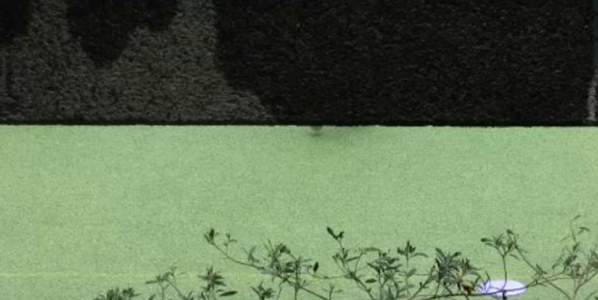
Renseiw – physical poetry, the occlusion, constraint. The careful choice of footage (variety and kind of motion within a narrowish range). Humanism: we don’t see faces, we don’t hear voices, we are amused but we recognise ourselves, youth and age &c.
Sanderson: The music found but could have been composed. The artfulness of placing it just thus. We will never know whether the way it ends with the action, the running off, taking place just after the repose of the final minor chord was deliberated or found. For me this placement implies a universe beyond the letterbox. It has a commonality with the treatment of time in many photographs and paintings – this is an instant, a fragment, but there was a before and an after.
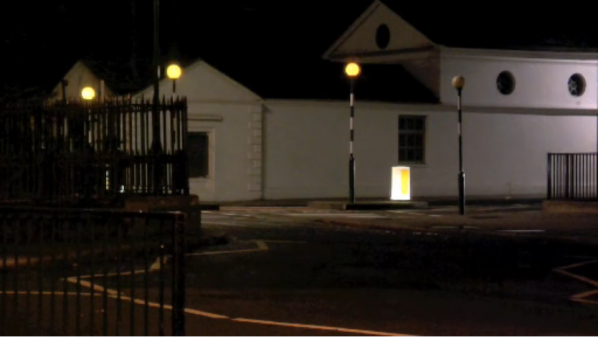
Note that there are four beacons. The sound (a numbers station, one can almost track the archaeology of impulse!) draws on the numbers 0-9, in German. It’s worth noting there is no obvious mathematical mapping between the pattern of the beacons and the numbers but the character in sound of the numbers is close to that of the beacons in light. Suggestion, metonymy.
This forces our attention very strongly on that area of the screen, with the concomitant effect that when we force our attention away it is as if our eyes have been suddenly opened. There is a world out there.
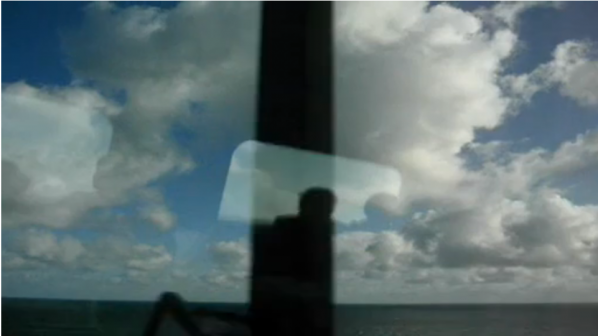
There is a hint of the transcendent in the title – how is this realized? Unless we know Denmark it takes a few moments to realize we are on a train rather than a boat or plane – we are clued into this by the close objects we clearly pass at speed and the reflection of passengers and seating in the windows. One speculates that the sound track is comprised of two elements – one the rhythmic and metallic pulse which somehow rhymes with the passing object (a kind of pseudo-diegesis) and the second an (Open University?) lecture on relativity.
Here, not exactly metonymy but something more fragile, delicate chains of suggestion and subtle resonance. No argument (to see an argument in any of this would be to commit a category error) but a complex and suggestive …um…thing. One should also note that this piece (in both its silent and extended versions) is extremely beautiful.
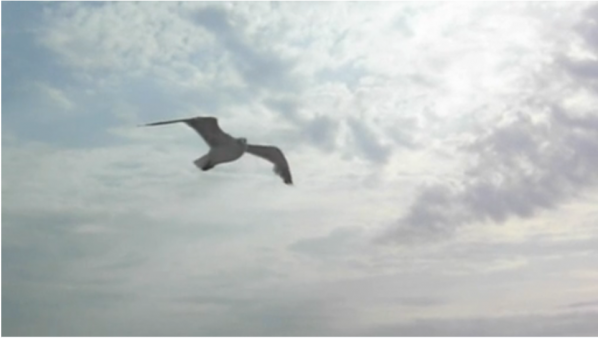
Let’s talk about the sensibility and taste of the makers. Renseiw offers something simple, a kind of tour de force – we perceive it as such although given the fixed camera constraint any virtuosity belongs to the seagull.
A banal seasoning of music would involve simply the seven note modal motif which hails, I’m almost certain, from American popular song of the 70s big country type – Wichita Linesman, you know the sort of thing. (I checked with Sanderson –it’s Bobby Goldsboro’s Summer The First Time) By itself it would be too perfect, too parallel to the floating bird (it seems to give way to a crashing wave sound in its looped form; interestingly the Goldsboro video I found on YouTube begins with a shot of gliding seagulls). With too much parallelism nothing extra arises but Sanderson spices the mixture by the addition of dialogue from what sounds like an American film of the forties or early fifties. It disrupts the idyll but only so as to make us more aware of it. There is a kind of musical V-effekt here (which could have been so badly handled and so isn’t). This is its ‘meaning’ – these things! Here, now!
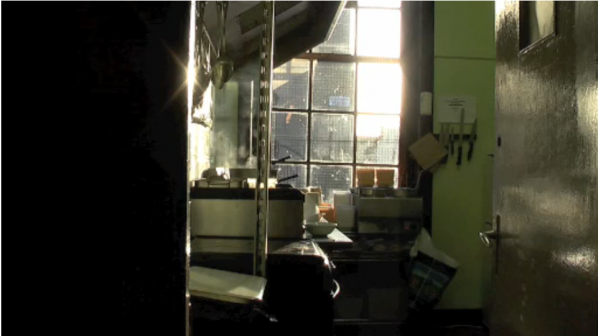
There is something of the dance about this. The music beautifully picks up both the nervous, sudden gestures of the cook but also suggests the process of cooking itself. The music has a funk component. One might say that it cooks.
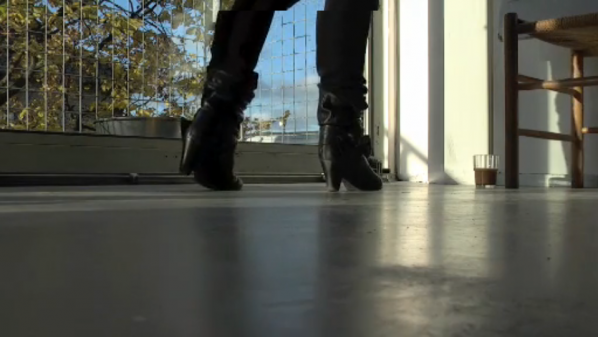
Visually – the low angle, the fragmented view of the body, the person here and not here. The focus on that person which permits and invites its opposite, in particular the framing of the sky and trees. The rhyme between the black-booted two legs of the woman and the black four legs of the dog. Their pas de deux. The music here subordinate, properly so. Ambient sounds, on the one hand, with odd vocal snatches on top. The strangeness doesn’t demand our attention because we are so focused on the visual.

Until the last moments we simply hear a fitting (slightly arch) accompaniment to the skating – we surmise that it is intended to pastiche the kind of accompaniments used in professional skating. At the last moment we realize this is exactly what it is, as the commentator’s voice breaks through. There is also a ‘skate’, ‘friction’ or ‘traveling’ noise which exactly underpins the final move we see, just before the humour of the juxtaposed text, which continues after the movie has gone to black, strikes us: “Delightful, skating of the highest quality” delivered in classic plummy BBC tones…

A hugely rich piece: visually there are a number of layers – the far left street background where distant people and vehicles process. The game of Petanque: – the actual participants (although glimpsed corporeally only twice: fleetingly at the very end and as one set of typical Renseiw-y legs) and the balls themselves (and the metonymic link between these and the planets). Thirdly, the large shadows. (And the apparent size of each of these layers allows for very clear visual interaction). Sound – the ‘light’, jokey, playful music. The University Challenge soundtrack, here unusually clearly cut up – questions – astronomy; replies – painters. A risk for Sanderson, but one that works.

A little detective work indicates the level of detailed truffling about by Sanderson – part of the sound, the text, is grabbed from a YouTube video about French patisseries in London and cut up considerably – in particularly yielding the repeated incantation “cream cakes, tarts, macarons” the latter word in a considerably overheated French accent following the sloaney first three, to deeply comic effect. Comic maybe but, repeated, as in a dream; this mood is reinforced by a rather beautiful waltz time solo piano loop of the opening line of The Associates’ Party Fears Too. Here’s another piece where the visuals, here also dreamy and wistful, set in a looking glass Copenhagen (and the disjuncture between the London-location heavy narrative and the visuals is simply ignored, taken for granted, part of the deal), support quite a complex sound assemblage. Utterly haunting and quite difficult to say exactly why.
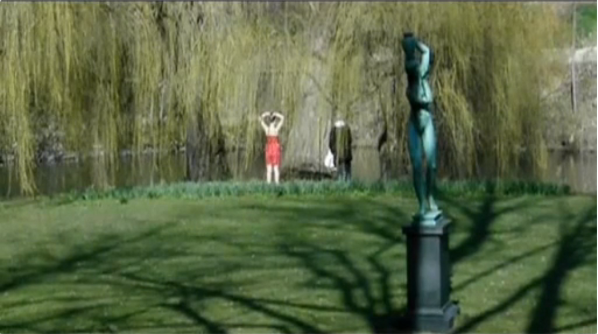
If one didn’t know it wasn’t one would surely assume this was carefully planned, and our knowledge it was not adds to our pleasure in it. Visually the rhyme between the woman and the near foreground statue is perfect – at one point she seems to mirror it exactly. Maybe she knows the area well and there is some unconscious mental echoing…we’ll never know. The other sharp visual pleasure is the smallness of the area of focussed distant activity, which again feels like a sort of directorial chutzpah, except, except…
Sanderson’s contribution is razor-sharp – the pseudo dialogue hits the mark precisely but doesn’t outstay it’s welcome – or at least there’s other stuff going on to detain us, not least the way the model’s preliminary warm-up shimmy becomes a perfect piece of minimal dance when set against the music.
Right of Passage/Speaking Voice
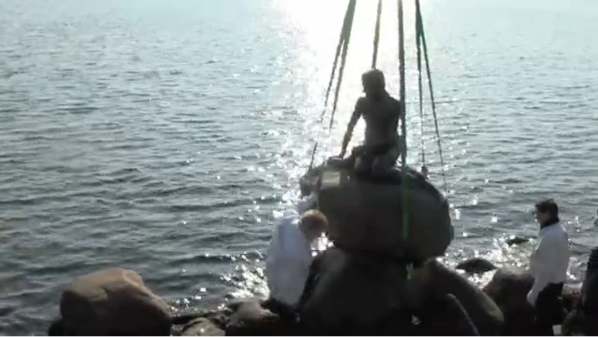
I wonder if when the content has it’s own ‘documentary’ interest, when the filming becomes a case of “Look at this remarkable thing not because of its intrinsic interest but because it happened”, the final result is somehow less engaging?
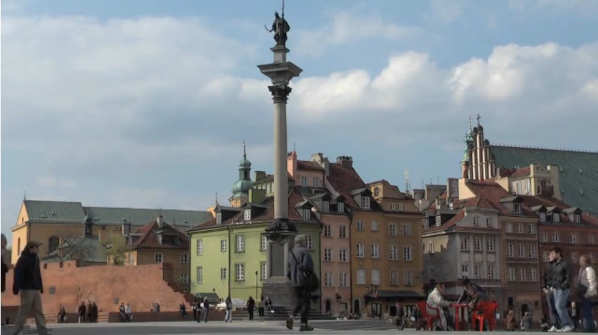
Again a dance related piece – the regular beat of the calling of the numbers one to eight sets up an aural grid against with which the implicit rhythms of the movement in, out and across frame interact in a sophisticated but subtle polyrhythm. Part two of the sound, with actual step instructions, ups the tension and the effect (especially the late entering ‘spinning’ man). Note how often in these pieces the sound fades out slightly later than the visuals, over Renseiw’s titles, thus emphasising its separate existence in an independent channel or dimension.
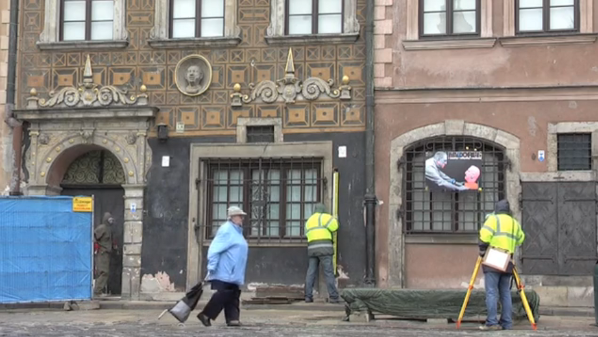
Beautiful found synthesis. Funny. Funny and truthful and touching.
The moving image is packed with incident at both different spatial levels and at different points in the piece. The Portsmouth Sinfonia version of Dance of the Sugar Plum Fairy underpins like a grid, as with Square Dance but in a more complex way, the visual rhythms of the film. Enough coincidence of rhythm to feel planned, enough ‘pull outwards’ to feel open… Again humour… Why does the Portsmouth Sinfonia track, in particular, work so well – atmosphere? the conjuring of a sort of raggedy clockwork ? – can we imagine in its place a more conventional rendering of the Tchaikovsky? Yes, but…
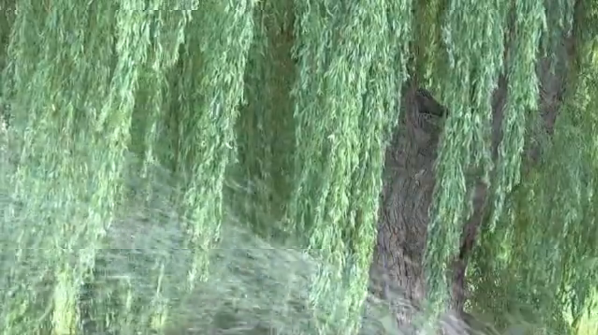
Prime example of Sanderson mind set – metonymy, suggestion – the trees are hair, the water appears exactly on cue (worked? Hmm – the audio appears to be cut to make the word ‘rinsing’ and the water jet coincide)
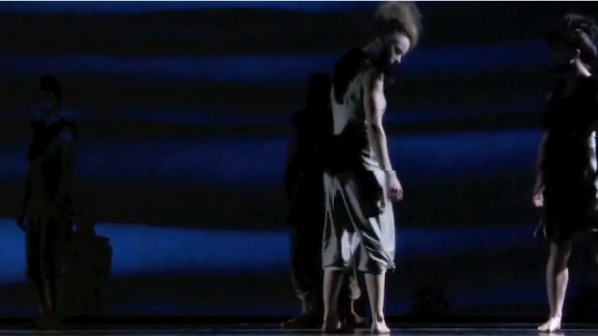
A one liner, but, given its place in the sequence, none the worse for it.
Brass band/Dancers.
*The pieces loosely divide into ones where either sound or vision predominate and some where they have equal roles.
* Not only does dance appear a couple of times explicitly as a subject but the spirit of dance pervades the project.
*The question of the success of individual pieces and of the sequence – a piece that seems less effective in isolation can well form an effective point of relaxation or reflection in the sequence as a whole…
*There are three pieces which, if one ‘re-removed’ the sound, would not strictly be Lumières – Check Out Art Fairs (speeded up), A Beauty Overblown (slowed down) & Sucked In (reversed). Sanderson performed the first two operations for reasons he felt the sound he used demanded. (To which one can only say: yes, this is right, a constraint is there for the sake of art, not art to be constrained.) Sucked In remains a mystery.
*The titles matter (note the re-titling of the composite works). They provide yet another dimension and illumination too.
*The prevailing tone is light, warm and playful. The darker side of life is largely absent, at least explicitly (though there are trails we could pick up to find it). Humour is everywhere. Only a philistine or fool would judge the work as a consequence to be less ambitious, significant or universal.
In September 2012, Italian tactical media artist Salvatore Iaconesi got the diagnosis. He had a glioma (glial cell brain cancer) of approximately 2×3 cm on the surface of his right hemisphere. Upon asking to see all the data relating to his condition, he found that all of the documents, MRI scans, and so on were in obscure not readily used formats. This meant that if one wanted to view the data, you needed specific or corporate software.
What he did then was remarkable. Iaconesi then hacked the formats of the documents and converted them into open-source ones that anyone could read could read with FLOSS (Free Libre Open Source) software. He then created the site, La Cura, where he presented his records as an “open source cure”. People around the world could access his records and then add their recommendations and findings about his condition, cancer, and so on. I begin this interview with Salvatore on September 15, 2012, and the La Cura website already has a rapidly expanding database of information at http://www.artisopensource.net/cure/.
Patrick Lichty: Salvatore, thank you for having this conversation. I remember that it was only a year and a half ago when we were shop-giving copies of the REFF tactical media book from your project, Fake Press in Rome. So, it was a shock when I learned of the glioma the day you launched the site. Could you talk a little about what is on the La Cura site?
Salvatore Iaconesi: Hi Patrick! Yes I do remember, too. And that is also a great explanation on what can be found at La Cura site: it is like one of our “fakes”, except that it is not a fake.
La Cura is about an alternative reality which I want to materialize on this planet, now. In this alternative reality, when someone has a serious disease, life does not end. One can be social, creative, and friendly. Work, art, design, fun and entertainment are possible for diseased people in this alternative reality, just as it is possible to reach out to find cures in any philosophy, time, strategy, culture or way one wishes. And consider that even technologies in this alternative reality are designed to enable and facilitate all this, actively promoting the freedom and autonomy of people.But, sadly, life is not like this alternative reality.
I wanted it to be my alternative reality, so I just did everything it took to bring that reality into the world. It’s like when you make an Augmented Reality application: you do a series of things to “materialize” some other things into ordinary reality. And then you have them, right there. So, La Cura is my personal Augmented Reality, in which, if I want to, I have all the tools and information I need to find a “cure” for my disease in one of multiple ways and strategies, which are medical, cultural, technological, emotional, artistic, political etc.
To achieve this, I have had to go through a series of obstacles:
The first is connected to language and information, as the first thing you notice at the hospital is that they are not really talking to you. Medical language is difficult and complex, and they rarely take action to make things more understandable to you. One of the testimonies I received in La Cura was that of a lady who has found herself in front of a doctor shouting at her: “You really think that I will explain to you why your thyroid has to be removed? It has to be removed! That’s it!”
This is really not “open”, in any sense. And, in more than one way, it is an explicit evidence of the approach which medicine has towards patients: they cease to be “humans” and become sets of parameters on a medical record subject to certain protocols and standards. When you are in the hospital, it’s often as if you’re not there. The only thing that matters is your data: blood pressure, heartbeat, magnetic resonance etc.
And the way in which information reflects this if handled in this context. Data formats may be, technically “open”, meaning that they are described somewhere but they’re really an explicit reflection that when you’re sick you “step out of society”. That data is usable and accessible only to “professionals” and to those people who have tools and skills to handle them.

I, as someone with considerable expertise with computers, have had some difficulties in opening them. Imagine someone else with less skill! Most people would not have been able to benefit from all the types of “cure” which I am currently accessing from a variety of sources and modalities. They would not have access to a “cure” that doesn’t end at a list of medicines and dosages, but spreads out into society.
To do that, I have had to hack into the information and convert it into really “open” data, using multiple formats that could be used by many kinds of people to do multiple things. In the format that the data was originally in, even if it was “technically open”, that data would have been seen only by “professional doctors” and, instead of being a “human being”, I would only have been a “patient”, or worse yet, a “case”.
PL: What do you want people to do with the information?
SI: Whatever they wish! Obviously! What is important in this case is that we must agree on what the “information” is… What I am publishing is my autonomous will to disclose my state of disease, including all data and medical information. I have my own purposes for this, but it does not necessarily mean that this purpose must/should be shared by others.
My personal purpose for this disclosure is to autonomously shape my own human condition. I have a disease but I am not a “diseased person”. I am a person. And, as such, I wish to create my personal “cure”, which has to do with my life, not with my disease. For what people know, I might even consider cancer as not being a “disease” at all! I might, for example, consider it an expression of the “cure”, such as if I adhered to Hamer’s theories. Which I don’t, or, at least, not in the sense that “I believe” in Hamer’s theories; I take them into consideration, but I don’t believe in them, just as I don’t believe in chemotherapy, in Aloe Vera, in Caisse Formula, in surgery, in shamanism, in healers, oncology or in any of these things. I take all of them into serious consideration, just as I seriously consider certain philosophies that say that we are made of energy, energy creates matter, and cancer is “matter” and so on. Therefore, cancer must be created by energy in some form. And so it could possibly be that I created cancer myself in a way or another.

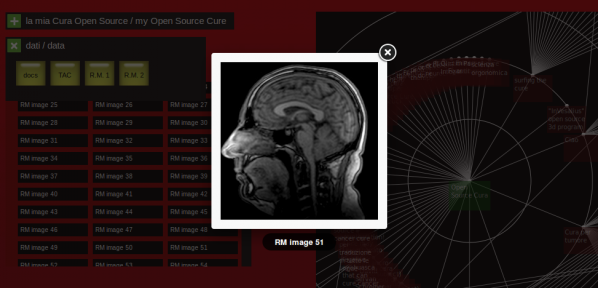
So in this sense, I think it is very important to be able to easily look at the images of my cancer and to say “hello” to them. It is important to turn them upside down, to edit them with GIMP, to make mosaics out of them, to speak to them, asking “hello?” What are you doing in there? Did I do something to cause you? Can I change something to make you/myself feel better?”
Both scientific and traditional evidence shows that art, positive emotions, laughter, reduced stress, and a good social life have great practical benefits to the human body, I want to seriously consider that part of my cure could be formed by receiving an image of my brain with a smiley face drawn across it over the tumor, or a picture of a friend of mine, or a video of a projection mapping done with Processing in which the images of my cancer cover a whole facade of a building.
And since I don’t want to believe, but I want to take all of these things into serious consideration, I cannot focus only on the “medical” approach (and the related information, and its formats). I need to access all of my information in multiple ways, and I wish that everyone could do the same (as, from my point of view, it’s part of my Cure). And, even if “technically open”, the format in which my medical records have been disclosed is not enough, because it is “open for professionals” and so the only thing I could do with it would be “show it to professionals”, missing out on all the other wonderful parts of the “cure” which are available in the world.
This for me, is an interesting starting point to think about what things such as “OpenData” could mean. This is far beyond the idea that some government can some data according to ways in which some “professionals” could grab it and, do something like make a visualization or an App out of them. Who knows? In this sense, instead, we would not be talking about “technology”, we would be talking about “humanity”.
In the end, this is exactly what I’d like people to do with the “information”. I want the world to take the fact that I decided to disclose the fact that I have a disease and that I want to actively search for a cure for from all of these perspectives. In the meantime, I want to reconsider what it means to be “diseased” in current times and what new conceptions of the word “cure”, “medicine” associated with my condition could mean.

PL: What has happened since you launched the La Cura site?
SI: Lots of things. People are contributing and participating in multiple ways. There are testimonies, art, poetry, suggestions, videos, performances. Many doctors have called in to propose their methodologies and technologies. I have had very interesting and profound discussions with people who are prepared to deal with very complex things every day of their lives. I’ve communicated with doctors who are perfectly open to the possibility of such a paradigm change for the word “cure”. Artists, designers, activists, are giving me wonderful parts of “cure”. Many “patients”, “ex-patients”, “relatives” and “friends” of “diseased people” are sharing their experiences, are opening discussions, are sharing the information I found on possible medical cures. And so many people want to talk to someone in new and different ways, becoming again, simply, humans. Journalists from all kinds of media have started to ask for interviews, texts and videos. We stopped that after a while, as we don’t wish to turn this into merely a “spectacle”. We only keep on working on this with journalists which we know we can trust and which we know will not transform what we say to produce their news.
PL: For your information, I had an MRI in 2009 here in the States, due to my doctors’ concerns of something similar (nothing was found), but when I asked for the data, I got a CD full of JPEG images. Were you surprised when you found out your records were in particular formats?
SI: They were not really in a proprietary format. Let’s call them “exotic formats for professionals”. And yes, I would have expected something which I could have shared easily (such as your JPEG images, and maybe some meta-data in some easy to use format such as XML, or even a spreadsheet). But this was a sort of paradox: an “open” format which is really hard to open and to use for something else other than putting the CD in an envelope and (snail)mailing to the next doctor.
PL: What do you think the line is between privacy and data oppression? Would that be when the patient is denied access to their rights to access the information and distribute it as they wish?
SI: We should all know this by now. Privacy is not a problem unless the “system” is made by lousy people. We have tools to protect ourselves and to promote ourselves, and these tools are dangerous only when who runs them is a lousy person. Privacy protection arises through education (understanding what is privacy and when/where/how/why would I want to protect it) and through the acquisition of decent ethics from the people and organizations which run the entire infrastructure through which all our digital data goes through. And obviously, and most importantly, our ethics is created by helping each other out in a P2P way, teaching each other what we know, what we discover and how we decided to handle it when we found out.
There is no single line between privacy and data oppression. Not one which everyone would agree on. We have the tools for each one of us to tune this line to our own wishes, according to what we want to do, what are our desires, what are our objectives etc. We “just” need more places (physical, digital, virtual, institutional, occasional…) in which to discuss and share our points of view, as every time this happens, many things are learned on all sides.
PL: Do you consider your site a form of radical tactical media intervention?
SI: I can now say “I have a radical tactical media intervention in my head”. Cancer is the new Black. The Cancer is the Message. And we could go on. I don’t know. I guess I could call it that. I also guess I could call it a performance. I guess I could call it life. I guess I could call it hacking or whatever. I will just call it La Cura.
PL: What has been the most inspirational information, art, or otherwise that has resulted from the launching of the La Cura site?
SI: The most enlightening thing that happened is the experience of talking about the same exact thing using dozens of different languages. I have spoken with neurosurgeons, shamans, nutritionists, pranotherapists, doctors, activists, macrobiotics, hippies, cyberpunks, punks, friends, relatives. Most of the time, I received incredibly good advice. When you look at that advice from different points of view, you start to understand that you are really talking about the same thing, but in different languages.
For example, two of the most important things which you deal with when you talk about cancer are the idea of creating alkaline environments in your body (because cancer cells cannot stand them) and the facts that anti-oxidants are a great tool in support of any type of therapy (because of the molecular reactions which are at the base of cancer).
Well, speaking of just these two, it occurred to me that multiple theories deal exactly with these two concepts. I have had an esoteric master describe my cancer as an invisible living being, and he suggested to drive it away using sulfur and Rosa Rubiginosa oil, in ways which turn them into two incredible anti-oxidants and creators of alkaline environments as well as powerful stimulants of the immune system. I have also spoken with nutritionists and macrobiotics communities and learned about their instructions on choosing food, cooking and eating, many of which are directed exactly to that: anti-oxidants and creating alkaline environments, but through food.
And when an oncologist explained us his therapy, that’s exactly what it was about: powerful anti-oxidants and alkaline environments. And on, and on and on. Aloe Vera, Caisse formula, fungus theory, chemiotherapy, Di Bella method, potassium ascorbate, ketogenic diets, etc: all highlight cancer cells in some way; create an environment around them which is as alkaline as possible; anti-oxidate them; activate the immune system as powerfully as possible so that the highlighted weakened, cancer cells can be more easily “convinced” at mutating back to a decent form or to commit suicide with the help of the immune system. Realizing this is an enlightening experience: it spans across thousands of years and also helps you make some choices (things stand out when they speak about different things!).
Everything else that is going on in La Cura is wonderful, but having realized this fact is just incredible and fascinating. You start imagining about all the other things we discuss about in our daily lives using multiple languages (energy, politics, emotions…) and start to wonder what would happen if you turned on this shared, P2P modality in those cases as well.
PL: How do you hope that others will benefit from the conversation that you are starting through La Cura?
SI: I don’t “hope” anything. I did this because I felt I needed to. When one talks about “revolution” dialogues start arriving at the point when one says, “Let’s burn everything down!” “Let’s destroy everything!” and so on.
We know we can’t do it. We can’t “destroy everything”. It’s not possible. What we can do is to create a reality as if everything already happened – as if the “revolution” already happened, as if the world had been burned down already, and rebuilt, just the way you like it. We can live life like this. It is a bit more than “seeing things”. But you do Augmented Reality, Patrick. You know what I mean. It’s a bit more than “writing”, it’s about creating worlds.
PL: As of this interview, what is the prognosis of your condition?
SI: Depends on what perspective you look at it from. From the medical point of view I have a low-grade glioma at intensity which is still undecided, between 1 and 2 (we will have to wait an histologic exam to know for sure). From the human point of view: I am fine! I have no apparent symptoms. I just need to be careful because if I find myself in stressful situations I could react by having an epileptic shock. So it is not advised that I drive or things like that. It’s the perfect excuse! 🙂
PL: Don’t you think it’s funny that the abbreviation for your name is “si”?
SI: Sì! Obviously 🙂
“Tweets in Space beams Twitter discussions from participants worldwide towards GJ667Cc – an exoplanet 22 light years away that might support extraterrestrial life. By engaging the millions of voices in the Twitterverse and dispatching them into the larger Universe, Tweets in Space activates a potent conversation about communication and life that traverses beyond our borders or understanding.”
Marc Garrett: Could you explain to our readers what ‘Tweets In Space’ is?
Scott Kildall and Nathaniel Stern: Tweets in Space is an art project — a networked performance event — which beams your Twitter messages to a nearby exoplanet that might support human-like, biological life. Anyone with an Internet connection can Tweet with the hashtag #tweetsinspace during the performance time, and their messages will be included in our shotgun blast to the stars. The performance is on September 21st, 20:30 – 21:00 Mountain Time (3:30 AM BST / London time).
MG: What was the motivation behind your current collaboration?
SK and NS: We found inspiration from various sources. First, in NASA’s Kepler mission, whose purpose is to discover planets in the “habitable” or “Goldilocks” zone. The project has found over 2000 exoplanets thus far, all of which are “not too hot, not too cold, but just right” for life as we know it. Scientists now estimate that there are at least 500 million planets like this in the Milky Way alone. Our conclusion: extraterrestrial life is almost certainly out there.
![The newly discovered planet is depicted in this artist's conception, showing the host star as part of a triple-star system. Image credit: Carnegie Institution / UCSC. [1]](http://www.furtherfield.org/wp-content/uploads/2012/09/planet_gj667cc.jpg)
“The latest discovery is at least 4.5 times bigger in size than Earth. Reportedly, the planet exists 22 lightyears away from Earth and it orbits its star every 28 days. The planet is known to lie, in what is being referred to as the star’s habitable zone. A habitable zone is a place where the existing conditions are just perfect for life sustenance. Astronomers, according to this report also suspect that the GJ667Cc may have been made out of earth-like rock, instead of gas.” [ibid]
Another source of great inspiration is how we use social media here on Earth. This is our second, large-scale, Internet-initiated collaboration. In 2009, we amplified the power structures and personalities on Wikipedia, and questioned how knowledge is formed on the world’s most-often used encyclopedia – and thus the web and world at large. Now, we are turning to the zeitgeist of information and ideas, feelings and facts, news and tidbits, on Twitter. The project focuses on and magnifies the supposed shallowness of 140-character messages, alongside the potential depth of all of them – what we say in online conversation, as a people.
We are directing our gaze, or rather tweets, via a high-powered radio telescope, towards GJ667Cc – one of the top candidates for alien life. It is part of a triple-star system, has a mass that is about 4 times that of Earth, and orbits a dwarf star at close range. GJ667Cc most certainly has liquid water, an essential component for the kind of life found on our own planet.
MG: Right from its early years when Jagadish Chandra Bose [2], pioneered the investigation of radio and microwave optics – science, technology and art have had strong crossovers. And it might be worth mentioning here that Bose was not only well versed as a physicist, biologist, botanist and archaeologist, he was also an early writer of science fiction. [3] Which, brings us back to ‘Tweets In Space’, wherein lies themes relating to science fiction, radio broadcasting (commercial, independent and pirate), wireless technology of the everyday via our computers, and ‘of course’ the Internet.
![J.C. Bose at the Royal Institution, London, 1897.[3]](http://www.furtherfield.org/wp-content/uploads/2012/09/JC-Bose-at-the-Royal-Institution-London-with-his-radio-equipment-The-date-is-1897.png)
But, what I want to pin down here is, where do you feel you fit in historically and artistically with other past and contemporary artists, whose creative art works also involved explorations through electromagnetic waves?
Scot Kildall: The work of JC Bose is incredible and what strikes me is that he eschewed the single-inventor capitalist lifestyle in favor of his own experiments. Isn’t this the narrative that artists (often) take and linked back in many ways to the open-source/sharing movement, rather than the litigious patent-based corporation? And it mirrors in many ways the reception of electromagnetic radiation as well. You can’t really “own” the airwaves. Anyone who is listening can pick up the signal. This comes back, as you point out, to the internet. Twitter is now, one of the vehicles, and, ironically entirely owned by a benevolent* corporation.
Nathaniel Stern: (Agreeing with Scott) and we can’t forget of course Nam June Paik, who played with naturally occurring and non-signal based electromagnetic fields to interfere with analogical signals (as well as the actual hardware) of tube televisions, and more. And of course, there have been other transmission artists, explored in depth by free103point9, among others. I think, like them and others, we are messing with the media, amplifying (figuratively and metaphorically) and intervening, pushing the boundaries of DIY and cultural ethico-aesthetic questions…
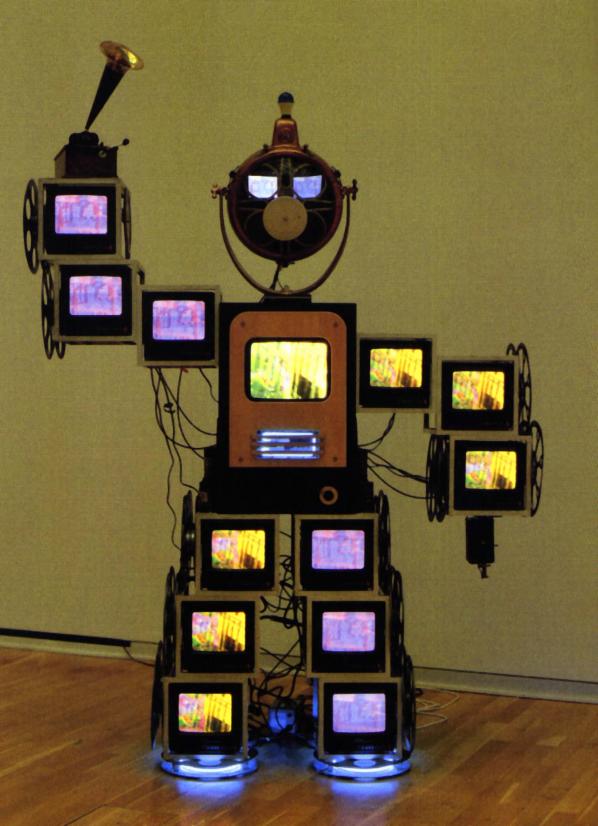
MG: What is especially interesting is that all the tweets submitted by the public are unfiltered. How important is it to you that people’s own messages are not censored when going into space?
SK and NS: Absolutely. Tweets in Space is by no means the first project to transmit cosmic messages with METI technologies (Messaging to Extraterrestrial Intelligence). Our fellow earthlings have sent songs by the Beatles, photos of ourselves shopping at supermarkets, images of national flags, and even a gold record inscribed with human forms – controversially, where the man has genitals and the woman doesn’t. These slices of hand-picked content exhibit what a select few believe to be important, but ignore, or willfully exclude, our varied and collective modes of thinking and being.
Tweets in Space is “one small step” with alien communications, in that it is open to anyone with an Internet connection. It thus represents millions of voices rather than a self-selected few. More than that, our project is a dialog. There have been, very recently, a small number of projects that similarly “democratize the universe” but none are like ours: uncurated, unmediated thoughts and responses from a cooperative public. We can speak, rebut, and conclude, and nothing is left out. Our transmission will contain the good, the bad, and the provocative, the proclamations, the responses, and the commentary, together, a “giant leap” for all of humankind – as well as our soon-to-be friends.
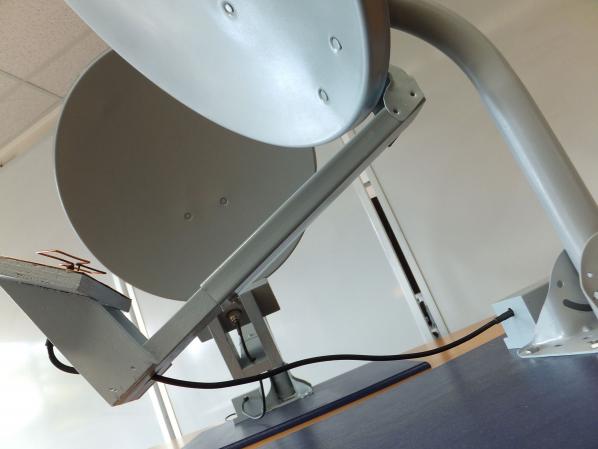
Furthermore, by limiting the event to a small window of only 30 minutes, we are encouraging all our participants to speak then respond, conversing with one another in real-time, through networked space. We are not just sending lone tweets, but beaming a part of the entire dialogical Twitterverse, as it creates and amplifies meaning. Tweets in Space is more than a “public performance” – it “performs a public.”
MG: Now, you will be transmitting real-time tweets toward the exoplanet GJ667Cc, which is 22 light-years away. How long will it all take to get there?
SK and NS: Well, first off, we’re collecting all of the tweets in real time, but only sending them out later in October. The main reason for this is that we have to wait for the planets to align – literally. We want line of sight with GJ667Cc from where our dish is. The added bonus of time, however, is that this will allow us to really flesh out how we send the messages in a bundle. We want to include a kind of Rosetta Stone, where we will not only send binary ASCII codes of text in our signal, but also analog images of the text itself. We additionally intend to choose the most frequently used nouns in all the tweets from our database, then give a kind of “key” for each. If “dog” is common, for example, we can transmit: 1. an analog image of a dog, like a composite signal from a VCR; 2. a text image of the word “dog” in the same format; and 3. the binary ASCII code for the word dog.
In terms of time/distance, when speaking in light years, these are the same thing. A light year is the distance light can travel in one year of Earth time (about 9.4605284 × 10 to the 15 meters). Since radio travels at the speed of light, a big dish on GJ667Cc will pick up the signal in 22 years. We should start listening for a response in 44 – though it may take them a while to get back to us…
MG: Will the code used for the project be open source, and if so, when and where can people expect to use it?
SK and NS: Yes it is! The most useful part of our code is the #collector, which saves real-time tweets to a database, that can then be used for live projections or web sites, or accessed and sorted later via all kinds of info. The problem is that it’s not really user friendly or out of the box – folks need a suped up server (VPN), and to plug into a few other open source wares. The main portion of the backend we used is actually already available at 140dev.com, and then we plugged that into Drupal, among other things. For now, we’re telling interested parties to contact our coder, Chris Butzen, if they want to use our implementation. And we hope to do public distribution on tweetsinspace.org if we are able to package it in a more usable format in the next 6 months.
MG: Are there any messages collected so far, grabbing your attention?
We’ve had thousands of tweets so far – even while just testing the ware in preparation for the performance. We’re anticipating a lot of participation! The tweets we’ve seen have ranged from variations on “hello [other] world” and “don’t eat us,” to political activism and negative commentary, to a whole surreal narrative of about 30 tweets per day over the last 3 months.
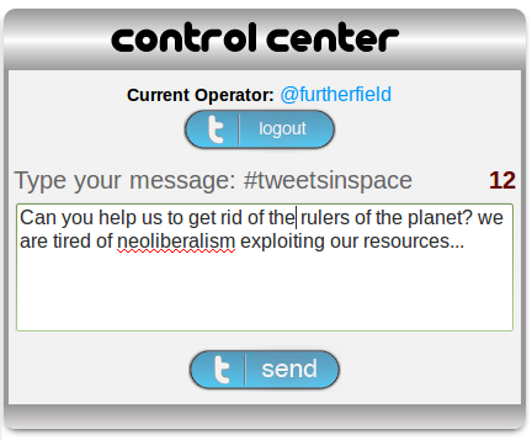
go to tweet aliens to add your own words…
Some of our favorite tweets have been those that question how to make our own world better. These speak to both the hope of space age-ike technology, as well as the hope in collective dialog – both of which our project tries to amplify. Such tweeters ask about the alien planet’s renewable energy sources, tax structures, education, art, and more.
We imagine the 30-minute performance will see a much more potent discussion about such things, and hope your readers will participate. The final transmission will be archived permanently on our site once we’ve prepared it for launch.
As part of the International Symposium on Electronic Art in New Mexico (ISEA2012). We will collect your tweets and transmit them into deep space via a high-powered radio messaging system. Our soon-to-be alien friends might receive unmediated thoughts and responses about politics, philosophy, pop culture, dinner, dancing cats and everything in between. By engaging the millions of voices in the Twitterverse and dispatching them into the larger Universe, Tweets in Space activates a potent conversation about communication and life that traverses beyond our borders or understanding. http://tweetsinspace.org/
AND THEY WILL BE SENT INTO DEEP SPACE!!!
Watch the stream LIVE here – http://tweetaliens.org/tweets/tweets.php
ALL WELCOME
A project by Sarah Waterson and dogs (and their human companions) of Finsbury Park.
+ Dog walks: every Wed-Sat, between Wed 17 October and Fri 30 November 2012
Laika’s Dérive invites Finsbury Park’s dogs and their human companions to record a walk in their local park and surrounding area. This walk offers a chance for interspecies communication and a sharing of knowledge that results in a collaborative mapping of each dog/human’s walk.
Each dog is kitted-out with a system that automatically photographs the dog’s favourite vistas and objects on location. The photographs are selected via the sniff and interest time of the dog, and are returned to the human as a series of the dog’s favourite snaps, and displayed on Laika’s Dérive website.
Laika’s Dérive is part of the WWW: World Wild Web exhibition at Furtherfield Gallery.
To take your dog for a dérive, please contact Furtherfield Gallery at info@furtherfield.org or phone 0208 802 2827.
Walks can be booked by one person/dog Wednesday to Saturday between 1-5pm, from Wednesday 17 October to Friday 30 November 2012, so book early to avoid disappointment!
The kit collection point for the walk is Furtherfield Gallery, McKenzie Pavilion, in Finsbury Park.
Event Coordinator: Laura Bottin
Event Producer: Alessandra Scapin
Laika’s Dérive/Dog’s DeTour (2011) is a new media locative data-mapping work by Sarah Waterson about interspecies communication, collaboration and knowledge. Community participants and their dogs use an electronic mapping system (custom iphone app-GPS, accelerometer, interval timed and geo tagged photography) within their local area. The data collected is incorporated into the online mapping and visualisation system (website) together with the participant narrative and profiles. This work engages cross species sensing to explore a psychogeography of place.
A sketch for this project was produced during the Kiss Club incubator residency at the Performance Space, Carriageworks, Sydney. Feb 2010.(A minisite for the project prototype can be found here).
The android mobile phone application and harness system was developed during a residency at Blast Theory, UK, June- July 2011.
More info at http://laikasderive.sarahwaterson.net
Sarah Waterson
Sarah has practised as a new media artist for the past twenty years. Her works include electronic installations, collaborations with performers, video and audio work, generative and software based artworks, VR environments and data visualisations and ecologies. Interdisciplinary and collaborative practice informs the development and ultimately the design of these artworks. Her current interests include data mapping, data ecologies and cross species collaboration.
Sarah’s recent interactive installations have included: Laika’s Dérive (Performance Space, Carriageworks 2011), 33ºSouth (collaboration with Juan Francisco Salazar, Casula Powerhouse 2009), a custom made data mapping system that juxtaposes the cities of Sydney (Australia) and Santiago (Chile) trope, a e-literature project developed for the Second Life environment (SWF 08, ongoing), subscapePROOF (collaboration with Kate Richards, Australian Centre for the Moving Image, Melbourne), and subscapeBALTIC (ISEA2004, Helsinki, Finland). Sarah is a senior lecturer in interactive media at the School of Humanities and Communication Arts, University of Western Sydney, Australia.
Furtherfield Gallery is supported by Haringey Council and Arts Council England
FURTHERFIELD GALLERY OPENING HOURS
WWW: World Wild Web exhibition
18 October – 01 December 2012
Open Thu-Fri 1-5pm, Sat 11-5pm
Opening Event: Saturday 13 October 2012, 1-4pmFree admission to exhibition and events
Location
Furtherfield Gallery
McKenzie Pavilion, Finsbury Park
London N4 2NQ
T: +44 (0)20 8802 2827
E: info@furtherfield.org
So ArtForum have launched a special September issue investigating the, lets say broader, relationship between new media, technology and visual art.*
Of worthy mention is the essay Digital Divide by the art world’s antagonistic critic of choice Claire Bishop, a writer whom a little under 8 years ago, deservedly poured critical scorn over the happy-go-lucky, merry-go-round creative malaise that was Bourriaud’s Relational Aesthetics and all of the proponents involved. Since then Bishop’s critical eye has focused on the acute political antagonistic relationships, within the dominant paradigms of participatory art and the concomitant authenticity of the social.
In Digital Divide, Bishop asks a different question, and its delivered even more bluntly than usual. Why has the mainstream art world, for the most part, refrained from directly responding to the ‘endlessly disposable, rapidly mutable ephemera of the virtual age and its impact on our consumption of relationships, images and communication.‘ This is not to say the practices of mainstream artists do not rely on digital media (in almost all cases, it now cannot function without it), but why hasn’t the shifting sands of digital culture been made explicit? In Bishop’s words;
“[H]ow many really confront the question of what it means to think, see, and filter affect through the digital? How many thematize this, or reflect deeply on how we experience, and are altered by, the digitization of our existence?”
Clearly, there are exceptions and she mentions three examples by art stars Frances Stark, Thomas Hirschhorn and Ryan Trecartin which flirt here and there with digital thematisation. Conversely artists who once specialised in digital art, Cory Arcangel, Miltos Manetas – to name two very famous examples – have previously broken out into the mainstream.
But for Bishop, there is of course, “an entire sphere of “new media” art, but this is a specialised field of its own: It rarely overlaps with the mainstream art world (commercial galleries, the Turner Prize, national pavilions at Venice)” – (one could add art fairs here). But nonetheless “these exceptions just point up the rule“. Bishop’s focus is on the mainstream and, moreover, she contends that “the digital is, on a deep level, the shaping condition—even the structuring paradox—that determines artistic decisions to work with certain formats and media. Its subterranean presence is comparable to the rise of television as the backdrop to art of the 1960s.” True enough, this structuring paradox is an implicit problem with the mainstream art world, but thats not the problem tout court.
From the responses I’ve read both in the article comments and in subsequent blog posts, a particular issue has been marked with Bishop’s statement that “new media” art is a specialised field. Whilst it doesn’t qualify as a dismissal, one could certainly suggest that Bishop is partly guilty of the same disavowal she throws at the mainstream art world when she relegates this sphere as an ‘exception’. In a blog-post response, Kyle Chayka makes a similar point; “Bishop understands that digital technology forms a seedbed for art as well as life, but fails to uncover the artists who are already critiquing that context.” I’m not a Lacanian, but maybe this is a symptom of something.
If mainstream art is ‘the rule’, (and I’m insinuating ‘the rule’ as anti-metaphor here) perhaps ‘the rule’ isn’t worth paying attention to, considering that the new media art exception is too much of a ‘specialisation’. In as much as one can only agree with Bishop’s call for mainstream art’s negotiation with digital thematisation, has she not missed the same aesthetic questions already posed and re-composed in this exceptional sphere? Why should the qualifier of the mainstream be such a factor of importance here? Why not cut off the need to reconcile digital thematisation with a set of historical, and commercially ideological principles which may not take kindly to the more ambitious and darker questions that the social and political arena of global digitalisation have thrown up. This is not to say that Bishop isn’t seeking those questions nor does she wish to reconcile those principles, but the specialised sphere of ‘new media art’ may quench the questions she herself raises.
Case in point: all Bishop would have needed to reference is something like the Dark Drives exhibition for the transmediale festival earlier this year; the tag line “uneasy energies in Technological Times” sums up her main descriptions of a digital epoch quite nicely. For instance, the artist group Art 404’s 5 Million Dollars 1 Terabyte, renders explicit one subset of the absurd, copyright, exploitative logic of proprietary software, by saving one terabyte’s worth of unlicensed software onto a single hard drive. Next to it was JK Keller’s idiosyncratic piece Realigning My Thoughts on Jasper Johns, which showed off a glitchy, abstract bastardisation of a Simpson’s episode Mom and Pop Art – regurgitating haggard mainstream perspectives. Crucially the success of the show was down to the implicitness of the exhibition’s technical triumphs – where technical jargon is often touted as a reason for the mainstream’s averted gaze. Whilst the viewer didn’t need to know the technics, but a richer understanding emerged should they have wanted to know.
There isn’t any need to clog up this article with a bottomless plethora of pieces from other equally important exhibtions and shows (I’m sure many others are better qualified in doing so); my point here, is that Bishop cannot relegate new media art as an exception to the rule, when the digitalisation of media is becoming the rule, which she herself explicitly admits. Choosing to focus on the failure of the mainstream in this arena gives the essay a healthy line of questioning, but in relegating an entire sphere which has – for some time – repeatedly dealt with these questions and more, it raises what is effectively a pointless query. To be fair to Bishop, she isn’t trying to force a fecund translation of new media with mainstream values, but looking for methods where digitalisation can instigate the change of those values.
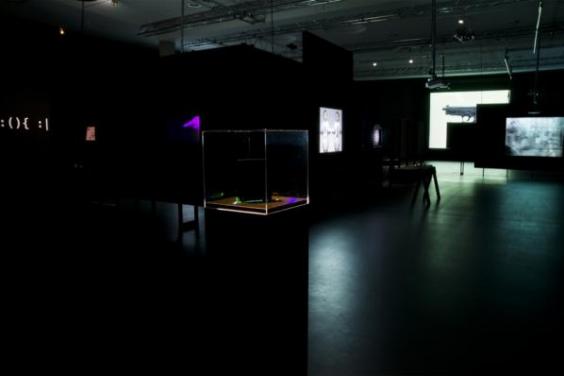
Granted, Dark Drives is one major show in a major Berlin new media festival – the top of a very extensive collection of disparate voices and influences – but it inadvertently highlights a salient thought. What if Bishop’s call to bridge the ‘Digital Divide’ was actually met by a new generation of artists thrust into the mainstream, where digital themes were translated into its own methods of commercial production? We’ve gotten over the myth that ‘virtual’ commodities are unmarketable, so it’s not as if I’m being negative for the sake of it. Where would this leave festivals like transmediale, or not-for-profit collectives like Furtherfield – how would they respond? It’s an uneasy question, one which for speculative purposes cannot be answered quickly at present, if at all.
In the throws of conjecture, there is perhaps another division at play here. Towards the end of her essay, Bishop makes a reference to the difference between the non-existent embrace of the digital medium today, and the rapid embrace of photography, film and video in the 60s and 70s.
“These formats, however, were image-based, and their relevance and challenge to visual art were self-evident. The digital, by contrast, is code, inherently alien to human perception. It is, at base, a linguistic model. Convert any .jpg file to .txt and you will find its ingredients: a garbled recipe of numbers and letters, meaningless to the average viewer. Is there a sense of fear underlying visual art’s disavowal of new media?”
This is a division which is even more striking; more aesthetically and philosophically significant in comparison to marketable rules and unmarketable exceptions. I think Bishop is really on to something when she chastises the hybrid solutions of old media nostalgia, evidently favoured by the market and contrasts it to the alien nature of code, but it’s not without problems.
Some may consider there to be nothing inherently alien about digital media; many artists, who also work as programmers and write, design and engineer artworks together with code without any recourse to an alien nature (however I vehemently disagree with the notion that code be solely reduced to human production, but it must be pointed out) Likewise, any 90s utopian reading of the ‘digital revolution’ is mired from the start, once you take into consideration, closed proprietary devices and services which falsify other meaningful alternatives (one only needs to trace the important work of the Telekommunisten art collective to realise how advanced these questions are, in what is supposed to be a specialised field).
If there is a fear underlying visual art’s disavowal of digitalisation, it’s not just a critical bemusement of code, but of the material which composes computational media; wires, LCD screens, motherboards, caches, firmware, sorting algorithms. Bishop’s call for mainstream contemporary art to be aware of its own conditions and circumstance is admirable, but unless art can actually get its hands dirty with the material processes of new media and more importantly the underlying computational conditions concerning the digital (because thats what it is), the project of explaining these circumstances will be quagmired from the start. It’s not enough to explain ‘our changing experience’ with computation, but to explain the experience of computation in itself.
But for now, lets keep the divide going, not least because antagonisms are fun (Bishop should know), but because the contemporary digital arts are not hindered with the burden of seeking the mainstream’s attention. They can get away with a lot more as a result. Digital or Computational art needs to be cheaper and nastier, as the artist’s tools of use are getting increasingly dirty with critical engagement and proflierfation of code (one cannot avoid mentioning Julian Oliver et al’s important project of critical engineering in this sense). Only then, can Bishop speak of a moment, where the “treasured assumptions” of mainstream art are brought to bear through the criticality of the digital.
——————
* Just to make it clear, I am aware that key terms in this article such as ‘new media’ ‘digitisation’, etc carry little to no relevance anymore, (I prefer computational to be more relevant myself), and they’re only used as a replying dialogue with Claire Bishop’s essay which relies on them throughout.
Charlie Gere is a Media Theory and History professor in the Lancaster Institute for Contemporary Arts, Lancaster University. Co-curator of FutureEverybody, the 2012 FutureEverything exhibition in Manchester. In 2007 he co-curated Feedback, a major exhibition on art responsive to instructions, input, or its environment, in Gijon, Northern Spain. He has given talks at many major arts institutions, including the Centre de Cultura Contemporània de Barcelona, the Architectural League in New York, Tate Britain, and Tate Modern. Gere’s new book, Community without Community in Digital Culture (Palgrave MacMillan, 2012), is out now.
Previous titles include: Digital Culture (Reaktion Books, 2002), Art, Time and Technology (Berg, 2006), Non-relational Aesthetics, with Michael Corris (Artwords, 2009). Gere was co-editor of White Heat Cold Logic (MIT Press, 2009), and Art Practice in a Digital Culture (Ashgate, 2010), as well as writing many papers on questions of technology, media and art. He is also co-editing with Robin Boast an anthology entitled Allegories of the Information Age (forthcoming).
Marc Garrett: Digital Culture was originally published in 2002, which happens to be the version I’ve had all these years. In 2008 it was republished, revised and expanded. Now the book has an extra chapter ‘Digital Culture in the Twenty-first Century’. Of course, we already know that digital technology and society has changed dramatically since 2002. So, what themes and historical contexts did you choose, as necessary to include in this new and last chapter?
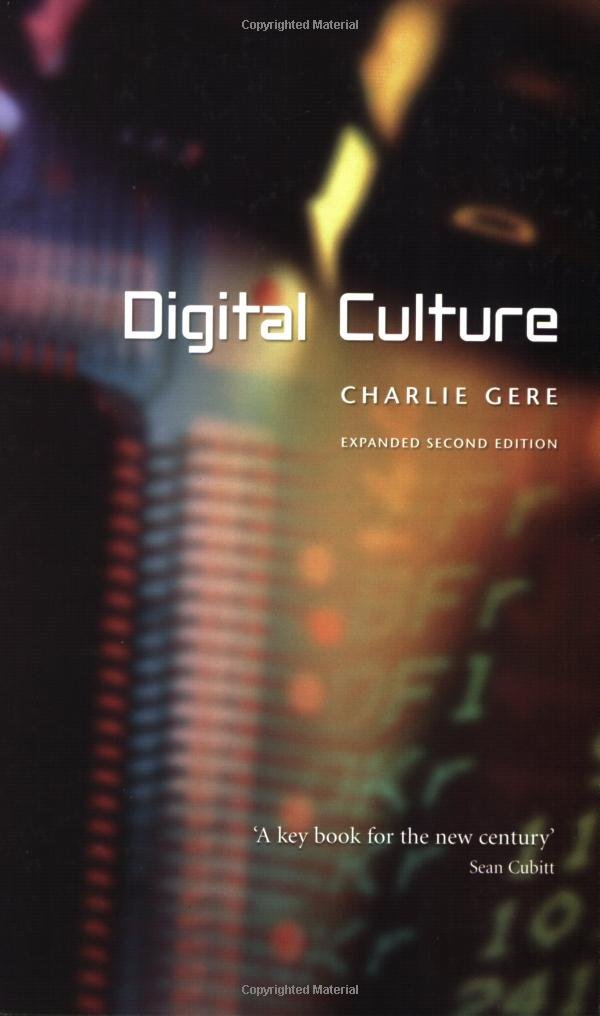
Charlie Gere: What happened after the first edition’s publication was of course, the rise of so-called Web 2:0, which was simply the greater exploitation of the reciprocal possibilities of the Web. I tried to reflect on how this reciprocity was visible beyond the Web itself and was becoming part of a more general culture of engagement and exchange, not that I share some of the more utopian visions of this phenomenon. Indeed, in my new book Community without Community in Digital Culture, I try to counter the, for me, more naive visions of community in relation to digital technology. I advocate a more ‘non-relational’ approach that does not deny the transformative effects of new media in terms of community but thinks of it more in terms of hospitality to the other.
MG: Many of the artists we have worked with are using new media to explore and critique the utopian assumptions you discuss: YOHA, IOCOSE, Liz Sterry, M.I.G (Men In Grey, Julian Oliver and Danja Vasiliev), Heath Bunting, Face to facebook (Paolo Cirio and Alessandro Ludovico), Annie Abrahams and more. Each of them work in a deeply relational way to intervene in the mythologies projected about digital technology; and, with a knowingly crtical eye of the technical limitations and the social controls at work when using networked technology. At different levels, all are producing work that ‘consciously’ incoporate relational contexts, in some way or another, this includes ideas and approaches with autonomy as part of their art, but not necessarily advocating technology as a singular, saving grace.
How do you view the role of this practice in the context of the wider corporate and state impact on the way technical cultures are evolving. How do you see the notion of hospitality working between the arts and these other more mainstream cultures?
CG: I greatly admire and like the work of the artists you mention and others doing similar things. For me they exemplify the complexity of the idea of hospitality. In general the Web is about exchange, whether that of money for goods, social links and relational exchanges in social networks, or the exchange of speech and dialogue in on-line fora. The work of these artists refuses this demand for exchange and profit within a restricted economy. Thus they are in a sense parasitical on the Web. The word ‘parasite’ comes from ‘para sitos’, meaning ‘beside the grain’, and refers to those animals that take advantage of grain stores to feed. They are the creatures to who must be offered hospitality, as a gift, without expectation of return, which means that while they are bound up with the technological systems that comprise the Web, they are not part of the restricted economy of exchange, profit, and return that is at the heart of capitalism, and to which everything else ends up being subordinated and subsumed. Thus they find an enclave away from total subsumption not outside of the market, but at its technical core.
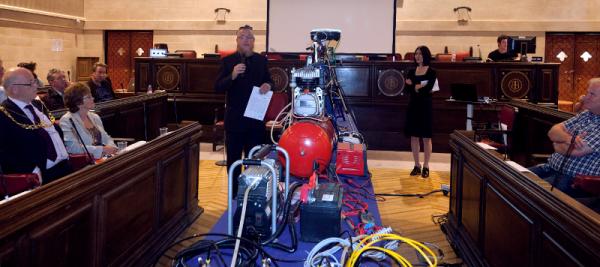

MG: Many are aware that technology and digital culture have changed the world we live in and appreciate their immediate effects on our everyday behaviours and situations. But there is a bigger story to tell, and history can offer us insightful glimpses, important clues and ways into this story about our relationship with technology and digital culture. One of the arguments outlined in your book ‘Digital Culture’ is that digital culture is neither radical, new nor technologically driven. With this in mind, which past developments do we need to acknowledge and be reminded of and why?
CG: For me the emergence of digital technology is part of a much longer story of abstraction, codification, quantification and mathematisation that can be traced back to numerous points in the history of the West, from Ancient Greece, to early Modernity to the rise of industrial capitalism. Here one might think of Heidegger’s use of ‘cybernetics’, a word we normally associate with post-war computing culture, to describe the technology and calculative enframing of modern society which he traces back to the Ancient Greeks and especially to Plato. I am not a particular advocate of digital technology, and while I appreciate its uses, I also think we must try to be aware of how it determines the way in which we think, and in which we conceive of the world. Above all we should not regard it as merely a conduit to an uncomplicated world simply out there, but rather the means by which a particular world comes to be for us. That said, this is very hard, given that in my view, and to adapt a well-known phrase from Derrida, il n’y a pas de hors-media, there’s no Archimedean point outside of our medial condition, from which we can understand it as from a god’s eye view. ‘Media determine our situation’ as Friedrich Kittler put it.
MG: In Digital Culture, you write about the composer John Cage and how he “has had the most profound influence on our digital culture”, and how his influence has opened up various different avenues of creative engagement. And, many of his ideas on interactivity and multi-media not only “have repercussions in the art world”, but also a strong influence on how computers are used as a medium. Which art movements in particular did he influence and what kind of legacy did he leave for others in relation to computers?
CG: Actually Cage’s influence on those using computers in the arts is probably less to do with what he himself did with such technology and more to do with his use of aleatory methods in many his different projects across many artforms. Also there is something about Cage’s own refusal of a normative Western subjectivity that is also consonant with aspects of our hyper-technologised existence with its emphasis on decentering the individual. Both the refusal of such subjectivity and the aleatory work together to produce a new model of the artist as conduit of contingent social forces rather than protean demi-urge or genius.
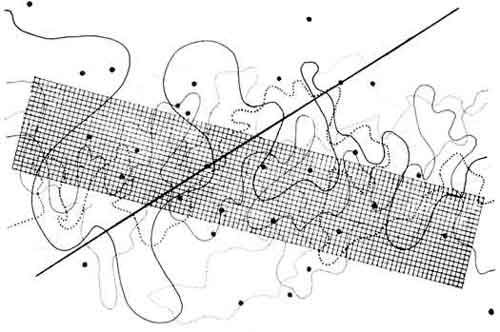
MG: Your new book ‘Community without Community in Digital Culture’, has come out at the same time as Geert Lovink’s ‘Networks Without A Cause: A critique of Social Media’. Lovink asks “How do we overcome this paradoxical era of hyped-up individualization that results precisely in the algorithmic outsourcing of the self? How do we determine significance outside of the celebrity paradigm and instead use intelligence to identify what’s at stake?” [1]
Where are your thoughts in regard to Lovink’s question, and does it relate to what you propose in terms of “hospitality to the other?”
CG: I haven’t read Geert’s book, yet at least… But I am highly sympathetic to what I take to be his position. My view is that the Web is part of a broader set of developments that apparently concern relationally, but actually emphasize the sovereign individual and autonomous subject of modernity, as well as promoting spectacular and image-bound forms of presentation and relation. The problem is that one alternative to this individualization is a kind of fascistic identification with the mass, in the form of fusion that negates the individual. A solution maybe to engage with the idea of the other in terms of difference, as both relational and separate, and yet also that which we depend on for our identity in a process of differentiation; thus the idea of hospitality as a reception of the other in difference.
MG: Community without Community in Digital Culture, is a curious title. It proposes contradictory meanings and these contradictions are clearly explained in the introduction. Although, the last sentence says “In this such technologies are part of the history of the death of God, the loss of an overarching metaphysical framework which would bind us together in some form of relation or communion. This can be understood in terms of contingency, which has the same root as contact.”
Could you unpack this last sentence for us, I’m especially interested in what contingency means to you?
CG: I owe my understanding of contingency to the work of philosopher Quentin Meillassoux, whose book After Finitude is causing a stir. Meillassoux is one of a small number of young philosophers sometimes grouped together under the name ‘speculative realism’, mostly because of their shared hostility to what they call ‘Kantian correlationism’, the idea that there can be no subject-independent knowledge of objects. Meillassoux follows the work of David Hume, who questioned the whole notion of causation; how one can demonstrate that, all things being equal, one thing will also cause another. For Hume causation is a question of inductive reasoning, in that we can posit causation on the grounds of previous experience. Meillassoux pushes the implications of Hume’s critique of causation to a point beyond Hume’s own solution, to propose the only necessity is that of contingency, and that everything could be otherwise, or what Meillassoux calls ‘hyperchaos’.
![Community without Community in Digital Culture [Hardcover]. Dr Charlie Gere. Palgrave Macmillan (2012) http://www.barnesandnoble.com/w/community-without-community-in-digital-culture-charlie-gere/1110025572 See on Amazon.](http://www.furtherfield.org/wp-content/uploads/2012/09/179510500.jpg)
I use his ideas to think through the implications of the ‘digital’. According to the Oxford English Dictionary ‘digital’ has a number of meanings, including ‘[O]f, pertaining to, using or being a digit’, meaning one of the ‘ten Arabic numerals from 0 to 9, especially when part of a number’, and also ‘designating a computer which operates on date in the form of digits or similar discrete data… Designating or pertaining to a recording in which the original signal is represented by the spacing between pulses rather than by a wave, to make it less susceptible to degradation’ (the word for data in the form of a wave being ‘analog’).
As well as referring to discrete data the dictionary also defines ‘digital’ as ‘[O]f or pertaining to a finger or fingers’ and [R]esembling a finger or the hollow impression made by one’, thus by extension the hand, grasping, touching and so on. Much of the book concerns deconstructing the ‘haptocentric’ implications of contact, and communication, especially in relation to the claims made for social networks, and to engage with what I understand as the relation between ‘contact’ and contingency’. ‘Contingency’ is derived from the Latin con + tangere, to touch. ‘Contingency’ enables us think through the implications of the term digital, by acknowledging both its relation to the hand and touch and also to the openness and blindness to the future that is a concomitant part of our digital culture after the death of God.
MG: What other subjects can we expect to read about in the publication?
CG: Touch in Aristotle and medieval theology, cave painting, mail art, Darwin and Dawkins, Luther Blissett, On Kawara, Frank Stella, Bartleby the Scrivener, Christianity – among other things… oh, and a lot of Derrida.
MG: If there is a message you’d like to send to the world, as it carries on regardless with its “permanent exposure of life, of all lives, to ‘all-out’ control […] thanks to computer technology” [2] (Virilio 2000), and it was printed on a banner, or on a billboard in the streets, what would it be?
I am reading Blanchot at the moment, so perhaps something like ‘the disaster has already happened’ (it’s suitably enigmatic to annoy people).
<———————————- The End (for now) ——————————>
Featured image: London Hackspace http://wiki.london.hackspace.org.uk/view/London_Hackspace
…the machine is always social before it is technical.
(Gilles Deleuze)
Though the term ‘lab’ conjures the image of a fairly sanitised environment optimised for scientific experiments and populated by people in white coats, media labs – centres for creative experimentation – are quite different. At their most basic, they are spaces – mostly physical but sometimes also virtual – for sharing technological resources like computers, software and even perhaps highly expensive 3D printers; offering training; and supporting the types of collaborative research that do not easily reside elsewhere. In the early-to-mid-1990s, partly propelled by the exciting possibilities of the internet and associated web browser technologies, groups began to coalesce, bent on developing access to the inherent potential of collective creativity. With the exuberant new dot.com businesses fuelling a ‘creative economy’, the Californian ‘cybercafé’ (surf the internet and slurp the coffee) was emulated in urban centres around the UK and in some cases artists were heavily involved. They saw the internet’s myriad ways of changing the way we make, think about and share art – not to mention its capacity for social empowerment – and wanted to harness these qualities quickly and effectively. With many practitioners coming from the spaces, practices and communities forged by the independent film and video movement, the phenomenon of the UK media lab was born. However, despite the importance of these spaces as the hybrid homes of the then emergent and now embedded creative activities that characterise today’s rich field of digital and media practices, their history and contribution to current lab environments has been little discussed outside a niche arena.
Early Media Labs
Two of the earliest UK media labs were Artec and Backspace (aka Bakspc), both based in London. Artec, which was established in 1990, was initially funded by Islington Council and ESF (the European Social Fund), but soon won additional support from Arts Council England. Conceived by Frank Boyd and Derek Richards, its focus from the outset was to deploy technology for social empowerment and, early on, it provided valuable professional training to the long-term unemployed. In this sense, it did not operate from within an arts context proper, but combined art and technology in the name of social integration. Creative projects were led by Graham Harwood, whose own artistic practice and his collective Mongrel were formed through associations at Artec.
Harwood and Mongrel’s practice is known widely for scrutinising social, political and cultural divisions through a framework of technology. A notable piece from this period was Rehearsal of Memory (1995), which took the collective experiences of staff and patients at Ashworth high security mental hospital, near Liverpool, and presented them as a unified and anonymous computer-based group portrait. Now available as a CD-ROM, the work strongly undermines the assumptions we make about mental health, blurring the line between those branded ‘normal’ or not. It is an excellent example of the way artists and media labs habitually combine creative activities with technology to give people a renewed agency. Around 1995, Peter Ride was brought on board to curate a stream of activity called Channel, which lead to further powerful artworks including Ubiquity (1997) by David Bickerstaff and Susan Collins’ In Conversation (1997).
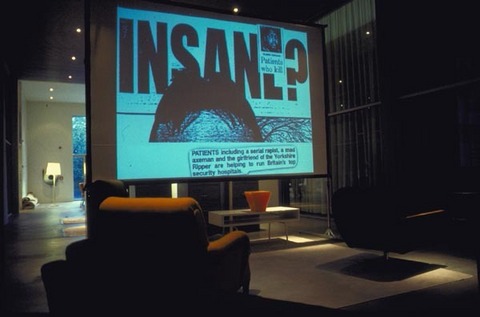
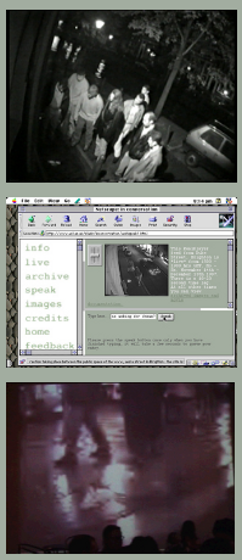
Without regular public funding, Backspace started out as an independent self-organised cybercafé. Initiated by James Stevens as a ‘soft space’ adjunct to his commercial web design business, Obsolete, it had a physical studio and lounge on Clink Street. People could drop in and use the web access and computer terminals in exchange for a nominal membership fee and commitment to maintain the space. What is notable about the Backspace model is how it attempted to foster a co-operatively managed resource. It exemplified a preoccupation amongst internet culture devotees with autonomy and new forms of governance, and struggled with all the contradictions of such ideals alongside the fact of its commercial parent entity. Obsolete shared its (at that time) capacious bandwidth. This gave people web hosting and streaming capabilities that would otherwise have been prohibitively expensive; allowed for the hosting of many artistic projects produced within the space itself; and facilitated many early streaming experiments with link-ups between other European media labs including as E-lab in Riga, Lativa and Ljudmila in Llubljana, Slovenia. Early attendees and co-facilitators of Backspace now list some central figures of the Digital and New Media art fields including: Matt Fuller, Simon Pope, Armin Medosch, Heath Bunting, Ruth Catlow, Pete Gomes, Manu Luksch and Thomson and Craighead – even Turner Prize winner Mark Lecky was a regular for a while.
Globally distributed discussion networks provided a discursive layer for these media labs, with early mailing lists such as Nettime, Rhizome and Syndicate forging international connections around technology, art and politics. Likewise, Mute (at first a newspaper, then a glossy magazine, now a web journal) provided regular critical commentary on burgeoning digital culture.
Foundationally different, Artec and Backspace were united by a belief in the importance of access to tools and training within a social context. In slightly differing ways, they put creative experimentation and social concerns at the centre of the agenda via technology. This was to become an important organisational strategy for this sector. Though both spaces have since closed, Stevens continues to build social and technological infrastructure as Deckspace, at Borough Hall, Greenwich. Without a physical space, Frank Boyd has evolved his media lab system into an industry-orientated programme called Crossover, which assembles creative professionals to workshop cross-platform ‘experiences’ from a variety of creative arenas including film TV and the computer games industry. Crossover is one of many peripatetic media lab models that privilege collaborative creative processes, although it is more goal-orientated than most as participants often pitch to a panel of industry commissioners.
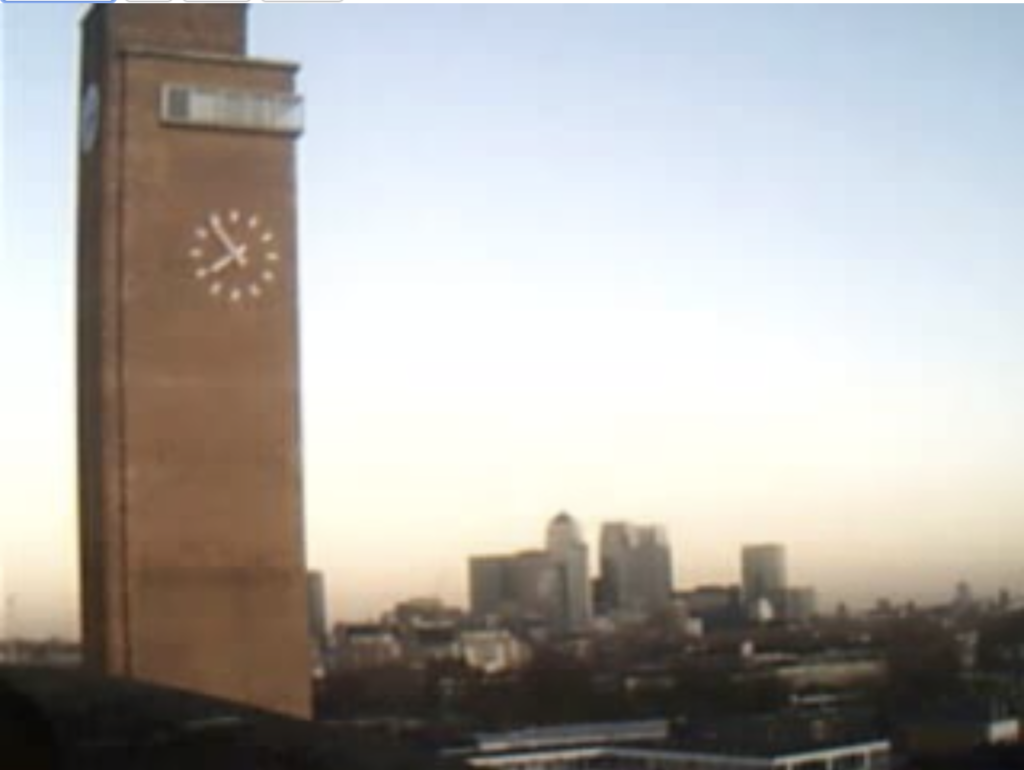
Process over Product
With less of an eye on industry and an abiding interest in the creative process itself, PVA MediaLab was formed in 1997 by artists Simon Poulter and Julie Penfold. In its first incarnation, it took up residence at Dartington College of the Arts, with funding from South West Arts. While there, artists were offered a well-equipped space in which to experiment with technology and develop ideas. In fact it is this developmental freedom that forms another core operational component of the media lab. Rather than asking artists to arrive with pre-formulated projects, or expecting them to see a piece through from start to finish, media labs have consistently placed value on self-determined exploration. PVA helps artists to manufacture methodologies rather than final artworks, fully designed products or content packages. They have also led the way in assisting other media labs to produce a similar system, through their Labculture programme. Highly itinerant, the Labculture model adjusts itself to host organisations, like Vivid, in Birmingham, so they can learn how to set and achieve goals while building the sorts of lasting partnerships that will sustain future activity.
This shared or Open Source way of working integral to media lab culture is also exemplified by GYOML (Grow Your Own Media Lab). A collaborative project between media labs Folly, Access Space and the Polytechnic, GYOML was designed to help generate more media lab initiatives. It has included: ‘GYOML in a Kitchen’, a sound recording and editing workshop by Steve Symons (Lancaster); ‘GYOML in a Van’, which staged an introductory workshop in media-lab culture for community group leaders (Lancaster); a game-centred ‘GYOML for teenagers’ (Rochdale); and ‘GYOML at the Canteen’, catering to film-makers and professional artists with an interest in open source (Barrow-in-Furness). Legacies of this project include the Digital Artists Handbook, an impressive guide to Open Source tools and techniques and ‘Grow Your Own Media Lab (the graphic novel)’, a set of inspiring case studies. Folly continue to work very much in this manner, forming essential infrastructural relationships as and where needed and guiding others through the adoption of free software.
Another example of this attention to operation and openess comes from GIST Lab, in Sheffield, which energises community-based projects through a space that hosts meetings and workshops. Even without a dedicated tech suite, their knowledge-exchange is a short-cut to all manner of original cross-over work, and they have supported yet another project that literally and metaphorically recreates aspects of the media lab model. 3D printing (or rapid prototyping) is increasingly popular in producing anything from car parts to jewellery, by layering materials like plastic into finished three-dimensional objects. RepRap, however, is able to print the spare parts it needs to be built while it is still itself under construction. Just like media labs, this self-replicating 3D Printer is all about sharing access to a successful system.
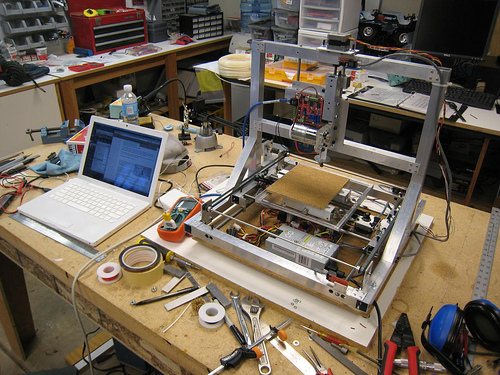
If media labs are not driven by material production, neither are they all about technology. Arising from the work of the art group, Redundant Technology Initiative, Access Space in Sheffield established its media lab through the use of free and recycled technology and learning. Given our cultural predisposition for wanting the latest, fastest equipment and our reprehensible dumping of perfectly serviceable technology, abundant hardware is sourced from all manner of locations. The latest Free and Open Source software is installed on the hardware where expensive proprietary software once lay and the media lab space, complete with this equipment, is opened to the public five days a week. The one proviso placed on this access – continuing the recycling theme – is that once a media lab participant has learnt how to do something, they should pass this knowledge on. As evidence of the success of this system Access Space boasts impressive outreach capacity: more than a thousand regular visitors, of which only about thirty-five percent are university educated, and over half are unemployed, and they habitually work with people experiencing disabilities, learning disorders, poor health, homelessness or other measures of exclusion.

One of the projects that clearly shows what they do is Zero Dollar Laptop, a collaboration with the Furtherfield organisation and community. Through a series of workshops, homeless participants are given the ability to use and maintain a free laptop complete with free software in self-led creative projects. It is this model of learning through self-directed creativity that arises again and again in media labs because it provides demonstrable results in helping people acquire and retain the skills they need. Without ‘bells and whistles’ new technology, Access Space emphasise the importance of ideas over technology and demystify all manner of computer-based skills. SPACE Studio’s MediaLab is also an excellent example of a lab working at a range of levels to offer beneficial specialised training. They teach software packages at a professional level to film makers, artists and a range of media industry workers, as well as offering film-making and media training for NEET (Not in Education, Employment or Training) teenagers in the local area. There are also a number of DIY Technology workshops including those regularly hosted by MzTEK who have expanded their operation as a result of their connections with SPACE. MzTEK are all about encouraging women to build technical skills and enter the new media sector. Growing from a small group to wide and supportive network they answer underdeveloped areas of knowledge. In addition to this, SPACE’s PERMACULTURES residency series has, to date, hosted eight residencies supporting over eleven artists, helping them explore technology and go on to show in a range of spaces.


The media lab also plugs an important gap in the art gallery and museum network. Digital and New Media arts are distinctive for collapsing boundaries between the place of production and exhibition. As a result, few existing art spaces have been in a position to fully represent it. Media labs, as well as community websites like Furtherfield and Rhizome, international festivals including ISEA and Transmediale and curatorial resources like CRUMB (the Curatorial Resource for Upstart Media Bliss) have imaginatively responded to this situation. Media labs in particular have been very successful in fostering relationships between artists and galleries. They have helped to translate not only the ideas expressed by this type of art – which can require much additional contextualisation – but also their physical installation in spaces not designed for this new breed of work.
For example, Folly recently collaborated on an experiment in the exhibition and acquisition of New Media art with the Harris Museum and Art Gallery. Entitled Current, the project saw expert panels first select works to be exhibited at the gallery (in Spring 2011) and then choose one to enter the permanent collection. Not only did this give the gallery the chance to add a timely contemporary work to their collection but it formed a useful public case study showing other institutions how they might engage with emergent art forms in various new media.
Media labs greatly contribute to the collaborative working methods the creative sector now thrives upon. Cross or interdisciplinary partnerships involve people from very different industries or working cultures combining and even reinventing the way they work in order to unearth all manner of new practices and products. Many universities, having born witness to a boom in research which straddles different academic subjects and industry sectors (due in some part to government funding imperatives around ‘knowledge transfer’), have established their own media labs. A relatively early example of this was i-DAT (the Institute of Digital Art and Technology) at the School of Computing, Communication and Electronics at the University of Plymouth. A large project with many interrelated strands is their op-sys (operating systems) network of research into architectural, biological, social and economic data and how it can be made publicly available and useful. The University of Nottingham has the Mixed Reality Lab, which was established in 1999 with £1.2 million in funding from the JREI (Joint Research and Equipment Initiative) programme as well as ongoing grants and investments. Run by Steve Benford, it hosts around eighteen PhD students providing resources for researchers and post-graduates working in areas that intersect its host department, the School of Computer Science, and associated training facility, the Horizon Doctoral Training Centre. It maintains a number of diverse projects, some of which have won prestigious awards and award nominations including Can You See Me Now, a collaboration with Blast Theory. The CoDE (Cultures of the Digital Economy) Institute at Anglia Ruskin University in Cambridge has a digital performance laboratory that focuses on sound-based work. Culture Lab is Newcastle University’s bespoke unit of media-lab-style flexibility, where artists work experimentally and across disciplines, and Sandbox, a similar resource, is located at the University of Central Lancashire. Another approach for universities is to partner with existing media labs. Pervasive Media Studio, a Bristol-located media lab, was set up by Watershed, a cross-artform production organisation, HP Labs and the South West Regional Development Agency. They have a partnership which runs for three years with the University of West England’s Digital Cultures Research Centre and work in a number of different ways including offering Graduate and New Talent residencies for those just starting out in their careers. The Pervasive Media Studio has helped to establish events like Igfest, the Interesting Games festival, held annually in Bristol, as well as development platforms such as Theatre Sandbox, which helps theatre makers introduce technology to their practice. They also support artists, including: AntiVJ, Duncan Speakman and Luke Jerram.
As we have seen, some labs have been nomadic or temporary while others have evolved into new incarnations. A media lab might be part of an array of dependencies with institutional responsibilities i.e. Folly, Isis Arts, Lighthouse, Pavilion, Pervasive Media Lab, PVA, Vivid and more, all of which regularly produce an abundance of quality experimentation in Digital art and culture. While new incarnations of the media lab may respond to three distinct but related phenomena: the rapidly evolving technology sector; the transient networks of geeks and digital experimenters; the need for sustainable models for innovation in industry. MadLab, in Manchester, provides space and facilitates meetings and workshops for ‘geeks, artists, designers, illustrators, hackers, tinkerers, innovators and idle dreamers’. Their ‘drop in’ events, commonly known as ‘Hacklabs’ (for example *Hack to the Future* during the Edinburgh International Science Festival), give people instant hands-on experience with all sorts of code and kit. Although hacking is still seen as a specialist and somewhat murky activity, the term is being increasingly decoupled from its conventional criminal associations and made accessible to mainstream arts territory. In January 2011 the Royal Opera House facilitated a ‘Culture Hack Day’, bringing cultural organisations such as the Crafts Council and UK Film Council together with software developers and creative technologists to usefully open up and share data. Other HackLabs may have less of an arts focus, but do have impressive resources built using the open membership model (pioneered by the likes of Backspace). The London Hackspace boasts a laser cutter, digital oscilloscope and kiln, all donated or collectively purchased.
Scattered through many of our city centres are office/studio-based working spaces which cater to the creative industries by offering flexible working environments and abundant networking and training opportunities. The Hub, in London’s Islington and Kings Cross areas (with up to thirty further Hubs in cities across the globe), gives fee-paying members access to facilities and a way of working orientated towards connecting people from across the network in cost-effective innovation. These spaces are indicative of the emphasis placed on the creative economy as the big hope for economic renewal driven by small entrepreneurs grabbing and shaping the opportunities in technology, entertainment and design.
Inspirational before Institutional
Looking briefly at some of the ways media labs have operated since the 1990s shows them as uniquely fertile spaces for all manner of shared expertise and creative innovation. They have made a fundamental contribution to Open Source culture. Working as openly and collaboratively as possible, participants have found ways of sharing process and product, while an interdisciplinary nature has revealed a plethora of creative possibilities. Fulfilling a difficult remit by offering a home for many of the emergent artistic practices currently transforming artistic activity, they have led us away from ‘art for art’s sake’ and towards work which has demonstrable meaning and lasting social and economic benefit. Large institutions might be extremely well-versed in mounting financially advantageous blockbuster exhibitions, but the beauty of media labs derives from their ability to develop and disseminate the socially-transformative systems that have already and will continue to shape the future of the arts.
A big thank you to everyone who contributed to this research despite their incredibly busy schedules and a special shout to: Simon Poulter for pulling over his car, Clive Gillman for kindly kicking things off, Sarah Cook for an innovative approach to note sharing and Peter Ride for not taking a lunch break.
You can find Charlotte’s original article on Collaboration and Freedom – The World of Free and Open Source Art http://p2pfoundation.net/World_of_Free_and_Open_Source_Art
As part of the Furtherfield collection commissioned by Arts Council England for Thinking Digital. 2011
Featured image: Still from performance of Structure M-11
You would measure time the measureless and the immeasurable.
You would adjust your conduct and even direct the course of your spirit according to hours and seasons. Of time you would make a stream upon whose bank you would sit and watch its flowing. – Kahlil Gibran
Algorithms only really come alive in the temporal time-frames that they move through. Their existence depends on being able to move freely along time’s arrow, unfolding and expanding out in to the universe, or reversing themselves backwards into a finite point. Every form and structure that the universe creates is the result of a single step along that pathway and we’re only ever observing it at a single moment. Those geological steps can take millions of years to unfold and we can only ever really look back and see the steps that happened before we chose to observe them. Computational algorithms break down that slow dripping of nature’s possibilities and allow us to become time-travellers, stepping into any point that we choose to.
Paul Prudence is a performer and installation artist who works with computational, algorithmic and generative environments, developing ways to reflect his interest in patterns, nature and the mid-way point between scientific research and artistic pursuit. The outputs from this research are near cinematic, audio-visual events. Prudence’s creative work, and his blog, Dataisnature (kept since October 2004), explores a number of creative potentials as well as documentating the creative and scientific research work of others that he finds of interest. As the blog’s bio states:
“Dataisnature’s interest in process is far and wide reaching – it may also include posts on visual music, parametric architecture, computational archaeology, psychogeography and cartography, experimental musical notational, utopian constructs, visionary divination systems and counter cultural systems.”
Paul himself feels Dataisnature, and his other blogs, are by their very nature ordering systems, trying to create some kind of structure on information. “Yes, it’s true [that they are ordering systems], but the ordering is sometimes a little bit oblique. I am not interested in ordering systems such as categories or tags, for example, as each blog post has the potential to generate many of its own categories.”
The blog and perhaps all blogs, shouldn’t be an end in themselves then? Should they be a starting point for a deeper investigation? “Well, I’m more interested in substrate and sedimentary structuring – specific fields existing in layers and sometimes overlapping and interacting rhizomatically.”
Blogging for Paul and many bloggers who don’t operate within the ‘monetization of blogging’ sphere that has grown up in the past few years could almost be considered a documentation and ordering process for the creative process. The process and interaction between the theory and the blog as textual artefact becomes quite complex. As does the theory and creative output of the blogger. Paul would argue that this isn’t always something that can be even as straightforward as theory to practice though.
“The posts at Dataisnature are not confined to theoretical relationships between art and science projects, but also take into account metaphorical ones. I never wanted the posts to be so pinned down that they disable the opportunity to make entirely new connections at any level.”
So the chance to see what happens inbetween strict disciplines and an openness to the potentials that may arise out of relaxing the barriers? Shouldn’t that be the way that everything else that is ‘not of academia’ operates anyway? And for that matter, outside of the possibilities of arts/science/research funding.
“I applied the term ‘recreational research’ to Dataisnature in its early days,” Paul explains. “This is still to some degree important – the notion that research doesn’t have to be tied down by the prospect of peer review or academic formatting. This kind of interdisciplinary research can be highly addictive – its the new sport of the internet age. It can generate blogs that become chaotic repositories of interconnectedness – linearity becomes infected with cut-up and collage. In my own mind I have an idea of what Dataisnature is trying to say but I get people approaching me with completely different, and amusing theories of what they believe the blog is about.”
In digital arts (or let us call it digital creativity, to avoid the complexity of art versus design versus technology) the breakdown between the equipment used and the research of the creator has become almost at times indistinguishable. A painter is often only one step away from being a chemist, a sculptor closer to an engineer than a painter. The tools used define and form some of the output. Digital creativity only makes this more implicit. So when using technologies and researching, the scientist and the creative often walk hand-in-hand towards the finished artefact. As Prudence says: “Collaboration among artists and scientists exists through time as well as space.”
“A great part of an artist’s task is to be a researcher. It’s important to remember that any idea you have has already been tackled in the past with a different (want to avoid the term lesser) technology.”
The blogging process offers a chance to gather information and allow some of the artist’s own influences and present interests to manifest themselves into a rough-hewn structure. “For me, blogging facilitates a medium for an archaeology of aesthetics, technology and conceptuality. All this fragmented information is gathered then reconstituted, and fed back into the artistic practice. Of course my personal work blog is more about supplying supplementary material to anyone interested in my work.”
Taking an arguably typical example of Paul Prudence’s work, for example Structure-M11, the sense of a becoming and developing is in the way it attempts to reconnect with what (for want of a better phrase) could possibly be called our lost industrial heritage.
Looking through Prudence’s flickr stream documenting the research trip, there are numerous industrial landscapes empty of human life, where only the machines have been allowed to remain, static and poised, ready to begin work again. If only someone would employ them. These machines perform simple tasks, but they do it elegantly, time after time after time, never complaining and never asking for any recognition. Perhaps that’s why it is so easy to abandon them? And these machines are not only a monument to the way we discard unwanted technologies, they also reflect the changing fortunes of the town as it has moved from production-based economy to one centred mainly on tourism and smaller businesses. It is fitting in a way that the soundscapes and visuals that Prudence has brought to life from these landscapes have such a contemporary, sci-fi industrial feel to them. As though the clean, slick lines and geometric perfection had emerged, phoenix-like, from the unbearably hot, oil soaked environments of the factories and the monotonous repetition of working within them.

The soundtrack that accompanies the performance was made from field recordings at the site. From these, Prudence generated real-time visuals that reflected some of the sonic activations and echoes throughout these landscapes. The final pieces look like ‘robotic origami contraptions.’ The steady throb and crash of the audio reflects the repetition of the machine and its operator’s lives while also suggesting some of the dehumanising effects working in a factory can have on a person. There’s also the beauty, of course, if you shift your own perception a few degrees away from the machines, there is always a window looking out at a natural landscape. And those same slick, geometric shapes of the machines begin to reflect some of the elegance of the world of nature. Nature, like humanity, loves to repeat itself infinitely until something breaks that pattern. Isn’t that a fundamental part of mutation and evolution? Structure-M11 seems to be constantly mutating and growing new rhizomes, but nothing complete ever emerges. Paul Prudence’s work isn’t here to save us from the monotony of the machines though, its task is to remind us of how important nature is to our lives, no matter how entangled in the machine those lives may begin to feel.
Prudence’s interest in the natural spaces emerges from his own theory-based interests. As he says, “My interest in generative systems and procedural-based methodologies in art lead to a way of seeing landscape formations and geological artefacts as a result of ‘earth-based’ computations.”
“The pattern recognition part of the brain draws analogies between spatio-temporal systems found in nature and ones found in computational domains – they share similar patterns. I began to think of the forms found in natural spaces more and more in terms of the aeolian protocols, metamorphic algorithms and hydrodynamic computations that created them.”
“Some of these pan-computational routines run their course over millions of years, some are over in a microsecond, yet the patterns generated can be amazingly similar. I like the fact that when I go walking in mountains my mind switches to [the] subject of process, computation and doWhile() loops inspired by the geological formations I come across.”
This connection and flowing from one space to the other, gives the viewer the feeling that they recognise the shapes and patterns from something they’ve seen before. Attending a performance of Prudence’s work might make you feel as though you’ve been to one already. But it’s just the reconnection of interconnection that you’d be experiencing. And that’s always a good place to start, when experiencing any artwork, isn’t it?
21 Sept 2012
Scopitone Festival, Nantes, France.
24 Sept 2012
Immerge @ SHO-ZYG, London
17-25 October 2012
VVVV Visual Music Workshops at at Playgrounds 2012, National Taipei University of Art, Taipei & National Museum of Art, Taichung, Taiwan
Prank sombody with the fake Windows 10 upgrade screen which never ends. Open the site in a web browser and go full screen with the F11 key.